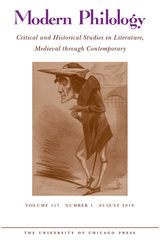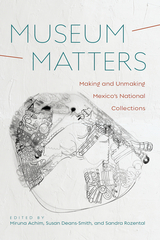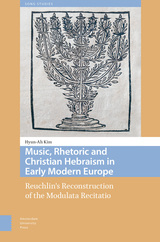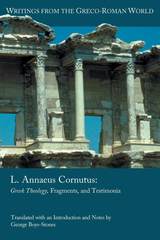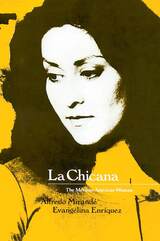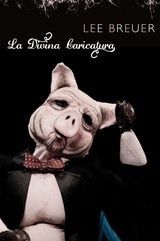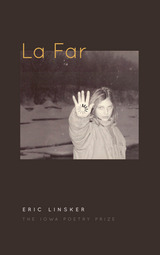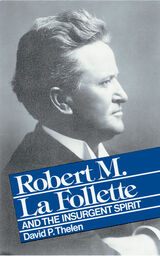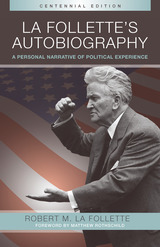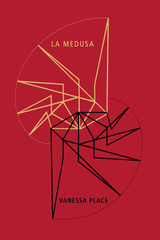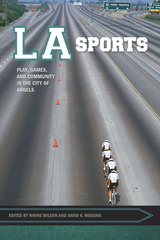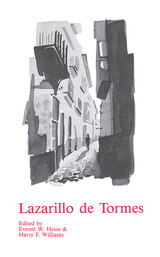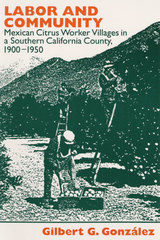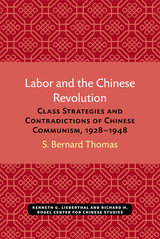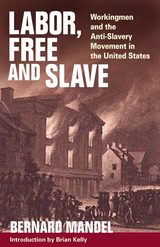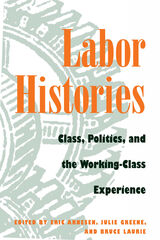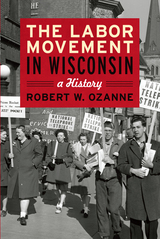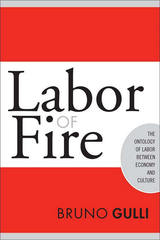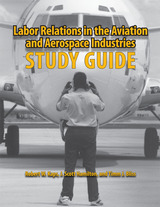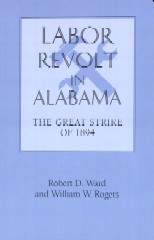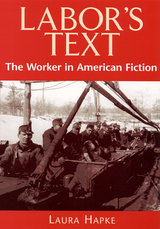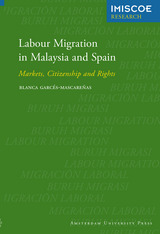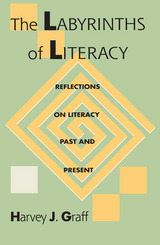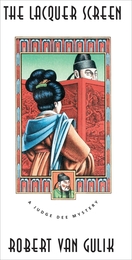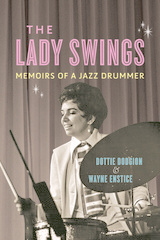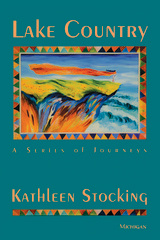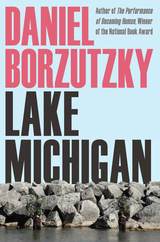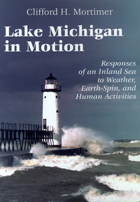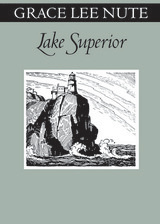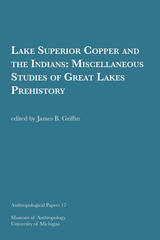L. Annaeus Cornutus: Greek Theology, Fragments, and Testimonia
George Boys-Stones
SBL Press, 2018 The first English translation of Greek Theology
The first-century CE North African philosopher Cornutus lived in Rome as a philosopher and is best known today for his surviving work Greek Theology, which explores the origins and names of the Greek gods. However, he was also interested in the language and literature of the poets Persius and Lucan and wrote one of the first commentaries on Virgil. This book collects and translates all of our evidence for Cornutus for the first time and includes the first published English translation of Greek Theology. This collection offers entirely fresh insight into the intellectual world of the first century.
Features
- Translation based on the latest critical text
- The first truly holistic picture of Cornutus’s intellectual profile
- A new account of the early debate over Aristotle’s Categories and the Stoic contribution to it
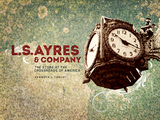 L. S. Ayres and Company: The Store at the Crossroads of America
Kenneth L. Turchi
Indiana Historical Society Press, 2012 In 1872 Lyman Ayres acquired a controlling interest in the Trade Place, a dry-goods store in Indianapolis. Two years later, he bought out his partners and renamed the establishment L. S. Ayres and Company. For the next century, Ayres was as much a part of Indianapolis as Monument Circle or the Indianapolis 500. Generations of midwestern families visited the vast store to shop, to see the animated Christmas windows, and, of course to visit Santa Claus and enjoy lunch in the Tea Room. But Ayres was more than just a department store. At its helm across three generations was a team of visionary retailers who took the store from its early silk-and-calico days to a diversified company with interests in specialty stores and discount stores (before Target and Wal-Mart). At the same time, Ayres never lost sight of its commitment to women’s fashion that gave the store the same cachet as its larger competitors in New York and Chicago.
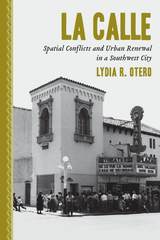 La Calle: Spatial Conflicts and Urban Renewal in a Southwest City
Lydia R. Otero
University of Arizona Press, 2010 On March 1, 1966, the voters of Tucson approved the Pueblo Center Redevelopment Project—Arizona’s first major urban renewal project—which targeted the most densely populated eighty acres in the state. For close to one hundred years, tucsonenses had created their own spatial reality in the historical, predominantly Mexican American heart of the city, an area most called “la calle.” Here, amid small retail and service shops, restaurants, and entertainment venues, they openly lived and celebrated their culture. To make way for the Pueblo Center’s new buildings, city officials proceeded to displace la calle’s residents and to demolish their ethnically diverse neighborhoods, which, contends Lydia Otero, challenged the spatial and cultural assumptions of postwar modernity, suburbia, and urban planning.
Otero examines conflicting claims to urban space, place, and history as advanced by two opposing historic preservationist groups: the La Placita Committee and the Tucson Heritage Foundation. Otero gives voice to those who lived in, experienced, or remembered this contested area, and analyzes the historical narratives promoted by Anglo American elites in the service of tourism and cultural dominance.
La Calle explores the forces behind the mass displacement: an unrelenting desire for order, a local economy increasingly dependent on tourism, and the pivotal power of federal housing policies. To understand how urban renewal resulted in the spatial reconfiguration of downtown Tucson, Otero draws on scholarship from a wide range of disciplines: Chicana/o, ethnic, and cultural studies; urban history, sociology, and anthropology; city planning; and cultural and feminist geography.
 La Cenerentola, ossia La bonta in trionfo: Melodramma giocoso In two acts by Jacopo Ferretti
Gioachino Rossini
University of Chicago Press, 1998 La Cenerentola (Cinderella) is a masterpiece significantly different from Rossini's earlier comic operas. Deftly combining aspects of several genres, Rossini plays off comic characters in the great Italian tradition—Don Magnifico (Cinderella's stepfather) and the valet Dandini—against the sentimental principal roles of Cinderella and the Prince. For his heroine Rossini not only adapts the popular semiseria genre, but also exploits the coloratura style of opera seria, as she is transformed into a princess not by magic but by love and her own innate goodness.
For the hastily-prepared premiere of La Cenerentola in Rome in 1817 a collaborator wrote the simple recitatives, a chorus, and arias for Alidoro (the Prince's tutor) and Clorinda (a stepsister). The chorus was soon dropped, and in 1821 Rossini wrote a new aria for Alidoro. This critical edition provides all the music for the first version, including variants for Clorinda. Appendixes include Rossini's own aria for Alidoro and his variations for Cinderella's final Rondo.
 L.A. Chic: A Locational History of Los Angeles Fashion
Susan Ingram and Markus Reisenleitner
Intellect Books, 2018 Los Angeles is undergoing a makeover. Leaving behind its image as all freeways and suburbs, sunshine and noir, it is reinventing itself for the twenty-first century as a walkable, pedestrian friendly, ecologically healthy, and global urban hotspot of fashion and style, while driving initiatives to rejuvenate its downtown core, public spaces, and ethnic neighborhoods. By providing a locational history of Los Angeles fashion and style mythologies through the lens of institutions such as manufacturing, museums, and designers and readings of contemporary film, literature and new media, L.A. Chic provides an in-depth analysis of the social changes, urban processes, desires, and politics that inform how the good life is being re-imagined in Los Angeles.
Throughout the book, Susan Ingram and Markus Reisenleitner dig up submerged and marginalized elements of the city’s cultural history but also tap into the global circuits of urban affect that are being mobilized for promoting L.A. as an example for the global, multi-ethnic city of the future. Engagingly written, highly visual, and featuring numerous photographs throughout, L.A. Chic will appeal to any culturally inclined reader with an interest in Los Angeles, its cultural history, and modern urban style.
La Chicana: The Mexican-American Woman
Alfredo Mirandé and Evangelina Enríquez
University of Chicago Press, 1981 La Chicana is the story of a marginal group in society, neither fully Mexican or fully American, who suffer under triple oppression: as women, as members of a colonized culture, and as victims of a cultural heritage dominated by the cult of machismo. Tracing the role of Chicanas from pre-Columbian society to the present, the authors reveal the antecedents and roots of contemporary cultural expectations in Aztec, colonial, and revolutionary Mexican historical periods. A discussion of the contribution of modern Chicanas to their community and to feminism and a look at literary stereotypes and the emergence of Chicana literature to counter them round out this perceptive and sympathetic analysis.
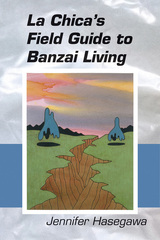 La Chica's Field Guide to Banzai Living
Jennifer Hasegawa
Omnidawn, 2019 From the small towns strung along the coast of the Big Island of Hawai‘i to the land-locked landscapes of Paraguay to the volcanic surface of Venus, this collection of poetry is a field guide to flora, fauna, and mineralia encountered, real, and imagined. Jennifer Hasegawa scans across physical and mental planes to reveal their inhabitants. Packed tightly into exploratory rocket segments, these poems ignite our gravest flaws to send our grandest potentials into orbit.
Hasegawa’s poems not only rearrange our ways of seeing the world, but they also reset the language we use in it. Banzai, with a literal translation of “10,000 years,” was used by the Japanese as a rallying cry in imperialistic and militaristic contexts. Today, the understanding of this word has shifted to a comparatively neutral translation of the enthusiastic expression “Hurrah!” in both in Japan and beyond. In La Chica’s Field Guide to Banzai Living, Hasegawa aims to reclaim banzai, recasting the language of war and unwavering loyalty and forming it into one that stands against aggression and racism and embraces tolerance and self-acceptance. Here banzai becomes a rallying cry not of war but of grand potential. La Chica’s Field Guide to Banzai Living chronicles a celebratory life and poetry filled with wonder.
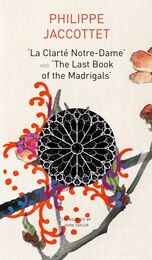 "La Clarté Notre-Dame" and "The Last Book of the Madrigals"
Philippe Jaccottet
Seagull Books, 2022 The last works of the last great classic European poet now available in English.
In his 96th and final year, and with the help of the poet José-Flore Tappy, celebrated Swiss poet Philippe Jaccottet finished two manuscripts-in-progress, one in prose and one in poetry, both of which are presented in this volume in John Taylor’s sensitive translation.
The first work, “La Clarté Notre-Dame,” takes off from the “pure, weightless, fragile, yet crystal-clear tinkling” of a monastery bell heard during a walk with friends. With this thought-provoking sound as a leitmotiv, Jaccottet looks back on a life of writing, reading, and scrutinizing humankind’s existential and spiritual aspirations. He sets these concerns against his equally lifelong preoccupation with “the rise of evil in today’s world,” notably in Syria. Composed in a baroque style, the verse poems collected in “The Last Book of Madrigals” explore love. Jaccottet returns in spirit to Italy, the country which for him symbolizes happiness and sensuality. As he evokes amorous attraction, he conjures up Monteverdi’s madrigals, one of Dante’s little-known rhymes, and Giuseppe Ungaretti’s last poem. Reinventing and commenting on these works, Jaccottet meditates on old age, approaching death, despair, and the persistence of love.
Together, both works grapple with devastating darkness, but as Tappy observes in her afterword, however, Jaccottet’s “greatest force” was “his perpetually renewed desire, during the most terrifying night, to head for the light.”
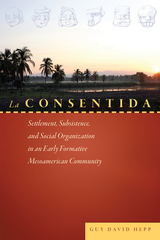 La Consentida: Settlement, Subsistence, and Social Organization in an Early Formative Mesoamerican Community
Guy David Hepp
University Press of Colorado, 2019 La Consentida explores Early Formative period transitions in residential mobility, subsistence, and social organization at the site of La Consentida in coastal Oaxaca, Mexico. Examining how this site transformed during one of the most fundamental moments of socioeconomic change in the ancient Americas, the book provides a new way of thinking about the social dynamics of Mesoamerican communities of the period. Guy David Hepp summarizes the results of several seasons of fieldwork and laboratory analysis under the aegis of the La Consentida Archaeological Project, drawing on various forms of evidence—ground stone tools, earthen architecture, faunal remains, human dental pathologies, isotopic indicators, ceramics, and more— to reveal how transitions in settlement, subsistence, and social organization at La Consentida were intimately linked. While Mesoamerica is too diverse for research at a single site to lay to rest ongoing debates about the Early Formative period, evidence from La Consentida should inform those debates because of the site’s unique ecological setting, its relative lack of disturbance by later occupations, and because it represents the only well-documented Early Formative period village in a 300-mile stretch of Mexico’s Pacific coast. One of the only studies to closely document multiple lines of evidence of the transition toward a sedentary, agricultural society at an individual settlement in Mesoamerica, La Consentida is a key resource for understanding the transition to settled life and social complexity in Mesoamerican societies.
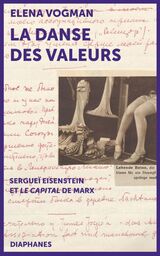 La danse des valeurs: Sergueï Eisenstein et le Capital de Marx
Elena Vogman
Diaphanes, 2020 Le Capital de Sergueï Eisenstein (1927-1928) est un fantôme à plus d’un titre: bien que le film n’ait jamais été réalisé, il a néanmoins hanté l'imagination de nombreux cinéastes, historiens et écrivains jusqu’à aujourd’hui et même récemment avec les Nouvelles de l’Antiquité idéologique : Marx – Eisenstein – Le Capital d’Alexander Kluge. De plus, sa première matérialisation publique – un fragment d’une dizaine de pages issu des carnets du réalisateur – était marquée par ce qui demeurait absent : les images et le matériau de travail d’Eisenstein. La Danse des valeurs ambitionne d’invoquer à nouveaux frais le fantôme du Capital mais en se fondant cette fois-ci sur l’ensemble de son corps d’archives. Cette « instruction visuelle à la méthode dialectique », selon les mots-mêmes d’Eisenstein, comprend plus de 500 pages de notes, de dessins, de coupures de presse, de diagrammes d’expression, de plans d’articles, de négatifs d’Octobre, de réflexions théoriques et de longues citations. La Danse des valeurs explore la nécessité formelle qui sous-tend les choix d’Eisenstein dans le Capital. Sa lecture fait valoir que sa complexité visuelle ainsi que son efficacité épistémique résident précisément dans l’état de son matériau : une danse de thèmes hétérogènes et de fragments disparates, un flux non-linéaire, provisoire et inarticulé. Les séquences visuelles d’archives, publiées ici pour la première fois en France, ne sont pas bâties à titre de simples illustrations, mais en tant qu’arguments à part entière, donnant à voir ce qui se joue pour Eisenstein dans le Capital : une théorisation visuelle de la valeur. Une lecture des archives d’Eisenstein, dans leur logique interne, permet non seulement de reconstituer des éléments morphologiques présents dans le concept de valeur chez Marx, mais également de théoriser une crise plus fondamentale de la représentation politique, un présent qui s’étend de son contexte contemporain jusqu’à nos jours. Mettant en œuvre un procédé morphologique sans équivoque, les séquences de montage d’Eisenstein produisent une sorte de plus-value qui leur est propre, un excès sémiotique qui brasse les matériaux et présente les corps dans une danse analogue à la « danse » des « conditions pétrifiées » de Marx. C’est dans ce langage polymorphe et « diffus » – associé au stream of consciousness de l’Ulysse de Joyce – qu’Eisenstein perçoit le potentiel critique et affectif d’un cinéma à venir.
La Divina Caricatura: Bunraku Meets Motown
Lee Breuer
Seagull Books, 2018 This unique book is a graphic novel and performance poem, a mixed-media musical cartoon, an animated feature film come to life. Lee Breuer’s La Divina Caricatura is in the pataphysical tradition of Alfred Jarry—if Jarry had been a Dante fan. In this play we meet unforgettable characters: Rose the Dog, who thinks she is a woman; her lover John, a junkie filmmaker; Ponzi Porco, PhD, a pig in love with the New York Times; and the Warrior Ant, who, to impress his father, Trotsky the Termite, declares the “perpetual revolution” of the bugs of the fifth world. Each a soul on its own pilgrimage, seldom with a Virgil or a Beatrice to guide them, they often try to guide each other, only to get more lost. A dazzling, comic, potent mix of ideas and character, invention and reality, the plays in La Divina Caricatura reinvigorate the stage for our time.
 La España que sobrevive
Fernando Diaz-Plaja and William W. Cressey
Georgetown University Press, 1997 Students of Spanish language and culture can now benefit from a text that provides them with an understanding of contemporary Spanish history and society while refining their knowledge of the language and expanding their vocabulary. La España que sobrevive (originally published in Madrid in 1987) explores the aftermath of the Franco era in Spain. It presents an objective and nonpartisan, yet humorous and affectionate, view of the important aspects of contemporary Spanish history and society. Topics include the transition to democracy; regionalism and nationalism; key players in current affairs; important institutions such as the monarchy, military, and the church; sexual mores; culture; the media; and politicized approaches to Spanish history. For this edition, William W. Cressey has edited Fernando Díaz-Plaja's text to make it accessible to English-speaking students at an advanced level of Spanish reading skills. Cressey has also added study aids to the book—vocabulary and footnotes, glosses on proper names, questions for discussion, notes on grammar and rhetoric, and exercises. The study aids are gradually phased out, so that the final chapter is presented as stand-alone reading without any supplementary materials. Cressey's adaptation of Díaz-Plaja's highly respected work provides an alternative to literary sources for foreign language instruction—a new resource for teaching foreign languages across the curriculum and instruction through content. Bridging the gap between the fairly simple intermediate readers and texts written for adult native speakers, this book can serve as either a supplementary or main text in the advanced study of language or history, or in preparation for study abroad. La España que sobrevive is a practical tool for teaching not only the language but also the many facets of modern Spanish culture.
La Familia: Chicano Families in the Urban Southwest, 1848 to the Present
Richard Griswold del Castillo
University of Notre Dame Press, 1984 In detailed historical analyses of Mexican immigration, economic class struggle, intermarriage, urbanization and industrialization, regional differences, and discrimination and prejudice, La Familia demonstrates how such social and economic factors have contributed to the contemporary diversity of the Mexican-American family. By comparing their family experience with those of European immigrants, he discloses important dimensions of Mexican-American ethnicity.
La Far
Eric Linsker
University of Iowa Press, 2014 How far are we from the Lake District? How far from the garden? Eric Linsker’s first book scrolls down the Anthropocene, tracking our passage through a technophilic pastoral where work and play are both forms of making others suffer in order to exist. In La Far, the world is faraway near, a hell conveniently elsewhere in which workers bundle Foxconn’s “rare earths” into the “frosty kits” that return us our content, but also the sea meeting land as it always has. Both are singable conditions and lead, irreversibly, to odes equally comfortable with praise and lament. The poems in La Far hope that by making the abstract concrete and the concrete abstract, “literalizing / a nightingale beyond / knowledge,” we might construct what Wordsworth called a “Common Day,” a communized life partaken of by all.
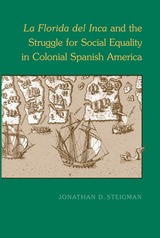 La Florida del Inca and the Struggle for Social Equality in Colonial Spanish America
Jonathan D. Steigman
University of Alabama Press, 2005 A cross-disciplinary view of an important De Soto chronicle. Among the early Spanish chroniclers who contributed to popular images of the New World was the Amerindian-Spanish (mestizo) historian and literary writer, El Inca Garcilaso de la Vega (1539-1616). He authored several works, of which La Florida del Inca (1605) stands out as the best because of its unique Amerindian and European perspectives on the De Soto expedition (1539-1543). As the child of an Indian mother and a Spanish father, Garcilaso lived in both worlds--and saw value in each. Hailed throughout Europe for his excellent contemporary Renaissance writing style, his work was characterized as literary art. Garcilaso revealed the emotions, struggles, and conflicts experienced by those who participated in the historic and grandiose adventure in La Florida. Although criticized for some lapses in accuracy in his attempts to paint both the Spaniards and the Amerindians as noble participants in a world-changing event, his work remains the most accessible of all the chronicles. In this volume, Jonathan Steigman explores El Inca’s rationale and motivations in writing his chronicle. He suggests that El Inca was trying to influence events by influencing discourse; that he sought to create a discourse of tolerance and agrarianism, rather than the dominant European discourse of intolerance, persecution, and lust for wealth. Although El Inca's purposes went well beyond detailing the facts of De Soto’s entrada, his skill as a writer and his dual understanding of the backgrounds of the participants enabled him to paint a more complete picture than most--putting a sympathetic human face on explorers and natives alike.
La Follette Insurgent Spirit
David P. Thelen
University of Wisconsin Press, 1986 Robert M. La Follette and the Insurgent Spirit is a closely argued, lively, and readable biography of the central figure in the American Progressive movement. Wisconsin's “Fighting Bob” La Follette embodied the heart of Progressive sentiment and principle. He was a powerful force in shaping national political events between the eras of Populism and the New Deal
La Follette’s Autobiography: A Personal Narrative of Political Experiences
Robert M. La Follette; Foreword by Matthew Rothschild
University of Wisconsin Press, 2013 Written in lucid, vigorous prose, La Follette's Autobiography is the famous Wisconsin senator's own account of his political life and philosophy. Both memoir and a history of the Progressive cause in the United States, it charts La Follette's formative years in politics, his attempts to abolish entrenched, ruthless state and corporate influences, and his embattled efforts to advance Progressive policies as Wisconsin governor and U.S. senator. With a new foreword by Matthew Rothschild, editor of The Progressive—the magazine that La Follette himself founded—the Autobiography remains a powerful reminder of the legacies of Progressivism and reform and the enduring voice of the man who fought for them.
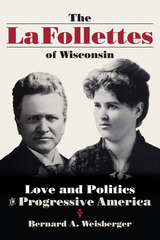 The La Follettes of Wisconsin: Love and Politics in Progressive America
Bernard A. Weisberger
University of Wisconsin Press, 2013 The La Follettes of Wisconsin—Robert, Belle, and their children, Bob Jr., Phil, Fola, and Mary—are vividly brought to life in this collective biography of an American political family. As governor of Wisconsin (1901–06) and U.S. Senator (1906–25), "Fighting Bob" battled relentlessly for his Progressive vision of democracy—an idealistic mixture of informed citizenry and enlightened egalitarianism. By contrast, the private man suffered from intense, isolated periods of depression and relied heavily on his family for survival. Together, "Old Bob" and his beloved wife, Belle Case La Follette—a lawyer, journalist, and Progressive leader in her own right—raised their children in the distinctly uncompromising La Follette tradition of challenging social and political ills. Fola became a campaigner for women's suffrage, Phil was governor of Wisconsin, and "Young Bob" became a U.S. senator.
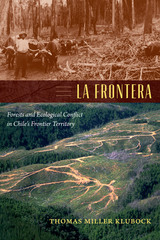 La Frontera: Forests and Ecological Conflict in Chile’s Frontier Territory
Thomas Miller Klubock
Duke University Press, 2014 In La Frontera, Thomas Miller Klubock offers a pioneering social and environmental history of southern Chile, exploring the origins of today’s forestry "miracle" in Chile. Although Chile's forestry boom is often attributed to the free-market policies of the Pinochet dictatorship, La Frontera shows that forestry development began in the early twentieth century when Chilean governments turned to forestry science and plantations of the North American Monterey pine to establish their governance of the frontier's natural and social worlds. Klubock demonstrates that modern conservationist policies and scientific forestry drove the enclosure of frontier commons occupied by indigenous and non-indigenous peasants who were defined as a threat to both native forests and tree plantations. La Frontera narrates the century-long struggles among peasants, Mapuche indigenous communities, large landowners, and the state over access to forest commons in the frontier territory. It traces the shifting social meanings of environmentalism by showing how, during the 1990s, rural laborers and Mapuches, once vilified by conservationists and foresters, drew on the language of modern environmentalism to critique the social dislocations produced by Chile's much vaunted neoliberal economic model, linking a more just social order to the biodiversity of native forests.
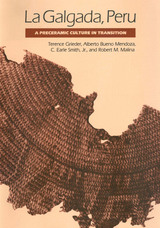 La Galgada, Peru: A Preceramic Culture in Transition
By Terence E. Grieder, Alberto Bueno Mendoza, C. Earle Smith, Jr., and Robert M. Malina
University of Texas Press, 1988 Excavations over many years in the Peruvian Andes and coastal regions have revealed that the village settlements on the west coast of South America were one of the early centers of world civilization. One of these settlements, La Galgada, flourished from 3000 B.C. to 1700 B.C. Its extraordinarily complete cultural remains help to reconstruct a picture of human life, health, activities, and trade relations as they were 4,000 years ago and allow us to enter the mental and artistic life of this early civilization. The location of La Galgada on Peru’s Tablachaca River midway between the highlands and the coast caused it to be influenced by the culture of both those regions. The remains found at La Galgada tie together important textile collections from the coastal region with important architectural remains from the Andean highland to give a picture of a complete preceramic culture in ancient Peru. Numerous illustrations provide an exciting visual catalog of the finds at La Galgada. What also makes La Galgada such a significant site are the changes in art and architecture that can be documented in considerable detail from about 2500 B.C. to about 1700 B.C. During that period, La Galgada and the other preceramic communities in northern Peru were transformed with a rapidity that must have seemed shocking and revolutionary to their inhabitants. These changes record the first appearance of the powerful and intimidating Chavín culture that was to dominate the region for the next thousand years. They also allow us to watch a people change and adapt as they try to cope with the powerful pressure of technical and social development in their region.
 La gazzetta: Dramma (giocoso) in Two Acts by Giuseppe Palomba, revised by Andrea Leone Tottola
Gioachino Rossini
University of Chicago Press, 2003 The libretto for La gazzetta, written by Giuseppe Palomba, was based on a play by Carlo Goldoni entitled Il matrimonio per concorso. Rossini drew a two-act comic opera from this libretto chiefly by recycling old music, a fact that has weighed heavily in critical reaction to the work. But as this edition reveals, this view is misleading. Rossini himself wrote each borrowed piece or section anew in its entirety by significantly modifying details, changing vocal lines throughout, and introducing numerous orchestral modifications. The resulting opera—first performed on September 26, 1816, at the Teatro dei Fiorentini in Naples—is delightful, with Goldoni's wonderful structure and characters given superb musical life by Rossini. This critical edition, edited by Fabrizio Scipioni, presents the full score in two volumes, along with a separate volume of insightful commentary.
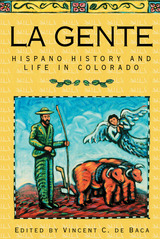 La Gente: Hispano History and Life in Colorado
Vincent C. De Baca
University Press of Colorado, 1998 Informative and provocative, La Gente: Hispano History and Life in Colorado collects eleven essays by a cross-section of Colorado scholars and writers. The book opens with an examination of Spanish-Mexican exploration, conquest, and settlement of the Colorado region. Moving from exploration to biographical sketches, the book profiles the enigmatic Teresita Sandoval, cofounder of Pueblo; provides the turn-of-the-century memoir of vaquero Elfido Lopez; and offers a bilingual version of the autobiography of Pablo Cabeza de Baca, who recalls the values of his youth and his days at Denver's Sacred Heart College, the precursor of Regis University. Several essays address the employment patterns of the early part of this century, when desperate native-born Hispanos and Mexican immigrants competed by the thousands for jobs at mining and agricultural corporations throughout Colorado. Four essays study particular expressions of this conflict, including the infamous Ludlow coal strike of 1913-1914; Colorado's sugar beet industry, where Mexican immigrants faced constant discrimination; the growth of the state's sugar industry, the collapse of which devastated Mexicans (the preferred labor force in the field); and a New Deal-era experiment in which laid-off miners were trained to weave Río Grande-style blankets, in the process revitalizing a dying folk art. Finally, four essays encompass the recent political and cultural rebirth of Hispanos, including a study of the origins of the Crusade for Justice, Denver's leading Chicano rights organization of the 1960s, which - based on declassified FBI documents - proves that government agencies tried to suppress the Crusade and its popular leader, Corky Gonzales.
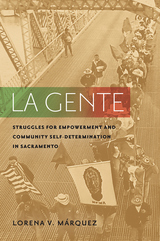 La Gente: Struggles for Empowerment and Community Self-Determination in Sacramento
Lorena V. Márquez
University of Arizona Press, 2020 La Gente traces the rise of the Chicana/o Movement in Sacramento and the role of everyday people in galvanizing a collective to seek lasting and transformative change during the 1960s and 1970s. In their efforts to be self-determined, la gente contested multiple forms of oppression at school, at work sites, and in their communities.
Though diverse in their cultural and generational backgrounds, la gente were constantly negotiating acts of resistance, especially when their lives, the lives of their children, their livelihoods, or their households were at risk. Historian Lorena V. Márquez documents early community interventions to challenge the prevailing notions of desegregation by barrio residents, providing a look at one of the first cases of outright resistance to desegregation efforts by ethnic Mexicans. She also shares the story of workers in the Sacramento area who initiated and won the first legal victory against canneries for discriminating against brown and black workers and women, and demonstrates how the community crossed ethnic barriers when it established the first accredited Chicana/o and Native American community college in the nation.
Márquez shows that the Chicana/o Movement was not solely limited to a handful of organizations or charismatic leaders. Rather, it encouraged those that were the most marginalized—the working poor, immigrants and/or the undocumented, and the undereducated—to fight for their rights on the premise that they too were contributing and deserving members of society.
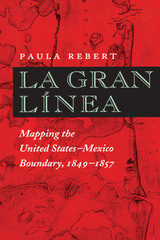 La Gran Línea: Mapping the United States–Mexico Boundary, 1849–1857
By Paula Rebert
University of Texas Press, 2001 The Treaty of Guadalupe Hildalgo, which officially ended the U.S.-Mexican War in 1848, cost Mexico half its territory, while the United States gained land that became California, Nevada, Utah, Texas, and parts of Colorado, Arizona, and New Mexico. Because the new United States-Mexico border ran through territory that was still incompletely mapped, the treaty also called for government commissions from both nations to locate and mark the boundary on the ground. This book documents the accomplishments of both the U.S. and the Mexican Boundary Commissions that mapped the boundary between 1849 and 1857, as well as the fifty-four pairs of maps produced by their efforts and the ongoing importance of these historical maps in current boundary administration. Paula Rebert explores how, despite the efforts of both commissions to draw neutral, scientific maps, the actual maps that resulted from their efforts reflected the differing goals and outlooks of the two countries. She also traces how the differences between the U.S. and Mexican maps have had important consequences for the history of the boundary.
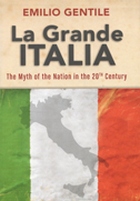 La Grande Italia: The Rise and Fall of the Myth of the Nation in the Twentieth Century
Emilio Gentile
University of Wisconsin Press, 2008 La Grande Italia traces the history of the myth of the nation in Italy along the curve of its rise and fall throughout the twentieth century. Starting with the festivities for the fiftieth anniversary of the unification of Italy in 1911 and ending with the centennial celebrations of 1961, Emilio Gentile describes a dense sequence of events: from victorious Italian participation in World War I through the rise and triumph of Fascism to Italy’s transition to a republic.
Gentile’s definition of “Italians” encompasses the whole range of political, cultural, and social actors: Liberals and Catholics, Monarchists and Republicans, Fascists and Socialists. La Grande Italia presents a sweeping study of the development of Italian national identity in all its incarnations throughout the twentieth century. This important contribution to the study of modern Italian nationalism and the ambition to achieve a “great Italy” between the unification of Italy and the advent of the Italian Republic will appeal to anyone interested in modern European history, Fascism, and nationalism.
Best Books for Special Interests, selected by the American Association of School Librarians, and Best Books for Regional General Interests, selected by the Public Library Association
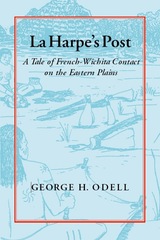 La Harpe's Post: Tales of French-Wichita Contact on the Eastern Plains
George H. Odell
University of Alabama Press, 2002 This major contribution to contact period studies points to the Lasley Vore site in modern Oklahoma as the most likely first meeting place of Plains Indians and Europeans more than 300 years ago.
In 1718, Jean-Baptiste Bénard, Sieur de la Harpe, departed St. Malo in Brittany for the New World. La Harpe, a member of the French bourgeoisie, arrived at Dauphin Island on the Gulf coast to take up the entrepreneurial concession provided by the director of the French colony, Jean Baptiste LeMoyne de Bienville. La Harpe's charge was to open a trading post on the Red River just above a Caddoan village not far from present-day Texarkana. Following the establishment of this post, La Harpe ventured farther north to extend his trade market into the region occupied by the Wichita Indians. Here he encountered a Tawakoni village with an estimated 6,000 inhabitants, a number that swelled to 7,000 during the ten-day visit.
Despite years of ethnohistoric and archaeological research, no scholar had successfully established where this important meeting took place. Then in 1988, George Odell and his crew surveyed and excavated an area 13 miles south of Tulsa, along the Arkansas River, that revealed undeniable association of Native American habitation refuse with 18th-century European trade goods.
Odell here presents a full account of the presumed location of the Tawakoni village as revealed through the analysis of excavated materials from nine specialist collaborators. In a strikingly well-written narrative report, employing careful study and innovative analysis supported by appendixes containing the excavation data, Odell combines documentary history and archaeological evidence to pinpoint the probable site of the first European contact with North American Plains Indians.
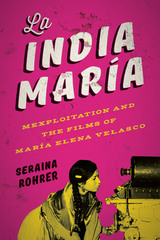 La India María: Mexploitation and the Films of María Elena Velasco
By Seraina Rohrer
University of Texas Press, 2017 La India María—a humble and stubborn indigenous Mexican woman—is one of the most popular characters of the Mexican stage, television, and film. Created and portrayed by María Elena Velasco, La India María has delighted audiences since the late 1960s with slapstick humor that slyly critiques discrimination and the powerful. At the same time, however, many critics have derided the iconic figure as a racist depiction of a negative stereotype and dismissed the India María films as exploitation cinema unworthy of serious attention. By contrast, La India María builds a convincing case for María Elena Velasco as an artist whose work as a director and producer—rare for women in Mexican cinema—has been widely and unjustly overlooked. Drawing on extensive interviews with Velasco, her family, and film industry professionals, as well as on archival research, Seraina Rohrer offers the first full account of Velasco’s life; her portrayal of La India María in vaudeville, television, and sixteen feature film comedies, including Ni de aquí, ni de allá [Neither here, nor there]; and her controversial reception in Mexico and the United States. Rohrer traces the films’ financing, production, and distribution, as well as censorship practices of the period, and compares them to other Mexploitation films produced at the same time. Adding a new chapter to the history of a much-understudied period of Mexican cinema commonly referred to as “la crisis,” this pioneering research enriches our appreciation of Mexploitation films.
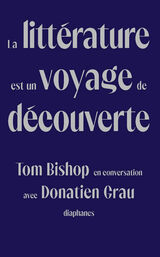 La littérature est un voyage de découverte: Tom Bishop en conversation avec Donatien Grau
Tom Bishop and Donatien Grau
Diaphanes, 2021 Tom Bishop a, pendant plus de soixante ans, contribué à définir les échanges littéraires, philosophiques, culturels, artistiques, mais aussi politiques entre Paris et New York. Comme professeur et directeur du Centre de Civilisation et de Culture Françaises à New York University, il a fait de l'institution de Washington Square l'un des grands ponts entre les nouveautés venues de Paris et une scène new-yorkaise alors en transformation complète. Tom Bishop était proche de Beckett, a défendu Robbe-Grillet aux États-Unis, s'est lié d'amitié avec Marguerite Duras et Hélène Cixous, a organisé des rencontres publiques historiques – comme celle entre James Baldwin et Toni Morrison. Il est également chercheur, spécialiste reconnu de l'avant-garde, notamment du Nouveau Roman et du Nouveau Théâtre. En 2012, il a invité Donatien Grau à donner une conférence à NYU. A partir de cette invitation, des conversations, une amitié se sont développées – dont certaines sont rassemblées dans ce livre. Tom Bishop retrace son parcours, sa propre histoire: son départ de Vienne, ses études, ses rencontres, ses choix, sa conception de la littérature et de la vie, son rapport au monde politique et économique; la manière dont il a contribué à définir la profession de « curator » telle qu'elle se pratique aujourd'hui. Dans ces entretiens, il se présente à la fois comme un savant, un organisateur, un acteur majeur de la vie intellectuelle: un individu, avec ses déclarations, sa colère, ses refus, sa loyauté, son appétit insatiable de découverte et de nouveauté, son profond attachement à l'université, lieu de liberté et de création.
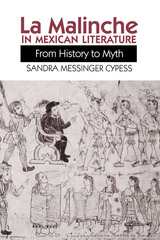 La Malinche in Mexican Literature: From History to Myth
By Sandra Messinger Cypess
University of Texas Press, 1991 Of all the historical characters known from the time of the Spanish conquest of the New World, none has proved more pervasive or controversial than that of the Indian interpreter, guide, mistress, and confidante of Hernán Cortés, Doña Marina—La Malinche—Malintzin. The mother of Cortés's son, she becomes not only the mother of the mestizo but also the Mexican Eve, the symbol of national betrayal. Very little documented evidence is available about Doña Marina. This is the first serious study tracing La Malinche in texts from the conquest period to the present day. It is also the first study to delineate the transformation of this historical figure into a literary sign with multiple manifestations. Cypess includes such seldom analyzed texts as Ireneo Paz's Amor y suplicio and Doña Marina, as well as new readings of well-known texts like Octavio Paz's El laberinto de la soledad. Using a feminist perspective, she convincingly demonstrates how the literary depiction and presentation of La Malinche is tied to the political agenda of the moment. She also shows how the symbol of La Malinche has changed over time through the impact of sociopolitical events on the literary expression.
La Medusa
Vanessa Place
University of Alabama Press, 2008 La Medusa is a polyphonic novel of post-conceptual consciousness. At the heart of the whole floats Medusa, an androgynous central awareness that anchors the novel throughout. La Medusa is at once the city of Los Angeles, with its snaking freeways and serpentine shifts between reality and illusion, and a brain—a modern mind that is both expansive and penetrating in its obsessions and perceptions. Vanessa Place’s characters—a trucker and his wife, a nine-year-old saxophonist, an ice cream vendor, a sex worker, and a corpse, among others—are borderless selves in a borderless city, a city impossible to contain. Her expert ventriloquism and explosive imagination anchor this epic narrative in language that is fierce and vibrant, a penetrating a cross-section of contemporary Los Angeles and a cross-section of the modern mind.
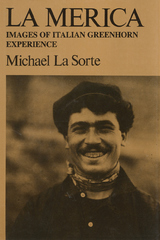 La Merica: Images Of Italian Greenhorn Experience
Michael A. La Sorte
Temple University Press, 2003 Why would a man tie up a cheap suitcase with grass rope, leave his family and his paesani in Italy to risk his life and meager possessions among the dock thieves of Naples and Genoa to suffer the congestion and stench of steerage accommodations aboard ship, to endure the assembly-line processing of Ellis Island, to wander almost incommunicado through a city of sneering strangers speaking an unknown tongue, to perform ten to twelve hours of heavy manual labor a day for wages of perhaps $1.65—most of which he probably owed to the "company store" before he got it? Why were there not just a few such men but droves of them coming to the United States in the late nineteenth and early twentieth century? How did they survive and—some of them—prosper? How did they surmount the language barrier? Why did some stay, some go home, and some bounce back and forth repeatedly across the Atlantic?Michael La Sorte examines these questions and more in this lively study of Italian immigration prior to World War I. In exploring for answers, he draws upon the commentary of recent scholars, as well as the statistical documents of the day. But most important, he has searched out individual stories in the published and unpublished diaries, letters, and autobiographies of immigrants who lived the "greenhorn" (grignoni) experience.In their own language, the men bring to life the teeming tenements of New York's Mulberry Street, the exploitative labor-recruiting practices of Boston's North Square, and the harsh squalor of work camp life along the country's expanding railroad lines. What emerges is a powerful, moving, alternately funny and appalling picture of their everyday lives.Through detailed narration, La Sorte traces the men's lives from their native villages across the Atlantic through the ports of entry to their first immigrant jobs. He describes their views of Italy, America, and each other, the cultural and linguistic adjustments that they were compelled to make, and their motives for either Americanizing or repatriating themselves. His chapter on "Italglish" (a hybrid language developed by the greenhorns) will echo in the ears of Italian-Americans as the sound of their parents' and grandparents' voices.
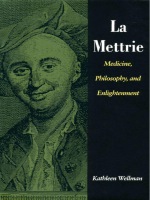 La Mettrie: Medicine, Philosophy, and Enlightenment
Kathleen Wellman
Duke University Press, 1992 Julien Offray de la Mettrie, best known as the author of L’Homme machine, appears as a minor character in most accounts of the Enlightenment. But in this intellectual biography by Kathleen Wellman, La Mettrie—physician-philosophe—emerges as a central figure whose medical approach to philosophical and moral issues had a profound influence on the period and its legacy.
Wellman’s study presents La Mettrie as an advocate of progressive medical theory and practice who consistently applied his medical concerns to the reform of philosophy, morals, and society. By examining his training with the Dutch physician Hermann Boerhaave, his satires lampooning the ignorance and venality of the medical profession, and his medical treatises on subjects ranging from vertigo to veneral disease, Wellman illuminates the medical roots of La Mettrie’s philosophy. She shows how medicine encouraged La Mettrie to undertake an impiricist critique of the philosophical tradition and provided the foundation for a medical materialism that both shaped his understanding of the possibilities of moral and social reform and led him to espouse the cause of the philosophers.
Elucidating the medical view of nature, human beings, and society that the Enlightenment and La Mettrie in particular bequethed to the modern world, La Mettrie makes an important contribution to our understanding of both that period and our own.
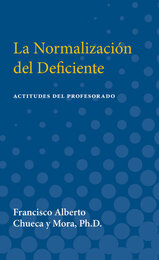 La Normalizacion del Deficiente: Actitudes del Profesorado (Teachers' Attitudes toward Mainstreaming Handicapped Children in Spain)
Francisco Alberto Chueca y Mora
University of Michigan Press, 1988 Teacher attitudes toward the mainstreaming of students with handicaps is a topic of international concern. Although as a social and educational policy, mainstreaming has been attempted with greatly varying degrees of success in the United States and elsewhere for the past ten years, very little empirical evidence existed to give support to such a policy. The author's study, conducted in Spain prior to a nationwide effort to integrate children with handicaps into regular classrooms, indicates that the success or failure of such programs is crucially linked to teachers' willingness to accept the concept of mainstreaming. This study examines teacher attitudes and related variables about mainstreaming before its inception, and resolves some of the difficulties that have been experienced with its implementation. This is an extremely important document for educators and others involved with handicapped children.
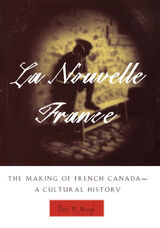 La Nouvelle France: The Making of French Canada - A Cultural History
Peter N. Moogk
Michigan State University Press, 2000 On one level, Peter Moogk's latest book, La Nouvelle France: The Making of French Canada—A Cultural History, is a candid exploration of the troubled historical relationship that exists between the inhabitants of French- and English- speaking Canada. At the same time, it is a long- overdue study of the colonial social institutions, values, and experiences that shaped modern French Canada. Moogk draws on a rich body of evidence—literature; statistical studies; government, legal, and private documents in France, Britain, and North America— and traces the roots of the Anglo-French cultural struggle to the seventeenth century. In so doing, he discovered a New France vastly different from the one portrayed in popular mythology. French relations with Native Peoples, for instance, were strained. The colony of New France was really no single entity, but rather a chain of loosely aligned outposts stretching from Newfoundland in the east to the Illinois Country in the west.
Moogk also found that many early immigrants to New France were reluctant exiles from their homeland and that a high percentage returned to Europe. Those who stayed, the Acadians and Canadians, were politically conservative and retained Old Régime values: feudal social hierarchies remained strong; one's individualism tended to be familial, not personal; Roman Catholicism molded attitudes and was as important as language in defining Acadian and Canadian identities. It was, Moogk concludes, the pre-French Revolution Bourbon monarchy and its institutions that shaped modern French Canada, in particular the Province of Quebec, and set its people apart from the rest of the nation.
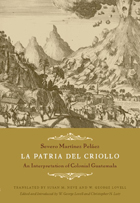 La Patria del Criollo: An Interpretation of Colonial Guatemala
Severo Martínez Peláez
Duke University Press, 2009 This translation of Severo Martínez Peláez’s La Patria del Criollo, first published in Guatemala in 1970, makes a classic, controversial work of Latin American history available to English-language readers. Martínez Peláez was one of Guatemala’s foremost historians and a political activist committed to revolutionary social change. La Patria del Criollo is his scathing assessment of Guatemala’s colonial legacy. Martínez Peláez argues that Guatemala remains a colonial society because the conditions that arose centuries ago when imperial Spain held sway have endured. He maintains that economic circumstances that assure prosperity for a few and deprivation for the majority were altered neither by independence in 1821 nor by liberal reform following 1871. The few in question are an elite group of criollos, people of Spanish descent born in Guatemala; the majority are predominantly Maya Indians, whose impoverishment is shared by many mixed-race Guatemalans. Martínez Peláez asserts that “the coffee dictatorships were the full and radical realization of criollo notions of the patria.” This patria, or homeland, was one that criollos had wrested from Spaniards in the name of independence and taken control of based on claims of liberal reform. He contends that since labor is needed to make land productive, the exploitation of labor, particularly Indian labor, was a necessary complement to criollo appropriation. His depiction of colonial reality is bleak, and his portrayal of Spanish and criollo behavior toward Indians unrelenting in its emphasis on cruelty and oppression. Martínez Peláez felt that the grim past he documented surfaces each day in an equally grim present, and that confronting the past is a necessary step in any effort to improve Guatemala’s woes. An extensive introduction situates La Patria del Criollo in historical context and relates it to contemporary issues and debates.
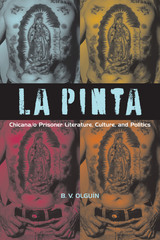 La Pinta: Chicana/o Prisoner Literature, Culture, and Politics
By B. V. Olguín
University of Texas Press, 2009 In this groundbreaking study based on archival research about Chicana and Chicano prisoners—known as Pintas and Pintos—as well as fresh interpretations of works by renowned Pinta and Pinto authors and activists, B. V. Olguín provides crucial insights into the central roles that incarceration and the incarcerated have played in the evolution of Chicana/o history, cultural paradigms, and oppositional political praxis. This is the first text on prisoners in general, and Chicana/o and Latina/o prisoners in particular, that provides a range of case studies from the nineteenth century to the present. Olguín places multiple approaches in dialogue through the pairing of representational figures in the history of Chicana/o incarceration with specific themes and topics. Case studies on the first nineteenth-century Chicana prisoner in San Quentin State Prison, Modesta Avila; renowned late-twentieth-century Chicano poets Raúl Salinas, Ricardo Sánchez, and Jimmy Santiago Baca; lesser-known Chicana pinta and author Judy Lucero; and infamous Chicano drug baron and social bandit Fred Gómez Carrasco are aligned with themes from popular culture such as prisoner tattoo art and handkerchief art, Hollywood Chicana/o gangxploitation and the prisoner film American Me, and prisoner education projects. Olguín provides a refreshing critical interrogation of Chicana/o subaltern agency, which too often is celebrated as unambiguously resistant and oppositional. As such, this study challenges long-held presumptions about Chicana/o cultures of resistance and proposes important explorations of the complex and contradictory relationship between Chicana/o agency and ideology.
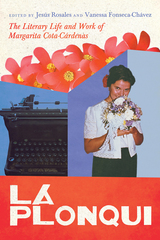 La Plonqui: The Literary Life and Work of Margarita Cota-Cárdenas
Edited by Jesús Rosales and Vanessa Fonseca-Chávez
University of Arizona Press, 2023 Celebrating more than forty years of creative writing by Chicana author Margarita Cota-Cárdenas, this volume includes critical essays, reflections, interviews, and previously unpublished writing by the author herself to document the lifelong craft and legacy of a pioneering writer in the field.
Nicknamed “La Plonky” by her family after a made-up childhood song, Cota-Cárdenas grew up in California, taught almost exclusively in Arizona, and produced five major works (two novels and three books of poetry) that offer an expansive literary production spanning from the 1960s to today. Her perspectives on Chicana identity, the Chicanx movement, and the sociopolitical climate of Arizona and the larger U.S.-Mexico border region represent a significant contribution to the larger body of Chicanx literature. Additionally, the volume explores her perspectives on issues of gender, sexuality, and identity related to the Chicanx experience over time.
Divided into three major parts, this collection begins with an introduction, followed by two testimonial essays written by the author herself and a longtime colleague, as well as an interview with the author. The second section contains nine essays by well-established literary critics that analyze Cota-Cárdenas’s literary output within a Chicano Movement literary context and offer new readings of Cota-Cárdenas’s fiction and poetry. The third part presents poetry and fiction from Cota-Cárdenas, including an excerpt from a work in progress. As a whole, the collection aims to affirm Margarita Cota-Cárdenas’s significant role in shaping the field of Chicana literature and emphasizes the importance of honoring a celebrated author who wrote a majority of her works in Spanish—one of the few Chicana writers to do so.
Contributors
Laura Elena Belmonte
Margarita Cota-Cárdenas
José R. Flores
Vanessa Fonseca-Chávez
Carolyn González
Gabriella Gutiérrez y Muhs
Manuel M. Martín-Rodríguez
Kirsten F. Nigro
Margarita E. Pignataro
Tey Diana Rebolledo
Jesús Rosales
Charles St-Georges
Javier Villarreal
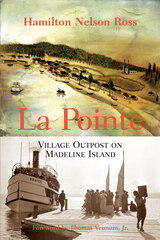 La Pointe: Village Outpost on Madeline Island
Hamilton Nelson Ross
Wisconsin Historical Society Press, 2000 The Wisconsin Historical Society Press has republished a long-out-of-print classic of Wisconsin history, La Pointe: Village Outpost, by Hamilton Nelson Ross (1889-1957). The book, which first appeared in 1960, provides a 300-year history of La Pointe, a community on Madeline Island, one of Lake Superior's Apostle Islands. With flair, humor, and solid scholarship, Ross tells the story of the region's evolution. Madeline Island served initially as a refuge for the local Ojibway from their enemy the Sioux before the arrival of French explorers in 1659, then an epicenter of the fur-trade era in the eighteenth century, and finally a summer vacation spot for businessmen and industrialists. Today the island attracts thousands of summer tourists who vastly outnumber the 200 or so year-round residents. Ross first visited Madeline Island from his native Beloit as an eight-year-old, returning again and again over his lifetime to the Ross family cabin in La Pointe. His years of careful study and observation served him well. Ross told the region's story so eloquently that his book helped persuade Congress and the President in 1970 to preserve the islands in perpetuity as the Apostle Islands National Lakeshore.
 L.A. Private Eyes
Dahlia Schweitzer
Rutgers University Press, 2019 L.A. Private Eyes examines the tradition of the private eye as it evolves in films, books, and television shows set in Los Angeles from the 1930’s through the present day. It takes a closer look at narratives—both on screen and on the printed page—in which detectives travel the streets of Los Angeles, uncovering corruption, moral ambiguity, and greed with the conviction of urban cowboys, while always ultimately finding truth and redemption. With a review of Los Angeles history, crime stories, and film noir, L.A. Private Eyes explores the metamorphosis of the solitary detective figure and the many facets of the genre itself, from noir to mystery, on the screen. While the conventions of the genre may have remained consistent and recognizable, the points where they evolve illuminate much about our changing gender and power roles. Watch a video of the author speaking about this topic: https://goo.gl/Xr9RFD And also: https://www.dropbox.com/s/mkqw3mplruf7jje/Detective%20Talk%20Full.mp4?dl=0 (https://www.dropbox.com/s/mkqw3mplruf7jje/Detective%20Talk%20Full.mp4?dl=0)
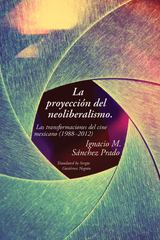 La proyección del neoliberalismo: Las transformaciones del cine mexicano (1988–2012)
Ignacio M. Sánchez Prado
Vanderbilt University Press Cavernosa, usualmente fría, siempre oscura, con un ligero olor a palomitas de maíz en el aire: la experiencia de ir al cine es universal. No es menos intensa en México, donde la experiencia ha evolucionado de formas complejas en años recientes. Películas como Y tu mamá también, El Mariachi, Amores perros y las obras de los paradigmáticos Guillermo del Toro y Salma Hayek, reflejan mucho más un renovado interés por el cine en México. En La proyección del neoliberalismo, Ignacio Sánchez Prado explora precisamente los eventos que tuvieron lugar en la industria del cine mexicano durante las últimas décadas. Lejos de ser una simple historia del periodo, La proyección del neoliberalismo examina cuatro aspectos esenciales de las transformaciones ocurridas en la industria del cine mexicano: la caída del nacionalismo, un nuevo enfoque en audiencias de clase media, la redefinición del concepto de cine político y el impacto de la globalización. Este análisis incluye a directores y películas que han alcanzado notoriedad internacional o relevancia en la construcción de un mercado nacional. La proyección del neoliberalismo expone las consecuencias de una industria del cine forzada a encontrar nuevas audiencias entre la clase media mexicana para poder alcanzar el ansiado éxito económico y la aprobación cultural.
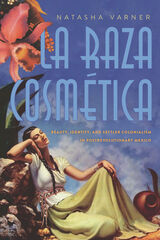 La Raza Cosmética: Beauty, Identity, and Settler Colonialism in Postrevolutionary Mexico
Natasha Varner
University of Arizona Press, 2020 In the decades following the Mexican Revolution, nation builders, artists, and intellectuals manufactured ideologies that continue to give shape to popular understandings of indigeneity and mestizaje today. Postrevolutionary identity tropes emerged as part of broader efforts to reunify the nation and solve pressing social concerns, including what was posited in the racist rhetoric of the time as the “Indian problem.” Through a complex alchemy of appropriation and erasure, indigeneity was idealized as a relic of the past while mestizaje was positioned as the race of the future. This period of identity formation coincided with a boom in technology that introduced a sudden proliferation of images on the streets and in homes: there were more photographs in newspapers, movie houses cropped up across the country, and printing houses mass-produced calendar art and postcards. La Raza Cosmética traces postrevolutionary identity ideals and debates as they were dispersed to the greater public through emerging visual culture.
Critically examining beauty pageants, cinema, tourism propaganda, photography, murals, and more, Natasha Varner shows how postrevolutionary understandings of mexicanidad were fundamentally structured by legacies of colonialism, as well as shifting ideas about race, place, and gender. This interdisciplinary study smartly weaves together cultural history, Indigenous and settler colonial studies, film and popular culture analysis, and environmental and urban history. It also traces a range of Indigenous interventions in order to disrupt top-down understandings of national identity construction and to “people” this history with voices that have all too often been entirely ignored.
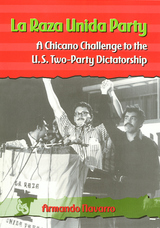 La Raza Unida Party
Armando Navarro
Temple University Press, 2000 Over the years, third parties have arisen sporadically to challenge the hegemony of the United States' two major political parties. But not until the emergence of the Raza Unida Party (RUP) in 1970 did an ethnic group organize to fight for political control at the country's ballot boxes. This book, by noted Chicano movement theorist Armando Navarro, is the most comprehensive study of the party ever put together.
La Raza Unida Party traces the party from its beginnings in 1970 to its demise in 1981 -- the events, leaders, ideology, structure, strategy and tactics, successes and problems, and electoral campaigns that marked its trajectory. The book covers political organizing in California, Texas, Colorado, New Mexico, Arizona, and the Midwest, as well as RUP's national and international politics and its party profile. In addition, its suggests options for future political arena. Based on 161 interviews, access to numerous documents, letters, minutes, diaries, and position papers, as well as such published sources as contemporary newspaper and magazine accounts and campaign literature, the study is enriched by Professor Navarro's accounts of his own experiences as one of the organizers of the RUP in California.
La Raza Unida Party represents the culmination of the story of Chicano militancy that Professor Navarro has related in his earlier books. It goes beyond mere history-telling to discuss the strengths and weaknesses of ethnic-identity political parties and the perils of challenging the two-party dictatorship that characterizes U.S. electoral politics.
La réalité des médias de masse
Niklas Luhmann
Diaphanes, 2012 Les médias de masse forment un système qui s’autoalimente indépendamment de toute intervention extérieure, dans lequel nous avons pris l’habitude d’évoluer sans le questionner. Niklas Luhmann propose une analyse minutieuse des modes de fonctionnement de ce système, de ses implications et des sélections simplificatrices qu’il opère au sein de la complexité et de la contingence définissant le monde. Selon lui, l’actualité émerge ainsi au sein des médias de masse en suivant des règles précises et en respectant les constructions que ceux qui l’écrivent ou la filment plaquent sur le réel. Ils façonnent la réalité tout autant qu’ils la décrivent. D’une actualité indiscutable, cet essai invite à reconsidérer la manière dont le monde se conçoit lui-même.
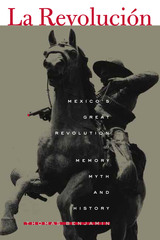 La Revolución: Mexico's Great Revolution as Memory, Myth, and History
By Thomas Benjamin
University of Texas Press, 2000 The 1910 Revolution is still tangibly present in Mexico in the festivals that celebrate its victories, on the monuments to its heroes, and, most important, in the stories and memories of the Mexican people. Yet there has never been general agreement on what the revolution meant, what its objectives were, and whether they have been accomplished. This pathfinding book shows how Mexicans from 1910 through the 1950s interpreted the revolution, tried to make sense of it, and, through collective memory, myth-making, and history writing, invented an idea called "la Revolución." In part one, Thomas Benjamin follows the historical development of different and often opposing revolutionary traditions and the state's efforts to forge them into one unified and unifying narrative. In part two, he examines ways of remembering the past and making it relevant to the present through fiestas, monuments, and official history. This research clarifies how the revolution has served to authorize and legitimize political factions and particular regimes to the present day. Beyond the Mexican case, it demonstrates how history is used to serve the needs of the present.
 La Selva: Ecology and Natural History of a Neotropical Rain Forest
Edited by Lucinda A. McDade, Kamaljit S. Bawa, Henry A. Hespenheide, and Gary S.
University of Chicago Press, 1994 La Selva, a nature reserve and field station in Costa Rica, is one of
the most intensively studied and best-understood tropical field sites
in the world. For over thirty years, La Selva has been a major focus
of research on rainforest ecology, flora, and fauna. This volume
provides the first comprehensive review of this research, covering La
Selva's geographical history and physical setting, its plant and
animal life, and agricultural development and land use.
Drawing together a wealth of information never before available in a
single volume, La Selva offers a substantive treatment of the
ecology of a rainforest. Part 1 summarizes research on the physical
setting and environment of the rainforest, as well as the history of
the research station. Some chapters in this part focus on climate,
geomorphology, and aquatic systems, while others look at soils,
nutrient acquisition, and cycles of energy.
Part 2 synthesizes what is known about the plant community. It begins
with chapters on vegetation types and plant diversity, and also
explores plant demography, spatial patterns of trees, and the impact
of treefall gaps on forest structure and dynamics. Other chapters
address plant physiological ecology, as well as plant reproductive
systems.
Part 3 covers the animal community, summarizing information on the six
best-known animal taxa of the region: fishes, amphibians, reptiles,
birds, mammals, and butterflies. This part includes an overview of
faunal studies at La Selva and a chapter on animal population biology,
which examines animal demography and abundance, and interactions
between predators and prey. Part 4 addresses interactions between
plants and animals and the effects of these interactions on species
diversity.
Part 5 considers the impact of land use and agricultural development
on La Selva and other areas of Costa Rica. One chapter examines land
colonization and conservation in Sarapiqui, another covers subsistence
and commercial agricultural development in the Atlantic lowlands
region, and a third looks at the forest industry in northeastern Costa
Rica. This part also assesses the role and research priorities of La
Selva.
La Selva provides an introduction to tropical ecology for
students and researchers at La Selva, a major source of comparative
information for biologists working in other tropical areas, and a
valuable resource for conservationists.
LA Sports: Play, Games, and Community in the City of Angels
Wayne Wilson
University of Arkansas Press, 2018 LA Sports brings together sixteen essays covering various aspects of the development and changing nature of sport in one of America’s most fascinating and famous cities. The writers cover a range of topics, including the history of car racing and ice skating, the development of sport venues, the power of the Mexican fan base in American soccer leagues, the intersecting life stories of Jackie and Mack Robinson, the importance of the Showtime Lakers, the origins of Muscle Beach and surfing, sport in Hollywood films, and more.
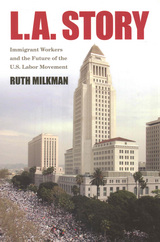 L.A. Story: Immigrant Workers and the Future of the U.S. Labor Movement
Ruth Milkman
Russell Sage Foundation, 2006 Sharp decreases in union membership over the last fifty years have caused many to dismiss organized labor as irrelevant in today's labor market. In the private sector, only 8 percent of workers today are union members, down from 24 percent as recently as 1973. Yet developments in Southern California—including the successful Justice for Janitors campaign—suggest that reports of organized labor's demise may have been exaggerated. In L.A. Story, sociologist and labor expert Ruth Milkman explains how Los Angeles, once known as a company town hostile to labor, became a hotbed for unionism, and how immigrant service workers emerged as the unlikely leaders in the battle for workers' rights. L.A. Story shatters many of the myths of modern labor with a close look at workers in four industries in Los Angeles: building maintenance, trucking, construction, and garment production. Though many blame deunionization and deteriorating working conditions on immigrants, Milkman shows that this conventional wisdom is wrong. Her analysis reveals that worsening work environments preceded the influx of foreign-born workers, who filled the positions only after native-born workers fled these suddenly undesirable jobs. Ironically, L.A. Story shows that immigrant workers, who many union leaders feared were incapable of being organized because of language constraints and fear of deportation, instead proved highly responsive to organizing efforts. As Milkman demonstrates, these mostly Latino workers came to their service jobs in the United States with a more group-oriented mentality than the American workers they replaced. Some also drew on experience in their native countries with labor and political struggles. This stock of fresh minds and new ideas, along with a physical distance from the east-coast centers of labor's old guard, made Los Angeles the center of a burgeoning workers' rights movement. Los Angeles' recent labor history highlights some of the key ingredients of the labor movement's resurgence—new leadership, latitude to experiment with organizing techniques, and a willingness to embrace both top-down and bottom-up strategies. L.A. Story's clear and thorough assessment of these developments points to an alternative, high-road national economic agenda that could provide workers with a way out of poverty and into the middle class.
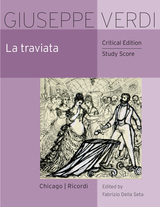 La traviata: Critical Edition Study Score
Giuseppe Verdi
University of Chicago Press, 2017 “I complain bitterly of the editions of my last operas, made with such little care, and filled with an infinite number of errors.”—Giuseppe Verdi
The University of Chicago Press, in collaboration with Casa Ricordi, has undertaken to publish the first critical edition of the complete works of Giuseppe Verdi. The series, based exclusively on original sources, is the only one to present authentic versions of all of the composer’s works; together with his operas, the critical edition presents his songs, his choral music and sacred pieces, and his string quartet and other instrumental works.
The Works of Giuseppe Verdi will be an invaluable standard reference work—a necessary acquisition for all music libraries and a joy to own for all lovers of opera. The new series of study scores presents an adaptation of each critical edition that provides scholars with an affordable and portable option for exploring Verdi’s oeuvre. The study scores have been designed to distinguish editors’ marks from Verdi’s own notations while remaining clear enough for use in performance. The introduction to each score discusses the work’s sources, composition, and performance history, as well as performance practices, instrumentation, and problems of notation. The newest editions of the study scores examine two of Verdi’s three-act operas: La traviata and Rigoletto.
 La traviata: Melodramma in Three Acts, Libretto by Francesco Maria Piave
Giuseppe Verdi
University of Chicago Press, 1997 Now one of Verdi's most beloved works, La traviata was initially far from a success. Verdi declared its 1853 premiere a "fiasco," and later reworked parts of five pieces in the first two acts, retaining the original setting for the rest. The first performance of the new version in 1854 was a tremendous success, and the opera was quickly taken up by theaters around the world.
This critical edition presents the 1854 version as the main score, and also makes available for the first time in full score the original 1853 settings of the revised pieces. For this edition Fabrizio della Seta used not only the composer's autograph and many secondary sources, but also Verdi's previously unknown sketches. These sketches helped corroborate the original readings and illuminate the work's compositional stages. The editor's wide-ranging introduction traces the opera's genesis, sources, performance history and practices, and a detailed critical commentary discusses source problems and ambiguities.
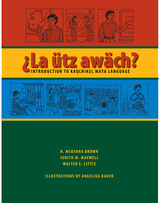 La ütz awäch?: Introduction to Kaqchikel Maya Language
By R. McKenna Brown, Judith M. Maxwell, and Walter E. Little
University of Texas Press, 2006 Kaqchikel is one of approximately thirty Mayan languages spoken in Belize, Guatemala, Mexico, and, increasingly, the United States. Of the twenty-two Mayan languages spoken in Guatemala, Kaqchikel is one of the four "mayoritarios," those with the largest number of speakers. About half a million people living in the central highlands between Guatemala City and Lake Atitlán speak Kaqchikel. And because native Kaqchikel speakers are prominent in the field of Mayan linguistics, as well as in Mayan cultural activism generally, Kaqchikel has been adopted as a Mayan lingua franca in some circles. This innovative language-learning guide is designed to help students, scholars, and professionals in many fields who work with Kaqchikel speakers, in both Guatemala and the United States, quickly develop basic communication skills. The book will familiarize learners with the words, phrases, and structures used in daily communications, presented in as natural a way as possible, and in a logical sequence. Six chapters introduce the language in context (greetings, the classroom, people, the family, food, and life) followed by exercises and short essays on aspects of Kaqchikel life. A grammar summary provides in-depth linguistic analysis of Kaqchikel, and a glossary supports vocabulary learning from both Kaqchikel to English and English to Kaqchikel. These resources, along with sound files and other media on the Internet at ekaq.stonecenter.tulane.edu, will allow learners to develop proficiency in all five major language skills—listening comprehension, speaking, reading, writing, and sociocultural understanding.
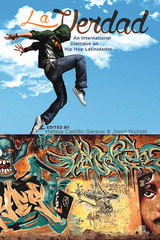 La Verdad: An International Dialogue on Hip Hop Latinidades
Edited by Melissa Castillo-Garsow and Jason Nichols
Ohio State University Press, 2016 From its earliest days, hip hop was more than just music, encapsulating the ideas of community and exchange. Artists like Mellow Man Ace and Kid Frost opened doors by infusing Spanish into their lyrics, calling for racial and social equality; others employed hip hop to comment on the effects of neo-liberalization and global capital. In recent decades, the cultural exchange has expanded—the music traveling from the United States to Latin America and back as visual artists, music producers, MCs, vocalists, and dancers combine their Latin cultures with influences from north of the U.S. border to create new artistic experiences. And while there is an extensive body of work on U.S. hip hop, it continues to evolve in an increasingly multilingual, multiethnic, intergenerational, and global collection of cultural expressions.
A truly international effort, La Verdad: An International Dialogue on Hip Hop Latinidades brings together exciting new work about Latino/a hip hop across more than a dozen countries, from scholars and practitioners in the United States and in Latin America, highlighting in new ways the participation of women, indigenous peoples, and Afro-descendants in a reimagined global, hip hop nation. From graffitera crews in Costa Rica and Nicaragua to Mexican hip hop in New York, from Aymara rap in Bolivia to Chicano rap in Taiwan, this volume explodes stereotypes of who and how hip hop is consumed, lived, and performed. Examining hip hop movements in Spanish, English, Portuguese, Aymara, and Creole, La Verdad demonstrates that Latino hip hop is a multilingual expression of gender, indigeneity, activism, and social justice.
La vida de Lazarillo de Tormes y de sus fortunas y adversidades
Edited by Everett W. Hesse and Harry F. Williams
University of Wisconsin Press, 1961 First published in 1554 and banned by the Inquisition, the anonymous Lazarillo de Tormes begat a whole new genre—the picaresque novel. This classic has had enduring popularity as a literary expression of Spanish identity and emotion. Through its daring autobiographical form the reader observes the magnificent, conquering Spain of Charles the Fifth through the inner consciousness of the humble Lazarillo.
This editon includes the annotated Spanish-language text and prologue (with modernized and regularized spelling) , a full vocabulary, and concise footnotes explaining allusions and translating phrases of varying difficulty.
Spanish-language with introductions in English
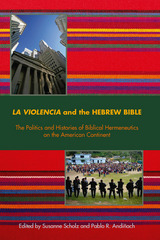 La Violencia and the Hebrew Bible: The Politics and Histories of Biblical Hermeneutics on the America
Susanne Scholz
SBL Press, 2016 Exegetically noteworthy and culturally-theologically relevant
Violence in its wide range of horrifying expressions is real in people’s lives, and biblical interpreters must take violence in the world seriously to arrive at relevant ideas about the place of the Bible in the world. Each essay addresses people’s experiences of violence in the study of the Bible through the context of la violencia, the Spanish noun referring to the brutal, repressive, and murderous policies of state-sponsored violence practiced in many South and Central American and Caribbean countries during the twentieth century that external powers such as the USA often endorsed and fostered. The volume represents an important contribution to biblical studies and to the field of Latina/o studies. The contributors are Cheryl B. Anderson, Pablo Andiñach, Nancy Bedford, Lee Cuéllar, Steed V. Davidson, Serge Frolov, Renata Furst, Julia M. O’Brien, Todd Penner, José Enrique Ramírez, Ivoni Richter Reimer, and Susanne Scholz.
Features:
- Twelve essays by scholars living and working on the American continent
- Articles reveal the complex historical, political, and cultural conditions on the American continent that have contributed to our understanding of violence in the Bible
- Focus on themes of racial, social, and cultural violence
 La Vita Nuova
Dante Alighieri
Harvard University Press, 2010 La Vita Nuova (1292–94) has many aspects. Dante’s libello, or “little book,” is most obviously a book about love. In a sequence of thirty-one poems, the author recounts his love of Beatrice from his first sight of her (when he was nine and she eight), through unrequited love and chance encounters, to his profound grief sixteen years later at her sudden and unexpected death. Linked with Dante’s verse are commentaries on the individual poems—their form and meaning—as well as the events and feelings from which they originate. Through these commentaries the poet comes to see romantic love as the first step in a spiritual journey that leads to salvation and the capacity for divine love. He aims to reside with Beatrice among the stars.
David Slavitt gives us a readable and appealing translation of one of the early, defining masterpieces of European literature, animating its verse and prose with a fluid, lively, and engaging idiom and rhythm. His translation makes this first major book of Dante’s stand out as a powerful work of art in its own regard, independent of its “junior” status to La Commedia. In an Introduction, Seth Lerer considers Dante as a poet of civic life. “Beatrice,” he reminds us, “lives as much on city streets and open congregations as she does in bedroom fantasies and dreams.”
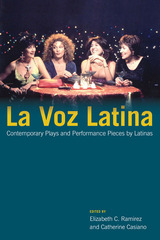 La Voz Latina: Contemporary Plays and Performance Pieces by Latinas
Edited by Elizabeth C. Ramirez and Catherine Casiano
University of Illinois Press, 2011 Elizabeth C. Ramírez and Catherine Casiano bring together a collection of plays and performance pieces by innovative Latina playwrights. Surveying Latina theatre in the United States from the 1980s to the twenty-first century, the editors present works displaying a variety of forms, themes, and genres, expanding the field of Latina theatre while situating it in the larger spectrum of American stage and performance studies. Ramírez and Casiano provide historical context and a production history for each work and a biography of, and artistic statement from, each playwright. Contributors: Yareli Arizmendi, Josefina Báez, The Colorado Sisters, Migdalia Cruz, Evelina Fernández, Cherríe Moraga, Carmen Peláez, Carmen Rivera, Celia H. Rodríguez, Diane Rodriguez, and Milcha Sanchez-Scott. The volume also includes commentary by Kathy Perkins and Caridad Svich.
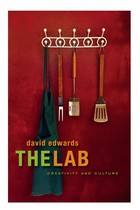 The Lab: Creativity and Culture
David Edwards
Harvard University Press, 2010 Never has the spirit of innovation been more highly valued than today. Around the world, people see the hard-to-teach skills of creativity as the lifeblood of cultural change and the engine of economic development. In The Lab, David Edwards presents a blueprint for revitalizing labs with "artscience"? creative thought that erases conventional boundaries between art and science?to produce innovations that otherwise might never see the light of day.At the heart of The Lab is "cultural incubation," whereby ideas translate with free-wheeling public exchange through a kind of innovation funnel—from educational settings (as in The Lab at Harvard University), to cultural settings (as at Le Laboratoire in Paris and elsewhere), to realizations as innovative products or humanitarian initiatives (within LaboGroup and other translation labs around the globe). With examples ranging from breathable chocolate (Le Whif) to contemporary art installations that explore the neuroscience of fear, Edwards shows how a measured-risk, seed-investment, mentorship-focused network of labs can allow exotic, unexpected ideas to flourish without being killed off at the first hint of impracticality.Unique to the innovation funnel is how creator risk is encouraged but also managed by mentors and others in each lab, so that the most daring ideas—lighting African villages with microbiotic lamps, or cleaning the air with plant-based filters—can emerge within passionate and sometimes inexperienced creative bands.Lively and engaging, replete with anecdotes that bring Edwards's unique personal experience in developing artscience labs to life, The Lab approaches innovation from exciting new angles, finding invigorating ways to repurpose our most creative assets—in scientific exploration, artistic imagination, and business model-building. David Edwards teaches at Harvard University in the School of Engineering and Applied Sciences. His creative work is described at www.davidideas.com.
 Lab Dog: What Global Science Owes American Beagles
Brad Bolman
University of Chicago Press, 2025 Tracing over a century of transformation in the relationship between humans and our “best friend,” from hunting companion to laboratory commodity to modern pet.
Intrepid, docile, and cloaked in coats of white, black, and tan, beagles were one of the most popular breeds in the United States in the twentieth century. From Snoopy to dog shows, many Americans loved and identified with beagles. But during the same period, as scientists searched for a standard research dog, beagles emerged as something else: an ideal animal for laboratory experimentation.
In Lab Dog, historian Brad Bolman explains how the laboratory dog became a subject of intense focus for twentieth-century scientists and charts the beagle’s surprising trajectory through global science. Following beagles as they moved from eugenics to radiobiology, pharmaceutical testing to Alzheimer’s studies, Lab Dog sheds new light on pivotal stories of twentieth-century science, including the Manhattan Project, tobacco controversies, contraceptive testing, and behavioral genetics research. Bolman shows how these experiments shaped our understanding of dogs as intelligent companions who deserve moral protection and socialization—and in some cases, daily medication. Compelling and accessible, Lab Dog tells the thorny story of the participation of beagles in science, including both their sacrifices and their contributions, and offers a glimpse into the future of animal experimentation.
Labor and Community: Mexican Citrus Worker Villages in a Southern California County, 1900-1950
Gilbert G. González
University of Illinois Press, 1994 The emergence, maturity, and decline of the southern California citrus industry is seen here through the network of citrus worker villages that dotted part of the state's landscape from 1910 to 1960. Labor and Community shows how Mexican immigrants shaped a partially independent existence within a fiercely hierarchical framework of economic and political relationships. González relies on a variety of published sources and interviews with longtime residents to detail the education of village children; the Americanization of village adults; unionization and strikes; and the decline of the citrus picker village and rise of the urban barrio. His insightful study of the rural dimensions of Mexican-American life prior to World War II adds balance to a long-standing urban bias in Chicano historiography.
 Labor and Democracy in Namibia, 1971–1996
Gretchen Bauer
Ohio University Press, 1998 In this compelling study of labor and nationalism during and after Namibia's struggle for liberation, Gretchen Bauer addresses the very difficult task of consolidating democracy in an independent Namibia. Labor and Democracy in Namibia, 1971-1996 argues that a vibrant and autonomous civil society is crucial to the consolidation of new democracies, and it identifies trade unions, in particular, as especially important organizations of civil society. In Namibia, however, trade unions have emerged from the liberation struggle and the first years of independence in a weakened state. Dr. Bauer gives a lucid explanation for this phenomenon by tracing the origins and evolution of the trade unions in Namibia and discusses the implications thereof for the future of democracy in Namibia.
Based on material not widely available before independence in 1990, this study takes a critical look at the nationalist movement in Namibia. Through the use of dozens of interviews with political leaders, trade unionists, community activists, and others, Bauer offers the controversial suggestion that there are many within the nationalist movement (now the ruling party in government) who would rather not see a strong trade union movement (or any other potential rival) emerge in independent Namibia.
Labor and the Chinese Revolution: Class Strategies and Contradictions of Chinese Communism, 1928–1948
S. Bernard Thomas
University of Michigan Press, 1983 In the two-decade period from 1928 to 1948, the proletarian themes and issues underlying the Chinese Communist Party’s ideological utterances were shrouded in rhetoric designed, perhaps, as much to disguise as to chart actual class strategies. Rhetoric notwithstanding, a careful analysis of such pronouncements is vitally important in following and evaluating the party’s changing lines during this key revolutionary period. The function of the “proletariat” in the complex of policy issues and leadership struggles which developed under the precarious circumstances of those years had an importance out of all proportion to labor’s relatively minor role in the post-1927 Communist led revolution. [1, 2]
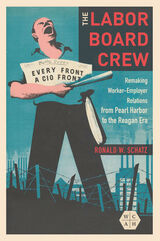 The Labor Board Crew: Remaking Worker-Employer Relations from Pearl Harbor to the Reagan Era
Ronald W. Schatz
University of Illinois Press, 2021 Ronald W. Schatz tells the story of the team of young economists and lawyers recruited to the National War Labor Board to resolve union-management conflicts during the Second World War. The crew (including Clark Kerr, John Dunlop, Jean McKelvey, and Marvin Miller) exerted broad influence on the U.S. economy and society for the next forty years. They handled thousands of grievances and strikes. They founded academic industrial relations programs. When the 1960s student movement erupted, universities appointed them as top administrators charged with quelling the conflicts. In the 1970s, they developed systems that advanced public sector unionization and revolutionized employment conditions in Major League Baseball. Schatz argues that the Labor Board vets, who saw themselves as disinterested technocrats, were in truth utopian reformers aiming to transform the world. Beginning in the 1970s stagflation era, they faced unforeseen opposition, and the cooperative relationships they had fostered withered. Yet their protégé George Shultz used mediation techniques learned from his mentors to assist in the integration of Southern public schools, institute affirmative action in industry, and conduct Cold War negotiations with Mikhail Gorbachev.
Labor Economics and Industrial Relations: Markets and Institutions
Clark Kerr and Paul D. Staudohar
Harvard University Press, 1994 In twenty-three original essays this book reviews the course of labor economics over the more than two centuries since the publication of Adam Smith’s Wealth of Nations. It fully examines the contending theories, changing environmental contexts, evolving issues, and varied policies affecting labor’s participation in the economy.
While the intellectual framework of the book looks partly to the past—explaining the labor factor in classical and neoclassical systems—its emphasis is on contemporary problems that will figure prominently in future developments, such as the operation of internal labor markets, dispute resolution, concession bargaining, equal employment opportunity, and individual labor contracting.
Labor, Free and Slave: Workingmen and the Anti-Slavery Movement in the United States
Bernard Mandel.Introduction by Brian Kelly
University of Illinois Press, 2006 A classic piece of Old Left scholarship made available to a new generation of students and activists Bernard Mandel's classic study provides a concise overview of the relationship between organized abolitionism and the fledgling labor movement in the period before the Civil War. Mandel argues that slavery reinforced the powerlessness of white workers North and South, and the racial divisions that it upheld rendered effective labor solidarity impossible. Deep distrust between abolitionists and the working classes, however, compelled Northern workers to find their own way into the antislavery ranks.
Labor Histories: Class, Politics, and the Working-Class Experience
Edited by Eric Arnesen, Julie Greene, and Bruce Laurie
University of Illinois Press, 1998 Is class outmoded as a basis for understanding labor history? This collection emphatically answers, "No!" These thirteen essays delve into subjects like migrant labor, religion, ethnicity, agricultural history, and gender. Written by former students of preeminent labor figure and historian David Montgomery, the works advance the argument that class remains indispensable to the study of working Americans and their place in the broad drama of our shared national history.
Labor in Crisis: THE STEEL STRIKE OF 1919
David Brody
University of Illinois Press, 1965 Conceived as a prologue to the 1930s industrial-union triumph in steel, Labor in Crisis explains the failure of unionization before the New Deal era and the reasons for mass-production unionism's eventual success.
Widely regarded as a failure, the great 1919 steel strike had both immediate and far-reaching consequences that are important to the history of American labor. It helped end the twelve-hour day, dramatized the issues of the rights to organize and to engage in collective bargaining, and forwarded progress toward the passage of the Wagner Act, which, in turn, helped trigger John L. Lewis's decision to launch the CIO.
Labor in Finland
Carl Erik Knoellinger
Harvard University Press Finland’s precarious proximity to Russia makes this small country a unique and revealing study in contemporary social and economic patterns. The author demonstrates that “in spite of Finland’s deep-rooted cultural kinship with Scandinavia…new factors, often political in nature, have affected the development of society very differently in each of these countries.” One of the most decisive differences, as his book makes clear, is the position of the Communist party in Finnish politics. In this first English book on the Finnish situation, Carl Erik Knoellinger makes perceptive analyses of detailed data on the varied aspects of his subject.
 Labor in State-Socialist Europe, 1945–1989: Contributions to a History of Work
Marsha Siefert
Central European University Press, 2020 Labor regimes under communism in East-Central Europe were complex, shifting, and ambiguous. This collection of sixteen essays offers new conceptual and empirical ways to understand their history from the end of World War II to 1989, and to think about how their experiences relate to debates about labor history, both European and global. The authors reconsider the history of state socialism by re-examining the policies and problems of communist regimes and recovering the voices of the workers who built them. The contributors look at work and workers in Albania, Bulgaria, Czechoslovakia, the German Democratic Republic, Hungary, Poland, Romania, and Yugoslavia. They explore the often contentious relationship between politics and labor policy, dealing with diverse topics including workers’ safety and risks; labor rights and protests; working women’s politics and professions; migrant workers and social welfare; attempts to control workers’ behavior and stem unemployment; and cases of incomplete, compromised, or even abandoned processes of proletarianization. Workers are presented as active agents in resisting and supporting changes in labor policies, in choosing allegiances, and in defining the very nature of work.
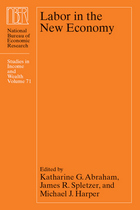 Labor in the New Economy
Edited by Katharine G. Abraham, James R. Spletzer, and Michael Harper
University of Chicago Press, 2010 As the structure of the economy has changed over the past few decades, researchers and policy makers have been increasingly concerned with how these changes affect workers. In this book, leading economists examine a variety of important trends in the new economy, including inequality of earnings and other forms of compensation, job security, employer reliance on temporary and contract workers, hours of work, and workplace safety and health.
In order to better understand these vital issues, scholars must be able to accurately measure labor market activity. Thus, Labor in the New Economy also addresses a host of measurement issues: from the treatment of outliers, imputation methods, and weighting in the context of specific surveys to evaluating the strengths and weaknesses of data from different sources. At a time when employment is a central concern for individuals, businesses, and the government, this volume provides important insight into the recent past and will be a useful tool for researchers in the future.
 Labor in the South
F. Ray Marshall
Harvard University Press In this first general history of organized labor in the south, F. Ray Marshall analyzes the main factors influencing union growth in the region from the earliest times to the present. Writing within the context of the south’s political, social, and economic history, the author provides valuable material on labor economics and labor relations.
An opening section lays the foundation for the analysis by reviewing the south’s unique economic and social characteristics, with a discussion of the beginnings of unions in the area and some of their activities and problems prior to 1928. The author then traces in detail the growth of key unions before 1932 and presents an evaluation of the 1930 southern organizing campaign of the AFL. An examination follows of the impact of the social ferment inspired by the New Deal. In Part IV, Marshall discusses union growth during and after the Second World War, with emphasis on the influence of the War Labor Board and other governmental agencies. Finally, in Part V he draws together all the main factors responsible for union expansion and union weakness in the south—economic forces, law and politics, union structure and philosophy, the characteristics of the workers, and social forces. In his concluding chapter the author assesses the possibilities for future union growth in the south through a projection of the trends brought to light in the previous chapters.
 Labor Internationalism, Volume 27
Michael Hanagan , ed.
Duke University Press Over the last twenty years, the worldwide expansion of markets has taken a toll on trade unions, dramatically changing the nature of the world’s workforce and significantly weakening labor’s political influence. Globalization has increasingly exposed workers to highly competitive global markets while weakening the consolidated political state on which labor unions have traditionally relied for support and protection. Acknowledging the unprecedented challenges facing trade unions and traditional labor movement, <I>Labor Internationalism</I>, a special issue of <a href="http://www.dukeupress.edu/ssh><I>Social Science History</I></a>, explores the new potential of one of the oldest tools in labor’s repertoire: international labor solidarity. </P><P>While drawing on the established social science explanations of labor solidarity, the contributors to this collection also modify and adapt these paradigms in new and innovative ways, presenting a stimulating example of how historical social scientists can respond to new problems. Focusing on labor solidarity case studies in the United States, Europe, and Latin America, these essays move beyond narrow immiserization/proletarianization-based explanations of solidarity that are increasingly inadequate in an era of globalization to consider labor solidarity as a by-product of interaction with other mechanisms and as part of a larger process that generates transnational collective action. </P><P>One essay explores how workers capitalized on changes in production processes during the 1998 General Motors strike in Flint, Michigan, prompting an unconventional show of transnational labor solidarity that echoed throughout the global factory. Another essay examines present-day cross-border solidarity actions involving U.S. and Latin American workers to emphasize that labor identity and solidarity are themselves products of public negotiation among differing groups of workers. Another contributor investigates the ways in which free trade agreements such as NAFTA have been critical in promoting the growth of “transnational activist networks” that have united trade unionists across North America and across social movement organizations. Other essays utilize case studies to investigate the tactical differences and similarities between social movements, labor movements, and union activities, a complicated relationship that can either hinder or encourage transnational labor solidarity.<BR>
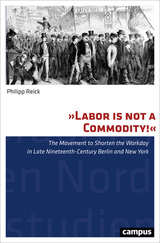 "Labor Is Not a Commodity!": The Movement to Shorten the Workday in Late Nineteenth-Century Berlin and New York
Philipp Reick
Campus Verlag, 2016 Analyzing the history of the movement to shorten the workday in late nineteenth-century New York City and Berlin, this book explores what Karl Polanyi has termed the “fictitious commodification” of labor. Despite the concept’s significance for present-day social movements, European and North American historiography has largely ignored the impact of free-market rhetoric on the formation of organized labor. Filling this gap, Philipp Reick provides both a contribution to the current reevaluation of Polanyian thought and theory and an interdisciplinary investigation of the trans-Atlantic transmission of ideas.
As Reick demonstrates, while on both sides of the Atlantic workers opposed the unchecked commodification of labor power as a violation of their political, social, and economic rights, the emerging movements for protection from commodification did not promote a universalist concept of rights. By showing that American and German workers drew upon a strikingly similar rationality when formulating demands, this book reveals that we cannot label either the US labor movement as a deviation from the supposed norm of industrial contestation or its German counterpart as the embodiment of that norm.
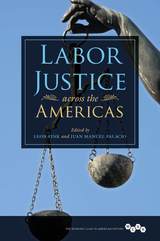 Labor Justice across the Americas
Leon Fink, Juan Palacio
University of Illinois Press, 2018 Opinions of specialized labor courts differ, but labor justice undoubtedly represented a decisive moment in worker 's history. When and how did these courts take shape? Why did their originators consider them necessary? Leon Fink and Juan Manuel Palacio present essays that address these essential questions. Ranging from Canada and the United States to Chile and Argentina, the authors search for common factors in the appearance of labor courts while recognizing the specific character of the creative process in each nation. Their transnational and comparative approach advances a global perspective on the various mechanisms for regulating industrial relations and resolving labor conflicts. The result is the first country-by-country study of its kind, one that addresses a defining shift in law in the first half of the twentieth century. Contributors: Rossana Barragán Romano, Angela de Castro Gomes, David Díaz-Arias, Leon Fink, Frank Luce, Diego Ortúzar, Germán Palacio, Juan Manuel Palacio, William Suarez-Potts, Fernando Teixeira da Silva, Victor Uribe-Urán, Angela Vergara, and Ronny J. Viales-Hurtado.
Labor Leaders in America
Edited by Melvyn Dubofsky and Warren Van Tine
University of Illinois Press, 1987 Here are the life stories of the men and women who led the labor movement in America from Reconstruction to recent times, from William H. Sylvis, the first major labor leader, to Cesar Chavez, who organized California's farm workers in the 1960s. In each profile, a leading authority provides a profile of the figure's life and work. Taken together, these short biographies provide a broad overview of the American labor movement that will appeal to students, interested readers, and specialists. Profiles include: William H. Sylvis, Terence V. Powderly, Samuel Gompers, Eugene V. Debs, William D. "Big Bill" Haywood, William Green, Rose Schneiderman, John L. Lewis, Sidney Hillman, Philip Murray, A. Philip Randolph, Walter Reuther, Jimmy Hoffa, George Meany, and Cesar Chavez
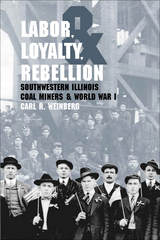 Labor, Loyalty, and Rebellion: Southwestern Illinois Coal Miners & World War I
Carl R. Weinberg
Southern Illinois University Press, 2005 On April 5, 1918, as American troops fought German forces on the Western Front, German American coal miner Robert Prager was hanged from a tree outside Collinsville, Illinois, having been accused of disloyal utterances about the United States and chased out of town by a mob. In Labor, Loyalty, and Rebellion: Southwestern Illinois Coal Miners and World War I, Carl R. Weinberg offers a new perspective on the Prager lynching and confronts the widely accepted belief among labor historians that workers benefited from demonstrating loyalty to the nation. The first published study of wartime strikes in southwestern Illinois is a powerful look at a group of people whose labor was essential to the war economy but whose instincts for class solidarity spawned a rebellion against mine owners both during and after the war. At the same time, their patriotism wreaked violent working-class disunity that crested in the brutal murder of an immigrant worker. Weinberg argues that the heightened patriotism of the Prager lynching masked deep class tensions within the mining communities of southwestern Illinois that exploded after the Great War ended.
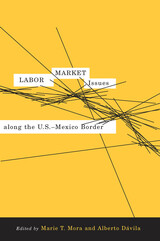 Labor Market Issues along the U.S.-Mexico Border
Edited by Marie T. Mora and Alberto Dávila
University of Arizona Press, 2009 Five million workers are employed in a variety of settings along the U.S.–Mexico border, yet labor market outcomes on each side often differ. U.S. workers tend to have low earnings and high unemployment compared with the rest of the country, while workers on the Mexican side of the border are often more prosperous than those in the interior. This book sheds new light on these socioeconomic differentials, along with other labor market issues affecting both sides of the border.
The contributors take up issues that dominate the current discourse— migration, trade, gender, education, earnings, and employment. They analyze labor conditions and their relationship to immigration, and also provide insight into income levels and population concentrations, the relative prosperity of Mexico’s border region, and NAFTA’s impact on trade and living conditions.
Drawing on demographic, economic, and labor data, the chapters treat topics ranging from historical context to directions for future research. They cover the importance of trade to both the United States and Mexico, salary differentials, the determinants of wages among Mexican immigrant women on the U.S. side, and the net effect of Mexican migration on the public coffers in U.S. border states. The book’s concluding policy prescriptions are geared toward improving conditions on the U.S. side without dampening the success of workers in Mexico.
Written to be equally accessible to social scientists, policy makers, and concerned citizens, this book deals with issues often overlooked in national policy discussions and can help readers better understand real-life conditions along the border. It dispels misconceptions regarding labor interdependence between the two countries while offering policy recommendations useful for improving the economic and social well-being of border residents.
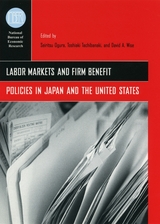 Labor Markets and Firm Benefit Policies in Japan and the United States
Edited by Seiritsu Ogura, Toshiaki Tachibanaki, and David A. Wise
University of Chicago Press, 2003 This volume, the fourth to result from a remarkably productive collaboration between the National Bureau of Economic Research and the Japan Center for Economic Research, presents a selection of thirteen high-caliber papers addressing issues in the employment practices, labor markets, and health, benefit, and pension policies of the United States and Japan.
After an opening chapter assessing the recent ascendance of the U.S. economy, papers diverge to tackle a range of specific issues. Focusing less on international comparison than on the assembly of high-quality research, contributors hone in on a variety of individual topics. Chapters delve into issues of youth employment, participatory employment, information sharing, fringe benefits, and drug coverage in Japan, as well as the dynamics of medical savings accounts, private insurance coverage, and benefit options in the U.S.
Like previous volumes stemming from NBER/JCER collaboration, this book represents a valuable mass of empirical data on some of the most notable employment and benefits issues in each nation, information that will both anchor and provoke scholarly analysis of these topics well into the future.
 Labor Markets in Action: Essays in Empirical Economics
Richard B. Freeman
Harvard University Press, 1989 Economists rarely perform controlled experiments, so how do they find out how markets function? In what ways does empirical economics contribute to our understanding of important and controversial social issues? What has been discovered about the operation of the labor markets in which nearly all of us participate? Labor Markets in Action addresses these questions in lively style. The topics cover issues of deep social concern, encompassing the jobs and wages of college graduates, discrimination and inner-city youth, homelessness, unionism, and the differences between U. S. labor market institutions and those of other developed countries, including Japan.
A thoughtful introduction to each essay reveals the human side of research on these controversial issues. Freeman lays out five guiding principles for empirical social science: to analyze situations in which markets undergo sharp exogenous shocks, creating "natural experiments"; to focus on fundamental first-order economic principles and behavior rather than on abstract fine points; to probe empirical findings with different data sets and alternative specifications; to gather new information from survey research rather than rely on existing data sets; to discuss issues and interpretations with workers, labor leaders, businessmen, and other market participants. With chapters that range from broad overviews of research to essays employing detailed statistical techniques, this book will appeal to economists, students, and policymakers concerned with how labor markets function and how economists go about their business of discovery without laboratory controls.
The Labor Movement in Wisconsin: A History
Robert W. Ozanne
Wisconsin Historical Society Press, 1984 Wisconsin’s workers and their leaders have always been in the vanguard of those concerned with social justice, fair labor practices, humane working conditions, and political equality. Professor Ozanne’s book, based upon years of research in newspapers, manuscripts, and the archives of both labor and management, provides a broad overview of an important chapter in Wisconsin history.
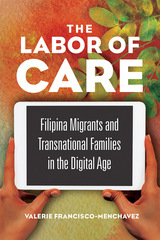 The Labor of Care: Filipina Migrants and Transnational Families in the Digital Age
Valerie Francisco-Menchavez
University of Illinois Press, 2018 For generations, migration moved in one direction at a time: migrants to host countries, and money to families left behind. The Labor of Care argues that globalization has changed all that. Valerie Francisco-Menchavez spent five years alongside a group of working migrant mothers. Drawing on interviews and up-close collaboration with these women, Francisco-Menchavez looks at the sacrifices, emotional and material consequences, and recasting of roles that emerge from family separation. She pays particular attention to how technologies like Facebook, Skype, and recorded video open up transformative ways of bridging distances while still supporting traditional family dynamics. As she shows, migrants also build communities of care in their host countries. These chosen families provide an essential form of mutual support. What emerges is a fascinating portrait of today's transnational family—sundered, yet inexorably linked over the distances by timeless emotions and new forms of intimacy.
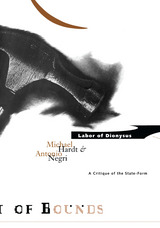 Labor Of Dionysus: A Critique of the State-Form
Michael Hardt
University of Minnesota Press, 1994 “Labor is the living, form-giving fire,” Marx wrote. “It is the transitoriness of things, their temporality, as their transformation by living time.” How is it, then, that labor, with all its life-affirming potential, has become the means of capitalist discipline, exploitation, and domination in modern society? The authors expose and pursue this paradox through a systematic analysis of the role of labor in the processes of capitalist production and in the establishment of capitalist legal and social institutions. Critiquing liberal and socialist notions of labor and institutional reform from a radical democratic perspective, Hardt and Negri challenge the state-form itself. In the twentieth century, labor has become central to the material and formal constitution of the State, as a complex nexus of value and right. And yet, in living labor and social cooperation, which cut across the divisions of workdays and wage relations, the authors identify a total critique of capitalist practice as well, presenting not only the negation of the present social order but also the affirmation of an alternative system of value, norms, and desires. The forms in which this potential is expressed, from the social movements of the 1960s to those of the 1990s, are the “prerequisites of communism” already existing in contemporary society.
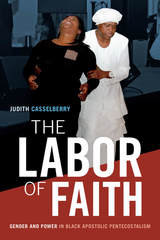 The Labor of Faith: Gender and Power in Black Apostolic Pentecostalism
Judith Casselberry
Duke University Press, 2017 In The Labor of Faith Judith Casselberry examines the material and spiritual labor of the women of the Church of Our Lord Jesus Christ of the Apostolic Faith, Inc., which is based in Harlem and one of the oldest and largest historically Black Pentecostal denominations in the United States. This male-headed church only functions through the work of the church's women, who, despite making up three-quarters of its adult membership, hold no formal positions of power. Casselberry shows how the women negotiate this contradiction by using their work to produce and claim a spiritual authority that provides them with a particular form of power. She also emphasizes how their work in the church is as significant, labor intensive, and critical to their personhood, family, and community as their careers, home and family work, and community service are. Focusing on the circumstances of producing a holy black female personhood, Casselberry reveals the ways twenty-first-century women's spiritual power operates and resonates with meaning in Pentecostal, female-majority, male-led churches.
Labor of Fire: The Ontology of Labor between Economy and Culture
Bruno Gullì
Temple University Press, 2005 In Labor of Fire, Bruno Gullì offers a timely and much needed re-examination of the concept of labor. Distinguishing between "productive labor" (working for money or subsistence) and "living labor" (working for artistic creation), Gullì convincingly argues for a definition of work that recognizes the importance of artistic and social creativity to our definition of labor and the self.
Gullì lays the groundwork for his book by offering a critique of productive labor, and then maps out his productive/living labor distinction in detail, reviewing the work of Marx and others.
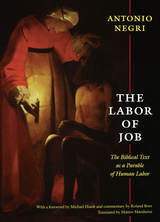 The Labor of Job: The Biblical Text as a Parable of Human Labor
Antonio Negri
Duke University Press, 2009 In The Labor of Job, the renowned Marxist political philosopher Antonio Negri develops an unorthodox interpretation of the Old Testament book of Job, a canonical text of Judeo-Christian thought. In the biblical narrative, the pious Job is made to suffer for no apparent reason. The story revolves around his quest to understand why he must bear, and why God would allow, such misery. Conventional readings explain the tale as an affirmation of divine transcendence. When God finally speaks to Job, it is to assert his sovereignty and establish that it is not Job’s place to question what God allows. In Negri’s materialist reading, Job does not recognize God’s transcendence. He denies it, and in so doing becomes a co-creator of himself and the world. The Labor of Job was first published in Italy in 1990. Negri began writing it in the early 1980s, while he was a political prisoner in Italy, and it was the first book he completed during his exile in France (1983–97). As he writes in the preface, understanding suffering was for him in the early 1980s “an essential element of resistance. . . . It was the problem of liberation, in prison and in exile, from within the absoluteness of Power.” Negri presents a Marxist interpretation of Job’s story. He describes it as a parable of human labor, one that illustrates the impossibility of systems of measure, whether of divine justice (in Job’s case) or the value of labor (in the case of late-twentieth-century Marxism). In the foreword, Michael Hardt elaborates on this interpretation. In his commentary, Roland Boer considers Negri’s reading of the book of Job in relation to the Bible and biblical exegesis. The Labor of Job provides an intriguing and accessible entry into the thought of one of today’s most important political philosophers.
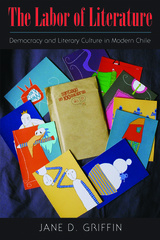 The Labor of Literature: Democracy and Literary Culture in Modern Chile
Jane D. Griffin
University of Massachusetts Press, 2016 By producing literature in nontraditional forms—books made of cardboard trash, posters in subway stations, miniature shopping bags, digital publications, and even children's toys—Chileans have made and circulated literary objects in defiance of state censorship and independent of capitalist definitions of value. In The Labor of Literature Jane D. Griffin studies amateur and noncommercial forms of literary production in Chile that originated in response to authoritarian state politics and have gained momentum throughout the postdictatorship period. She argues that such forms advance a model of cultural democracy that differs from and sometimes contradicts the model endorsed by the state and the market.
By examining alternative literary publications, Griffin recasts the seventeen-year Pinochet dictatorship as a time of editorial experimentation despite widespread cultural oppression and shows how grassroots cultural activism has challenged government-approved corporate publishing models throughout the postdictatorship period. Griffin's work also points to the growing importance of autogestión, or do-it-yourself cultural production, where individuals combine artisanal forms with new technologies to make and share creative work on a global scale.
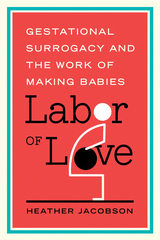 Labor of Love: Gestational Surrogacy and the Work of Making Babies
Jacobson, Heather
Rutgers University Press, 2016 While the practice of surrogacy has existed for millennia, new fertility technologies have allowed women to act as gestational surrogates, carrying children that are not genetically their own. While some women volunteer to act as gestational surrogates for friends or family members, others get paid for performing this service. The first ethnographic study of gestational surrogacy in the United States, Labor of Love examines the conflicted attitudes that emerge when the ostensibly priceless act of bringing a child into the world becomes a paid occupation. Heather Jacobson interviews not only surrogate mothers, but also their family members, the intended parents who employ surrogates, and the various professionals who work to facilitate the process. Seeking to understand how gestational surrogates perceive their vocation, she discovers that many regard surrogacy as a calling, but are reluctant to describe it as a job. In the process, Jacobson dissects the complex set of social attitudes underlying this resistance toward conceiving of pregnancy as a form of employment. Through her extensive field research, Jacobson gives readers a firsthand look at the many challenges faced by gestational surrogates, who deal with complicated medical procedures, delicate work-family balances, and tricky social dynamics. Yet Labor of Love also demonstrates the extent to which advances in reproductive technology are affecting all Americans, changing how we think about maternity, family, and the labor involved in giving birth. For more, visit http://www.heatherjacobsononline.com/
 Labor Politics American Style: The California State Federation of Labor
Philip Taft
Harvard University Press State federations of labor have been the political arms of organized labor for more than 100 years and the California State Federation is one of the most interesting and representative examples. Philip Taft traces the activities, policies, and problem of the Federation from its beginnings in 1901 until the merger of the AFL-CIO in 1958. The attitudes on migrant labor and the controversial McNamara and Mooney cases are discussed as well as the changing views of the Federation over the years. In the process, the author explores the reasons why organized labor in the United States did not commit itself to a third party.
Instead of reviewing the debates of national labor leaders, Taft focuses on the sentiments and needs of workers at the grass roots level and examines their critical role in determining the character of organized labor’s political tactics. He shows that at no time did the American labor movement eschew politics; it always understood the importance of legislation for social advancement. Starting with modest funds and little support, the California State Federation became, relatively early in its history, the primary spokesman on legislative matters for the workers in the state. Its efforts, Taft demonstrates, were not limited to legislation affecting the narrow interests of a special group, but encompassed matters concerning the entire community. As the influence of the Federation grew and its aims broadened, it came to rely heavily on the sympathy and backing of the state legislative and executive branches of government.
Taft explains the methods by which Federation programs were and are developed and how candidates are endorsed. He surveys the expanding task of defending legislation before administrative bodies and courts. Throughout his study, he emphasizes the significance of the California Federation as a political institution and relates its development to the growth of the labor movement in the United States.
 The Labor Question in America: Economic Democracy in the Gilded Age
Roseanne Currarino
University of Illinois Press, 2011 In The Labor Question in America: Economic Democracy in the Gilded Age, Rosanne Currarino traces the struggle to define the nature of democratic life in an era of industrial strife. As Americans confronted the glaring disparity between democracy's promises of independence and prosperity and the grim realities of economic want and wage labor, they asked, "What should constitute full participation in American society? What standard of living should citizens expect and demand?" Currarino traces the diverse efforts to answer to these questions, from the fledgling trade union movement to contests over immigration, from economic theory to popular literature, from legal debates to social reform. The contradictory answers that emerged--one stressing economic participation in a consumer society, the other emphasizing property ownership and self-reliance--remain pressing today as contemporary scholars, journalists, and social critics grapple with the meaning of democracy in post-industrial America.
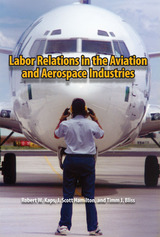 Labor Relations in the Aviation and Aerospace Industries
Robert W. Kaps, J. Scott Hamilton, Timm J. Bliss
Southern Illinois University Press, 2012
In this textbook designed for courses on aviation labor relations, the authors-experts with many years of experience in these sectors-examine and evaluate the labor process for all aspects of the aviation and aerospace industries, including aerospace manufacturing, airlines, general aviation, federal and state administrative agencies, and public airports.
Divided into three parts-Public Policy and Labor Law; Principles, Practices and Procedures in Collective Bargaining and Dispute Resolution; and the Changing Labor Relations Environment-the book provides an overview of the industries and the development of US labor law and policy, then explores the statutory, regulatory, and case laws applicable to each industry segment before concluding with an examination of current and developing issues and trends. The authors present the evolution of aviation and aerospace labor laws, going as far back as the early nineteenth century to lay the historical foundation, and cover the development and main features of the principal statutes governing labor relations in the United States today, the Railway Labor Act, the National Labor Relations Act, and the Civil Service Reform Act. They also investigate the growth of the industries and their impact on labor relations, as well as the current issues and challenges facing management and labor in each segment of this dynamic, sometimes volatile, business and their implications for collective bargaining. Twenty case studies not only illuminate practical applications of such fundamental concepts as unfair labor practices and unions' duty of fair representation but also enliven the subject, preparing the reader to use the concepts in real-world decision making.
A study guide with review questions, online assignments, supplemental readings, and exercises is available for students. For those teachers using the textbook in their courses, there is an instructor's manual with additional resources for developing courses in the classroom, online, or by blended learning, as well as a variety of assignments and materials to enhance and vary the mock negotiation exercise.
A revision and expansion of Robert W. Kaps's Air Transport Labor Relations, this outstanding new volume provides students and teachers with valuable information and perspectives on industries that are highly dependent on technologically skilled labor. Labor Relations in the Aviation and Aerospace Industries offers a sweeping and thorough treatment of labor relations, public policy, law, and practice and is the definitive work on the labor process in the aviation and aerospace sectors.
Labor Relations in the Aviation and Aerospace Industries: Study Guide
Robert W. Kaps, J. Scott Hamilton, Timm J. Bliss
Southern Illinois University Press, 2012 This Study Guide is designed to be used with the textbook Labor Relations in the Aviation and Aerospace Industries. It is intended to assist students in comprehending basic terminology and principles of labor relations and the law, to relate those principles to unique features of the aviation and aerospace industry, and to prepare for the kinds of labor relations–related decisions students will soon be making as aviation professionals, whether in private or public sector employment. It includes review questions, online assignments, supplemental readings, and exercises.
Labor Relations in the Lithographic Industry
Fred C. Munson
Harvard University Press Describing the structure of industrial relations in the lithographic industry, the author explains its separation from the industrial relations system in printing, showing the instability of present collective bargaining practices and how the division of crafts is likely to change. Fred Munson integrates data from trade associations, union surveys, and government sources whose incompatibility has been a familiar complaint. Providing a typical economic model, this detailed study of lithographic industrial relations is relevant to the entire field of union-management relations today.
Labor Revolt In Alabama: The Great Strike of 1894
Robert David Ward
University of Alabama Press, 1965 The gripping story of the 1894 Alabama coal miners strike
The Alabama coal miners’ strike of 1894 to gain improved working conditions and to protect themselves from wage reductions. The authors recount the depression of the early 1890s, which set the stage for the strike, and the subsequent use of convict labor, which became a catalyst. The gripping story of the strike includes the dramatic decision to strike and corporate attempts to break the strike by the use of company guards and “scab” labor. In Alabama corporate bosses inflamed passions further by deploying African American “black leg” workers, ultimately requiring the deployment of the state militia to restore peace.
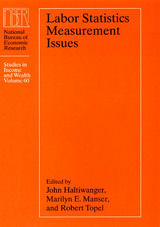 Labor Statistics Measurement Issues
Edited by John Haltiwanger, Marilyn E. Manser, and Robert H. Topel
University of Chicago Press, 1998 Rapidly changing technology, the globalization of markets, and the declining role of unions are just some of the factors that have led to dramatic changes in working conditions in the United States. Little attention has been paid to the difficult measurement problems underlying analysis of the labor market. Labor Statistics Measurement Issues helps to fill this gap by exploring key theoretical and practical issues in the measurement of employment, wages, and workplace practices.
Some of the chapters in this volume explore the conceptual issues of what is needed, what is known, or what can be learned from existing data, and what needs have not been met by available data sources. Others make innovative uses of existing data to analyze these topics. Also included are papers examining how answers to important questions are affected by alternative measures used and how these can be reconciled. This important and useful book will find a large audience among labor economists and consumers of labor statistics.
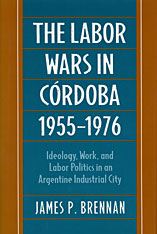 The Labor Wars in Córdoba, 1955–1976: Ideology, Work, and Labor Politics in an Argentine Industrial City
James P. Brennan
Harvard University Press, 1994 Córdoba is Argentina’s second-largest city, a university town that became the center of its automobile industry. In the decade following the overthrow of Juan Perón’s government in 1955, the city experienced rapid industrial growth. The arrival of IKA-Renault and Fiat fostered a particular kind of industrial development and created a new industrial worker of predominantly rural origins. Former farm boys and small-town dwellers were thrust suddenly into the world of the modern factory and the multinational corporation.
The domination of the local economy by a single industry and the prominent role played by the automobile workers’ unions brought about the greatest working-class protest in postwar Latin American history, the 1969 Cordobazo. Following the Cordobazo, the local labor movement was one characterized by intense militancy and determined opposition to both authoritarian military governments and the Peronist trade union bureaucracy. These labor wars have been mythologized as a Latin American equivalent to the French student strikes of May–June 1968 and the Italian “hot summer” of the same period. Analyzing these events in the context of recent debates on Latin American working-class politics, James Brennan demonstrates that the pronounced militancy and even political radicalism of the Cordoban working class were due not only to Argentina’s changing political culture but also to the dynamic relationship between the factory and society during those years.
Brennan draws on corporate archives in Argentina, France, and Italy, as well as previously unknown union archives. Readers interested in Latin American studies, labor history, industrial relations, political science, industrial sociology, and international business will all find value in this important analysis of labor politics.
 Laboratory Epistemologies: A Hands-On Perspective
Jenny Boulboullé
Duke University Press, 2024 In Laboratory Epistemologies: A Hands-On Perspective, Jenny Boulboullé examines the significance of hands-on experiences in contemporary life sciences laboratories. Addressing the relationship between contemplation and manipulation in epistemology, Boulboullé combines participant observations in molecular genetics labs and microbiological cleanrooms with a longue durée study of the history and philosophy of science. She radically rereads Descartes’s key epistemological text Meditations on First Philosophy, reframing the philosopher as a hands-on knowledge maker. With this reading, Boulboullé subverts the pervasive modern conception of the disembodied knower and puts the hands-on experimenter at the heart of life sciences research. In so doing, she contributes a theoretical model for understanding how life processes on cellular and molecular levels are manually produced in today’s techno-scientific spaces. By reassessing the Cartesian legacy and arguing that epistemology should be grounded in the standpoint of a hands-on practitioner, Boulboullé offers the philosophical and historical foundation to understand and study contemporary life sciences research as multisensory embodied practices.
 The Laboratory Mouse: Its Origin, Heredity, and Culture
Clyde E. Keeler
Harvard University Press Varieties of the house mouse, long reared in captivity as pets, in recent years acquired importance as instruments of scientific investigation. Mice are used extensively by medical schools and hospitals in the diagnosis of disease and in the preparation or standardization of serums to combat disease. They have also been of great service in the study of heredity because of their short life-cycle, the large number of their known inherited characters, and the assurance that laws of heredity valid for mice are likely to be valid for man since he also is a mammal. Extensive use of mice by scientists leads to a desire on their part to learn as much as possible about mice, including their origin and history as a domestic animal, their uses in times past and at present, and the best methods of rearing them and keeping them free from disease. All this and much more Dr. Keeler has discussed in this timely and well-illustrated volume, which will be particularly welcome to students of genetics as a companion volume to Castle’s Genetics and Eugenics and The Genetics of Domestic Rabbits.
 A Laboratory of Her Own: Women and Science in Spanish Culture
Victoria L. Ketz
Vanderbilt University Press, 2021 A Laboratory of Her Own gathers diverse voices to address women's interaction with STEM fields in the context of Spanish cultural production. This volume focuses on the many ways the arts and humanities provide avenues for deepening the conversation about how women have been involved in, excluded from, and represented within the scientific realm.
While women's historic exclusion from STEM fields has been receiving increased scrutiny worldwide, women within the Spanish context have been perhaps even more peripheral given the complex sociocultural structures emanating from gender norms and political ideologies dominant in nineteenth- and twentieth-century Spain. Nonetheless, Spanish female cultural producers have long been engaged with science and technology, as expressed in literature, art, film, and other genres. Spanish arts and letters offer diverse representations of the relationships between women, gender, sexuality, race, and STEM fields.
A Laboratory of Her Own studies representations of a diverse range of Spanish women and scientific cultural products from the late nineteenth through the twenty-first centuries. STEM topics include the environment, biodiversity, temporal and spatial theories, medicine and reproductive rights, neuroscience, robotics, artificial intelligence, and quantum physics. These scientific themes and other issues are analyzed in narratives, paintings, poetry, photographs, science fiction, medical literature, translation, newswriting, film, and other forms.
 A Laboratory of Transnational History: Ukraine and Recent Ukrainian Historiography
Georgiy Kasianov
Central European University Press, 2009 A first attempt to present an approach to Ukrainian history which goes beyond the standard 'national narrative' schemes, predominant in the majority of post-Soviet countries after 1991, in the years of implementing 'nation-building projects'.An unrivalled collection of essays by the finest scholars in the field from Ukraine, Russia, USA, Germany, Austria and Canada, superbly written to a high academic standard. The various chapters are methodologically innovative and thought-provoking. The biggest Eastern European country has ancient roots but also the birth pangs of a new autonomous state. Its historiography is characterized by animated debates, in which this book takes a definite stance. The history of Ukraine is not written here as a linear, teleological narrative of ethnic Ukrainians but as a multicultural, multidimensional history of a diversity of cultures, religious denominations, languages, ethical norms, and historical experience. It is not presented as causal explanation of 'what has to have happened' but rather as conjunctures and contingencies, disruptions, and episodes of 'lack of history.'
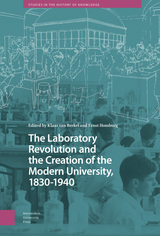 The Laboratory Revolution and the Creation of the Modern University, 1830-1940
Klaas van Berkel
Amsterdam University Press, 2023 The modern research university originated in Europe in the second half of the nineteenth century, largely due to the creation and expansion of the teaching and research laboratory. The universities and the sciences underwent a laboratory revolution that fundamentally changed the nature of both. This revolutionary development began in chemistry, where Justus Liebig is credited with systematically employing his students in his ongoing research during the 1830s. Later, this development spread to other fields, including the social sciences and the humanities. The consequences for the universities were colossal. The expansion of the laboratories demanded extensive new building programs, reshaping the outlook of the university. The social structure of the university also diversified because of this laboratory expansion, while what it meant to be a scientist changed dramatically. This volume explores the spatial, social, and cultural dimensions of the rise of the modern research laboratory within universities and their consequent reshaping.
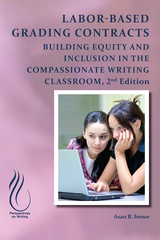 Labor-Based Grading Contracts: Building Equity and Inclusion in the Compassionate Classroom
Asao B. Inoue
University Press of Colorado, 2023 In the second edition of Labor-Based Grading Contracts, Asao B. Inoue refines his exploration of labor-based grading contracts in the writing classroom. Drawing on antiracist teaching practices, he argues that labor-based grading contracts offer a compassionate approach that is strongly grounded in social justice work. Updated with a new foreword and revised chapters, the book offers a meditation on how Inoue’s use of Freirean problem-posing led him to experiment with grading contracts. The result is a robust Marxian theory of labor that considers Hannah Arendt’s theory of labor-work-action and Barbara Adam’s concept of “timescapes.” The heart of the book details the theoretical and practical ways labor-based grading contracts can be used and assessed for effectiveness in classrooms and programs. Inoue concludes his exploration of labor-based grading by moving outside the classroom, considering how assessing writing in the socially just ways he offers in the book may provide a way to address the violence and discord seen in the world today.
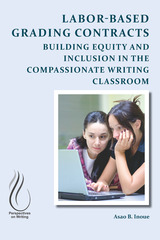 Labor-Based Grading Contracts: Building Equity and Inclusion in the Compassionate Writing Classroom
Asao B. Inoue
University Press of Colorado, 2019 In Labor-Based Grading Contracts, Asao B. Inoue argues for the use of labor-based grading contracts along with compassionate practices to determine course grades as a way to do social justice work with students. He frames this practice by considering how Freirean problem-posing led him to experiment with grading contracts and explore the literature on grading contracts. Inoue offers a robust Marxian theory of labor that considers Hannah Arendt's theory of labor-work-action and Barbara Adam's concept of "timescapes." The heart of the book details the theoretical and practical ways labor-based grading contracts can be used and assessed for effectiveness in classrooms and programs. Inoue concludes the book by moving outside the classroom, considering how assessing writing in the socially just ways he offers in the book may provide a way to address the violence and discord seen in the world today.
Labored in Papyrus Leaves: Perspectives on an Epigram Collection Attributed to Posidippus (P. Mil. Vogl. VIII 309)
Benjamin Acosta-Hughes
Harvard University Press, 2004 This colloquium volume celebrates a new Hellenistic epigram collection attributed to the third-century B.C.E. poet Posidippus, one of the most significant literary finds in recent memory. Included in this collection are an unusual variety of voices and perspectives: papyrological, art historical, archaeological, historical, literary, and aesthetic. These texts are considered as individual poems and as collective artifact, an early poetry book. The volume will be of interest to readers of Greek and Latin epigram, students of the Hellenistic period, and all readers interested in the aesthetics of poetry collection and the evolution of the poetry book in antiquity.
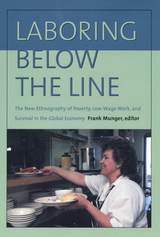 Laboring Below the Line: The New Ethnography of Poverty, Low-Wage Work, and Survival in the Global Economy
Frank Munger
Russell Sage Foundation, 2002 As the distribution of wealth between rich and poor in the United States grew more and more unequal over the past twenty years, this economic gap assumed a life of its own in the popular culture. The news and entertainment media increasingly portrayed the lives of the poor with such stereotypes as the lazy welfare mother and the thuggish teen, offering Americans few ways to learn how the "other half" really lives. Laboring Below the Line works to bridge this gap by synthesizing a wide range of qualitative scholarship on the working poor. The result is a coherent, nuanced portrait of how life is lived below the poverty line, and a compelling analysis of the systemic forces in which poverty is embedded, and through which it is perpetuated. Laboring Below the Line explores the role of interpretive research in understanding the causes and effects of poverty. Drawing on perspectives of the working poor, welfare recipients, and marginally employed men and women, the contributors—an interdisciplinary roster of ethnographers, oral historians, qualitative sociologists, and narrative analysts—dissect the life circumstances that affect the personal outlook, ability to work, and expectations for the future of these people. For example, Carol Stack views the work aspirations of an Oakland teenager for whom a job is important, even though it strains her academic performance. And Ruth Buchanan looks at low-wage telemarketing workers who are attempting to move up the economic ladder while balancing family, education, and other important commitments. What emerges is a compelling picture of low-wage workers—one that illustrates the precarious circumstances of individuals struggling with the economic conditions and institutions that surround them Each chapter also explores the capacity for economic survival from a different angle, with ancillary commentary complementing the ethnographies with perspectives from other fields of study, such as economics. At this moment of governmental retrenchment, ethnography's complex, nonstereotypical portraits of individual people fighting against poverty are especially important. Laboring Below the Line reveals the ambiguities of real lives, the potential for individuals to change in unexpected ways, and the even greater intricacy of the collective life of a community.
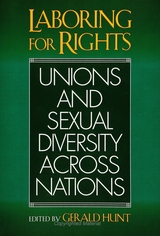 Laboring For Rights
edited by Gerald Hunt
Temple University Press, 1999 How do unions around the world respond to issues raised by sexual minorities? Much as been written on labor's response to issues raised by women and racial minorities, but there has been little work done on labor's engagement with gays, lesbians, bisexuals, and the transgendered. The original essays in this collection attempt to fill that void by bringing together a group of experts who examine labor's response to such issues as benefits for same-sex partners, anti-discrimination language in collective agreements, and education. Speaking from a variety of racial backgrounds, sexual orientations, and political views, the contributors bring their unique personal perspectives and scholarly approaches to this groundbreaking book.
The chapters included in Laboring for Rights give a global vision to the increasingly important subject of equity in the workplace. They offer a much-needed look at labor's involvement with current international workplace conditions from such diverse countries as the United States, Canada, Australia, Germany, Britain, France, the Netherlands, and South Africa, as well as parts of the South Pacific. Some of these countries have strong and progressive labor unions; some, like the U.S., have relatively weak labor organizations. But whatever the context, as these articles demonstrate, there seems to be a growing and in some instances prospering gay/lesbian labor alliance in many parts of the world.
Laboring for Rights is a pioneering text in an important new area of labor study. It will engage readers interested in equality in the workplace, labor and organizational studies, gay and lesbian activism, and international, comparative studies.
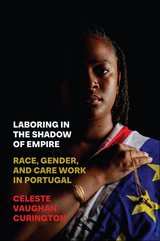 Laboring in the Shadow of Empire: Race, Gender, and Care Work in Portugal
Celeste Vaughan Curington
Rutgers University Press, 2024 Winner of the ASA Race, Gender, and Class section's Distinguished Contribution to Scholarship Award Winner of the ASA Racial and Ethnic Minorities section’s Oliver Cromwell Cox Book Award Laboring in the Shadow of Empire: Race, Gender, and Care Work in Portugal examines the everyday lives of an African-descendant care service workforce that labors in an ostensibly “anti-racial” Europe and against the backdrop of the Portuguese colonial empire. While much of the literature on global care work has focused on Asian and Latine migrant care workers, there is comparatively less research that explicitly examines African care workers and their migration histories to Europe. Sociologist Celeste Vaughan Curington focuses on Portugal—a European setting with comparatively liberal policies around family settlement and naturalization for migrants. In this setting, rapid urbanization in the late twentieth century, along with a national push to reconcile work and family, has shaped the growth of paid home care and cleaning service industries. Many researchers focus on informal work settings, where immigrant rights are restricted and many workers are undocumented or without permanent residence status. Curington instead examines workers who have accessed citizenship or permanent residence status and also explores African women’s experiences laboring in care and service industries in the formal market, revealing how deeply colonial and intersectional logics of a racialized and international division of reproductive labor in Portugal render these women “hyper-invisible” and “hyper-visible” as “appropriate” workers in Lisbon.
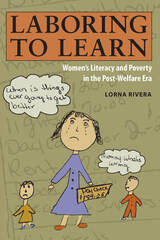 Laboring to Learn: Women's Literacy and Poverty in the Post-Welfare Era
Lorna Rivera
University of Illinois Press, 2007 The American adult education system has become an alternative for school dropouts, with some state welfare policies requiring teen mothers and women without high school diplomas to participate in adult education programs to receive aid. Currently, low-income women of color are more likely to be enrolled in the lowest levels of adult basic education. Very little has been published about women's experiences in these mandatory programs and whether the programs reproduce the conditions that forced women to drop out in the first place. Lorna Rivera bridges the gap with this important study, the product of ten years' active ethnographic research with formerly homeless women who participated in adult literacy education classes before and after welfare reform. She draws on rich interviews with organizers and participants in the Adult Learners Program at Project Hope, a women's shelter and community development organization in Boston's Dudley neighborhood, one of the poorest in the city. Analyzing the web of ideological contradictions regarding "work first" welfare reform policies, Rivera argues that poverty is produced and reproduced when women with low literacy skills are pushed into welfare-to-work programs and denied education. She examines how various discourses about individual choice and self-sufficiency shape the purposes of literacy, how low-income women express a sense of personal responsibility for being poor, and how neoliberal ideologies and practices compromise the goals of critical literacy programs. Throughout this study, the voices and experiences of formerly homeless women challenge cultural stereotypes about poor women, showing in personal and structural terms how social and economic forces shape and restrict opportunities for low-income women of color.
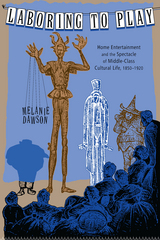 Laboring to Play: Home Entertainment and the Spectacle of Middle-Class Cultural Life, 1850-1920
Melanie Dawson
University of Alabama Press, 2005 A compelling analysis of how "middling" Americans entertained themselves and how these entertainments changed over time.
The changing styles of middle-class home entertainments, Melanie Dawson argues, point to evolving ideas of class identity in U.S. culture. Drawing from 19th- and early-20th-century fiction, guidebooks on leisure, newspaper columns, and a polemical examination of class structures, Laboring to Play interrogates the ways that leisure performances (such as parlor games, charades, home dramas, and tableaux vivants) encouraged participants to test out the boundaries that were beginning to define middle-class lifestyles.
From 19th-century parlor games involving grotesque physical contortions to early-20th-century recitations of an idealized past, leisure employments mediated between domestic and public spheres, individuals and class-based affiliations, and ideals of egalitarian social life and visible hierarchies based on privilege. Negotiating these paradigms, home entertainments provided their participants with unique ways of performing displays of individual ambitions within a world of polite social interaction.
Laboring to Play deals with subjects as wide ranging as social performances, social history (etiquette and gentility), literary history, representations of childhood, and the history of the book.
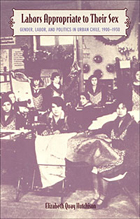 Labors Appropriate to Their Sex: Gender, Labor, and Politics in Urban Chile, 1900–1930
Elizabeth Quay Hutchison
Duke University Press, 2001 In Labors Appropriate to Their Sex Elizabeth Quay Hutchison addresses the plight of working women in early twentieth-century Chile, when the growth of urban manufacturing was transforming the contours of women’s wage work and stimulating significant public debate, new legislation, educational reform, and social movements directed at women workers. Challenging earlier interpretations of women’s economic role in Chile’s industrial growth, which took at face value census figures showing a dramatic decline in women’s industrial work after 1907, Hutchison shows how the spread of industrial sweatshops and changing definitions of employment in the census combined to make female labor disappear from census records at the same time that it was in fact burgeoning in urban areas. In addition to population and industrial censuses, Hutchison culls published and archival sources to illuminate such misconceptions and to reveal how women’s paid labor became a locus of anxiety for a society confronting social problems—both real and imagined—that were linked to industrialization and modernization. The limited options of working women were viewed by politicians, elite women, industrialists, and labor organizers as indicative of a society in crisis, she claims, yet their struggles were also viewed as the potential springboard for reform. Labors Appropriate to Their Sex thus demonstrates how changing norms concerning gender and work were central factors in conditioning the behavior of both male and female workers, relations between capital and labor, and political change and reform in Chile. This study will be rewarding for those whose interests lie in labor, gender, or Latin American studies; as well as for those concerned with the histories of early feminism, working-class women, and sexual discrimination in Latin America.
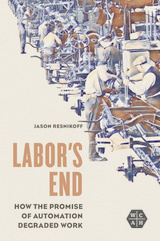 Labor's End: How the Promise of Automation Degraded Work
Jason Resnikoff
University of Illinois Press, 2022 Labor's End traces the discourse around automation from its origins in the factory to its wide-ranging implications in political and social life. As Jason Resnikoff shows, the term automation expressed the conviction that industrial progress meant the inevitable abolition of manual labor from industry. But the real substance of the term reflected industry's desire to hide an intensification of human work--and labor's loss of power and protection--behind magnificent machinery and a starry-eyed faith in technological revolution. The rhetorical power of the automation ideology revealed and perpetuated a belief that the idea of freedom was incompatible with the activity of work. From there, political actors ruled out the workplace as a site of politics while some of labor's staunchest allies dismissed sped-up tasks, expanded workloads, and incipient deindustrialization in the name of technological progress. A forceful intellectual history, Labor's End challenges entrenched assumptions about automation's transformation of the American workplace.
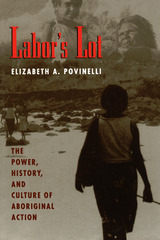 Labor's Lot: The Power, History, and Culture of Aboriginal Action
Elizabeth A. Povinelli
University of Chicago Press, 1994 How does an Aboriginal community see itself, its work, and its place on the land? Elizabeth Povinelli goes to the Belyuen community of northern Australia to show how it draws from deep connections between labor, language, and the landscape. Her findings challenge Western notions of "productive labor" and longstanding ideas about the role of culture in subsistence economies.
In Labor's Lot, Povinelli shows how everyday activities shape Aboriginal identity and provide cultural meaning. She focuses on the Belyuen women's interactions with the countryside and on Belyuen conflicts with the Australian government over control of local land. Her analysis raises serious questions about the validity of Western theories about labor and culture and their impact on Aboriginal society.
Povinelli's focus on women's activities provides an important counterpoint to recent works centering on male roles in hunter-gatherer societies. Her unique "cultural economy" approach overcomes the dichotomy between the two standard approaches to these studies. Labor's Lot will engage anyone interested in indigenous peoples or in the relationship between culture and economy in contemporary social practice.
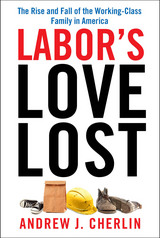 Labor's Love Lost: The Rise and Fall of the Working-Class Family in America
Andrew J. Cherlin is the Benjamin H. Griswold III Professor of Public Policy in the Department of Sociology at the Johns Hopkins University.
Russell Sage Foundation, 2014 Two generations ago, young men and women with only a high-school degree would have entered the plentiful industrial occupations which then sustained the middle-class ideal of a male-breadwinner family. Such jobs have all but vanished over the past forty years, and in their absence ever-growing numbers of young adults now hold precarious, low-paid jobs with few fringe benefits. Facing such insecure economic prospects, less-educated young adults are increasingly forgoing marriage and are having children within unstable cohabiting relationships. This has created a large marriage gap between them and their more affluent, college-educated peers. In Labor’s Love Lost, noted sociologist Andrew Cherlin offers a new historical assessment of the rise and fall of working-class families in America, demonstrating how momentous social and economic transformations have contributed to the collapse of this once-stable social class and what this seismic cultural shift means for the nation’s future. Drawing from more than a hundred years of census data, Cherlin documents how today’s marriage gap mirrors that of the Gilded Age of the late-nineteenth century, a time of high inequality much like our own. Cherlin demonstrates that the widespread prosperity of working-class families in the mid-twentieth century, when both income inequality and the marriage gap were low, is the true outlier in the history of the American family. In fact, changes in the economy, culture, and family formation in recent decades have been so great that Cherlin suggests that the working-class family pattern has largely disappeared. Labor's Love Lost shows that the primary problem of the fall of the working-class family from its mid-twentieth century peak is not that the male-breadwinner family has declined, but that nothing stable has replaced it. The breakdown of a stable family structure has serious consequences for low-income families, particularly for children, many of whom underperform in school, thereby reducing their future employment prospects and perpetuating an intergenerational cycle of economic disadvantage. To address this disparity, Cherlin recommends policies to foster educational opportunities for children and adolescents from disadvantaged families. He also stresses the need for labor market interventions, such as subsidizing low wages through tax credits and raising the minimum wage. Labor's Love Lost provides a compelling analysis of the historical dynamics and ramifications of the growing number of young adults disconnected from steady, decent-paying jobs and from marriage. Cherlin’s investigation of today’s “would-be working class” shines a much-needed spotlight on the struggling middle of our society in today’s new Gilded Age.
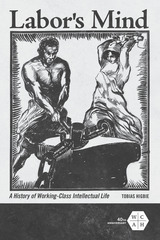 Labor's Mind: A History of Working-Class Intellectual Life
Tobias Higbie
University of Illinois Press, 2019 Business leaders, conservative ideologues, and even some radicals of the early twentieth century dismissed working people's intellect as stunted, twisted, or altogether missing. They compared workers toiling in America's sprawling factories to animals, children, and robots. Working people regularly defied these expectations, cultivating the knowledge of experience and embracing a vibrant subculture of self-education and reading. Labor's Mind uses diaries and personal correspondence, labor college records, and a range of print and visual media to recover this social history of the working-class mind. As Higbie shows, networks of working-class learners and their middle-class allies formed nothing less than a shadow labor movement. Dispersed across the industrial landscape, this movement helped bridge conflicts within radical and progressive politics even as it trained workers for the transformative new unionism of the 1930s. Revelatory and sympathetic, Labor's Mind reclaims a forgotten chapter in working-class intellectual life while mapping present-day possibilities for labor, higher education, and digitally enabled self-study.
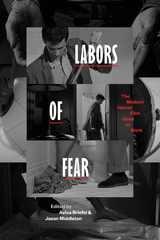 Labors of Fear: The Modern Horror Film Goes to Work
Edited by Aviva Briefel and Jason Middleton
University of Texas Press, 2023 2024 Best Edited Collection, Midwest Popular Culture Association / Midwest American Culture Association (MPCA/ACA)
How work and capitalism inspire horror in modern film.
American ideals position work as a source of pride, opportunity, and meaning. Yet the ravages of labor are constant grist for horror films. Going back decades to the mad scientists of classic cinema, the menial motel job that prepares Norman Bates for his crimes in Psycho, and the unemployed slaughterhouse workers of The Texas Chain Saw Massacre, horror movies have made the case that work is not so much a point of pride as a source of monstrosity. Editors Aviva Briefel and Jason Middleton assemble the first study of horror’s critique of labor. In the 1970s and 1980s, films such as The Shining and Dawn of the Dead responded to deindustrialization, automation, globalization, and rising numbers of women in the workforce. Labors of Fear explores these critical issues and extends them in discussions of recent works such as The Autopsy of Jane Doe, Midsommar, Survival of the Dead, It Follows, Get Out, and Us. Covering films ranging from the 1970s onward, these essays address novel and newly recognized modes and conditions of labor: reproductive labor, emotion work and emotional labor, social media and self-branding, intellectual labor, service work, precarity, and underemployment. In its singular way, horror continues to make spine-tingling sense of what is most destructive in the wider sociopolitical context of US capitalism.
 Labors of Innocence in Early Modern England
Joanna Picciotto
Harvard University Press, 2010 In seventeenth-century England, intellectuals of all kinds discovered their idealized self-image in the Adam who investigated, named, and commanded the creatures. Reinvented as the agent of innocent curiosity, Adam was central to the project of redefining contemplation as a productive and public labor. It was by identifying with creation’s original sovereign, Joanna Picciotto argues, that early modern scientists, poets, and pamphleteers claimed authority as both workers and “public persons.”
Tracking an ethos of imitatio Adami across a wide range of disciplines and devotions, Picciotto reveals how practical efforts to restore paradise generated the modern concept of objectivity and a novel understanding of the author as an agent of estranged perception. Finally, she shows how the effort to restore Adam as a working collective transformed the corpus mysticum into a public. Offering new readings of key texts by writers such as Robert Hooke, John Locke, Andrew Marvell, Joseph Addison, and most of all John Milton, Labors of Innocence in Early Modern England advances a new account of the relationship between Protestantism, experimental science, the public sphere, and intellectual labor itself.
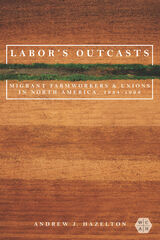 Labor's Outcasts: Migrant Farmworkers and Unions in North America, 1934-1966
Andrew J. Hazelton
University of Illinois Press, 2022 In the mid-twentieth century, corporations consolidated control over agriculture on the backs of Mexican migrant laborers through a guestworker system called the Bracero Program. The National Agricultural Workers Union (NAWU) attempted to organize these workers but met with utter indifference from the AFL-CIO. Andrew J. Hazelton examines the NAWU's opposition to the Bracero Program against the backdrop of Mexican migration and the transformation of North American agriculture. His analysis details growers’ abuse of the program to undercut organizing efforts, the NAWU's subsequent mobilization of reformers concerned by those abuses, and grower opposition to any restrictions on worker control. Though the union's organizing efforts failed, it nonetheless created effective strategies for pressuring growers and defending workers’ rights. These strategies contributed to the abandonment of the Bracero Program in 1964 and set the stage for victories by the United Farm Workers and other movements in the years to come.
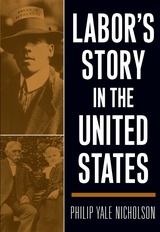 Labor's Story In The United States
Philip Nicholson
Temple University Press, 2004 In this, the first broad historical overview of labor in the United States in twenty years, Philip Nicholson examines anew the questions, the villains, the heroes, and the issues of work in America. Unlike recent books that have covered labor in the twentieth century, Labor's Story in the United States looks at the broad landscape of labor since before the Revolution. In clear, unpretentious language, Philip Yale Nicholson considers American labor history from the perspective of institutions and people: the rise of unions, the struggles over slavery, wages, and child labor, public and private responses to union organizing. Throughout, the book focuses on the integral relationship between the strength of labor and the growth of democracy, painting a vivid picture of the strength of labor movements and how they helped make the United States what it is today. Labor's Story in the United States will become an indispensable source for scholars and students.
Labor's Text: The Worker in American Fiction
Hapke, Laura
Rutgers University Press, 2000 Labor's Text charts how the worker has been portrayed and often misrepresented in American fiction. Laura Hapke offers hundreds of depictions of wage earners: from fiction on the early artisan "aristocrats" to the Gilded Age's union-busting novelists to the year 2000's marginalized, apolitical men and women. Whether the authors discussed are pro- or anti-labor, Hapke illuminates the literary, historical, and intellectual contexts in which their fiction was produced and read.
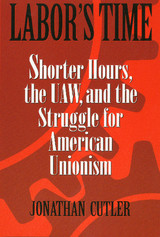 Labor's Time: Shorter Hours, The Uaw, And The
Jonathan Cutler
Temple University Press, 2004 The movement for a shorter workweek that once defined the labor movement in the United States was largely displaced by the new corporatist structure of organized labor in the post-New Deal era. Labor's Time examines the changes that occurred within organized labor and traces their influence on the decline of the shorter hours movement. Focusing on the internal union politics of the influential United Automobile Workers and Local 600, its chapter at Henry Ford's massive River Rouge factory, Jonathan Cutler demonstrates how an all-but-forgotten interracial movement for a shorter workweek during the 1950s and 1960s became a casualty of an increasingly top-heavy union bureaucracy that lost touch with the desires, fears, and aspirations of rank and file workers and dug its own grave in the process. Jonathan Cutler examines the political context in which the shorter hours movement emerged within Local 600 in the 1940s, then chronicles the attempts by Walter Reuther, the head of the UAW, to suppress it. Cutler also reviews the role the Communist Party played in the controversy. Finally, he documents the UAW response to rank and file pressure for a shorter workweek, and how the local's own organizational flaws allowed Reuther and the national union to wrest control from the dissidents. Fresh and boldly written, Labor's Time recreates a moment when unions—as a movement, not as an amalgam of leaders—could have transformed the landscape of work in the United States.
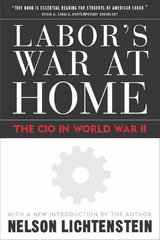 Labor'S War At Home: The Cio In World War Ii
Nelson Lichtenstein
Temple University Press, 2003 Labor's War at Home examines a critical period in American politics and labor history, beginning with the outbreak of war in Europe in 1939 through the wave of major industrial strikes that followed the war and accompanied the reconversion to a peacetime economy. Nelson Lichtenstein is concerned both with the internal organizations and social dynamics of the labor movement—especially the Congress of Industrial Organizations—and with the relationship between the CIO, as well as other bodies of organized labor, and the Roosevelt administration. He argues that tensions within the labor movement and within the ranks of American business profoundly affected government policy during the war and the nature of organized labor's political relations with Roosevelt and the Democratic Party. Moreover, the political arrangements worked out during the war established the foundations of social stability and labor politics that came to characterize the postwar world.
Labour and the Challenges of Globalization: What Prospects for Transnational Solidarity?
Andreas Bieler, Ingemar Lindberg and Devan Pillay
Pluto Press, 2008 This book examines the main challenges facing the world labor force and possible responses from trade unions.
The working classes across the world are feeling the effects of globalization and the race to the bottom that it encourages. Core jobs for workers in the developed world are being outsourced to countries where pay and conditions are terrible and union membership is often forbidden. Much of the work of the world economy is now taking place in a burgeoning informal sector, making worldwide organization of labor very difficult.
Case studies from 11 different countries, including China, Germany, Canada and South Africa, illustrate what is happening and show how workers and trade unions can successfully adapt to the neoliberal world.
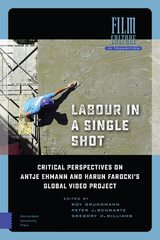 Labour in a Single Shot: Critical Perspectives on Antje Ehmann and Harun Farocki’s Global Video Project
Roy Grundmann
Amsterdam University Press, 2022 This collection of essays offers a critical assessment of Labour in a Single Shot, a groundbreaking documentary video workshop. From 2011 to 2014, curator Antje Ehmann and film- and video-maker Harun Farocki produced an art project of truly global proportions. They travelled to fifteen cities around the world to conduct workshops inspired by cinema history’s first film, Workers Leaving the Lumière Factory, shot in 1895 by the Lumière brothers in France. While the workshop videos are in colour and the camera was not required to remain static, Ehmann and Farocki’s students were tasked with honouring the original Lumière film’s basic parameters of theme and style. The fascinating result is a collection of more than 550 short videos that have appeared in international exhibitions and on an open-access website, offering the widest possible audience the opportunity to ponder contemporary labour in multiple contexts around the world.
Labour Migration in Malaysia and Spain: Markets, Citizenship and Rights
Blanca Garcés-Mascareñas
Amsterdam University Press, 2012 This study confronts the double paradox of state-regulated labor migration: while markets benefit from open borders that allow them to meet the demand for migrant workers, the boundaries of citizenship impose a degree of limitation on cross-border migration. At the same time, the exclusivity of citizenship requires closed membership, yet civil and human rights undermine the state’s capacity to exclude foreigners once they are inside the country. By considering how Malaysia and Spain have responded to the demand for foreign labor, this book analyzes the unavoidable clash of markets, citizenship, and rights.
“This truly comparative book will become a standard work in the field. It opens new research venues, with major implications for a state migration control theory that has too long been Atlanto-centred.”—Leo Lucassen, Leiden University
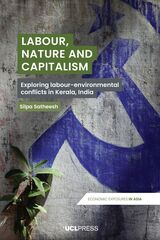 Labour, Nature and Capitalism: Exploring Labour-Environmental Conflicts in Kerala, India
Silpa Satheesh
University College London, 2025 In the fight for environmental justice, who speaks for the working class? A look at the uneasy alliance between labor and industry in Kerala.
Set against the industrial belt of Eloor-Edayar, Labour, Nature and Capitalism investigates the uneasy tensions between trade unions and environmental movements in Kerala, complicating the celebrated “Kerala Model” of development. Through ethnographic research and document analysis, Silpa Satheesh studies how capitalist interests shape and divide movements that appear to share common ground. The book challenges the simplistic “environment versus development” binary, depicting how industrial labor and grassroots environmental activism frequently find themselves at odds, despite both being embedded in struggles for justice.
By foregrounding the lived experiences of movement actors and examining the ideological fractures that emerge in postcolonial capitalism, Satheesh provides a much-needed intervention into debates on labor and ecology in the Global South. This interdisciplinary work is particularly valuable for scholars and activists working at the intersection of environmental justice and working-class mobilization, shedding light on the possibilities and limits of solidarity in the fight for just transitions.
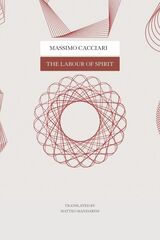 The Labour of Spirit
Massimo Cacciari
Seagull Books, 2025 A provocative examination of the fate of autonomous, creative labor under capitalism.
Between 1917 and 1919, Max Weber delivered two lectures titled Die geistige Arbeit als Beruf, which we might translate as The Labour of Spirit as Vocation. This weighty formula represented the hope that animated the world of bourgeois culture from the likes of Kant, Goethe, Schiller, Fichte, and Hegel and would later form the earliest threads of revolutionary thought from Feuerbach and Marx. The “labor of spirit” is creative, autonomous labor—human labor understood in its fully effectual power. To press for its realization is to liberate all activity from the condition of commanded or alienated work. But the dissolution of the labor of spirit into the capitalist form of production, into the universal machinism that swallows up that science which remains the true engine of development, also ends up delegitimating political authority, whose own foundation lies in the “promise of liberation.”
Massimo Cacciari takes up old questions and confronts them anew: Is the “iron cage” fated to imprison that “labor of spirit” that is political praxis? Will the spirit of capitalism end up completely undermining the space of the political? Or are relations between science and politics still thinkable that might free us from our “debt” as we proceed without means or ends within the techno-economic system?
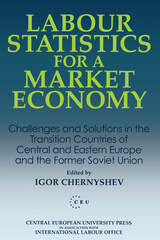 Labour Statistics for a Market Economy: Challenges and Solutions in the Transition Countries of Central and Eastern Europe and the Former Soviet Union
Igor Chernyshev
Central European University Press, 1995 The International Labour Office is the moving force behind the adoption of the Labour Force Survey in Western countries as the only reliable means of gathering information about trends in employment and unemployment, and on pay. The countries of East-Central Europe and the former USSR have recognized their need of such statistiics and turned to the ILO to help them set up systems to provide data required by decision makers. This pioneering work shows how the old "command" economies are setting up brand new systems to classify occupations, to measure employment and unemployment, and to collect information on wages and labour costs, which will be useful to students of the area and essential for statisticians world-wide concerned with the challenge of instigating an entirely new statistical service.
 Labour's Civil Wars: How Infighting has Kept the Left from Power (and What Can Be Done About It)
Patrick Diamond and Giles Radice
Haus Publishing, 2023 A compelling chronicle of the Labour Party’s perpetual internal divisions.
The biblical adage that “if a house be divided against itself, that house cannot stand” remains sound theological advice. It is also essential counsel for any political party that aspires to win elections. When a party is riven with division, the public does not know what it stands for. Though both major UK parties have been subject to internal conflict over the years, the Labour Party has been more prone to damaging splits. The divide exposed by the Corbyn insurgency is only the most recent example in almost a century of destructive infighting. Indeed, it has often seemed as though Labour has been more adept at fighting itself than in defeating the Tory party. This book examines the history of Labour’s civil wars and the underlying causes of the party’s schisms, from the first split of 1931, engineered by Ramsay MacDonald, to the ongoing battle for the future between the incumbent, Keir Starmer, and those who fundamentally altered the party’s course under his predecessor, Jeremy Corbyn.
 Labs of Our Own: Feminist Tinkerings with Science
Sig / Sara Giordano
Rutgers University Press, 2025 From climate change to COVID-19 to reproductive justice, there has been deep political polarization around science. Labs of Our Own provides a unique entry point into these twenty-first-century science wars by focusing on our affective relationships to science. The book delves into various sites where scientists, teachers, artists, and activists claim to create more democratic access to science—from DIY biology community labs to feminist classrooms to activist science practitioners. The reader will find that these claims for and attempts at democratic sciences not only impact what counts as science and who counts as a scientist but reconfigure who is included in the proper public. Instead of arguing for a knee-jerk defense of science against right-wing attacks, Labs of Our Own builds the case for a feminist, antiracist, decolonial, queer science tinkering practice that intentionally, politically, and ethically acts to produce new challenges to the definition and boundaries of the human.
 Labwork to Leadership: A Concise Guide to Thriving in the Science Job You Weren’t Trained For
Jen Heemstra
Harvard University Press, 2025 A roadmap for running a lab—and developing the leadership skills you didn’t know you needed.
As a graduate student and postdoctoral researcher, chemist Jen Heemstra learned how to collect data, write papers, and give talks to other scientists. But when, just a few years into her first job as a principal investigator, conflict broke out in the lab, she realized there was one skill she hadn’t learned: leadership.
Labwork to Leadership is the book that every PI needs. Drawing on her decades of experience—including plenty of trial and error—as well as research from psychology and business management, Heemstra nimbly guides readers through the essentials of scientific leadership. From fostering an inclusive lab environment to setting effective goals and learning to give and receive feedback graciously, she uncovers the curriculum successful PIs must follow to motivate lab members, communicate key values, and inspire confidence.
With candor and humility, Labwork to Leadership demystifies the critical leadership skills that too many universities fail to teach. And it shows how teaching scientists to lead can boost productivity, spur innovation, and, above all, help research teams rediscover the joy of science.
 The Labyrinth of Fortune
Juan de Mena
Harvard University Press, 2025 A classic, Dantesque political epic from medieval Spain that inspired Cervantes and Góngora, in its first English translation.
Why do the injustices of the past still afflict the present? With this question, Juan de Mena is transported to heaven by a vision in the Dantesque The Labyrinth of Fortune. Composed in 1444 by Mena, a royal chronicler and Latin secretary in the court of Juan II of Castile, El Laberinto de Fortuna became the most important political allegory of medieval Spain. Allegorizing the past, present, and unknowable future through the figure of Providence, the poem reflects on the contentious kingship of Juan II and frames the Reconquest of Moorish territories—the foundational mythos of the emerging nation—as a virtuous, sacred task that would restore justice and the moral order because it fulfills a destiny ordained by God. This is the first English translation of a masterpiece that enriched the Spanish language with a density of learned allusions and a new Latinate humanistic style that deeply influenced subsequent writers such as Miguel Cervantes and Luis de Góngora.
The Labyrinths Of Literacy: Reflections On Literacy Past And Present
Harvey Graff
University of Pittsburgh Press, 1995 A compelling collection by one of the pioneers of revisionist approaches to the history of literacy in North America and Europe, The Labyrinths of Literacy offers original and controversial views on the relation of literacy to society, leading the way for scholars and citizens who are willing to question the importance and function of literacy in the development of society today.
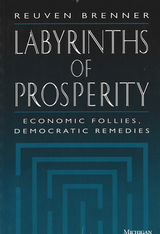 Labyrinths of Prosperity: Economic Follies, Democratic Remedies
Reuven Brenner
University of Michigan Press, 1994 Labyrinths of Prosperity: Economic Follies, Democratic Remedies by Reuven Brenner explores the cyclical shifts in economic thought, specifically focusing on the myths of macroeconomics and their impact on policy-making and prosperity. Brenner questions the scientific legitimacy of macroeconomic theories, highlighting their contradictions and the misleading confidence with which they are presented. He critiques the use of national statistics and macroeconomic aggregates—such as the GDP and unemployment rates—as unreliable bases for policy-making due to their frequent revisions and inherent inaccuracies. The book argues that true prosperity emanates from trade and financial practices that allow individuals to take risks and leverage opportunities, rather than from macroeconomic policies that claim to fine-tune economies around aggregated statistics. Brenner suggests that public policy should shift towards fostering environments where entrepreneurial endeavors can thrive, through mechanisms such as referenda and direct political engagement, to prevent policy errors from persisting unchallenged. By advocating for decentralization, Brenner assigns the responsibility of curbing government excess and sustaining prosperity to the ingenuity and innovation of individuals, thus promoting a political climate that encourages adaptation and economic freedom over rigid statutory prescriptions.
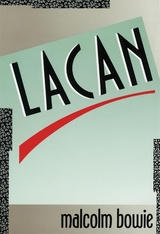 Lacan
Malcolm Bowie
Harvard University Press, 1991 The French psychoanalyst Jacques Lacan (1901–1981) is a uniquely complex writer and the originator of an especially unsettling view of the human subject. But the singularity of Lacan’s achievement has been understated by many of his critics. Often he is seen merely as a figure famous for being famous—an essential reference point in structuralist and poststructuralist debate—rather than as a theorist whose writings demand and reward detailed scrutiny.
Malcolm Bowie traces the development of Lacan’s ideas over the fifty-year span of his writing and teaching career. The primary focus is on the fascinating mutations in Lacan’s interpretation of Freud. Bowie reinserts the celebrated slogans—“The unconscious is the discourse of the Other,” “The unconscious is structured like a language,” and so forth—into the history of Lacan’s thinking, and pinpoints the paradoxes and anomalies that mark his account of human sexuality. This book provides a firm basis for the critical evaluation of Lacan’s ideas and the rhetoric in which they are embedded; it is based on a close reading of Lacan’s original texts but presupposes no knowledge of French in the reader.
Although Bowie is sharply critical of Lacan on several major analytic questions, he argues that Lacan is the only psychoanalyst after Freud whose intellectual achievement is seriously comparable to Freud’s own. Lacan provides the ideal starting point for any exploration of the work of this formidable thinker.
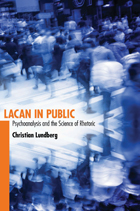 Lacan in Public: Psychoanalysis and the Science of Rhetoric
Christian Lundberg
University of Alabama Press, 2012 Lacan in Public argues that Lacan’s contributions to the theory of rhetoric are substantial and revolutionary and that rhetoric is, in fact, the central concern of Lacan’s entire body of work. Scholars typically cite Jacques Lacan as a thinker primarily concerned with issues of desire, affect, politics, and pleasure. And though Lacan explicitly contends with some of the pivotal thinkers in the field of rhetoric, rhetoricians have been hesitant to embrace the French thinker both because his writing is difficult and because Lacan’s conception of rhetoric runs counter to the American traditions of rhetoric in composition and communication studies.
Lacan’s conception of rhetoric, Christian Lundberg argues in Lacan in Public, upsets and extends the received wisdom of American rhetorical studies—that rhetoric is a science, rather than an art; that rhetoric is predicated not on the reciprocal exchange of meanings, but rather on the impossibility of such an exchange; and that rhetoric never achieves a correspondence with the real-world circumstances it attempts to describe.
As Lundberg shows, Lacan’s work speaks directly to conversations at the center of current rhetorical scholarship, including debates regarding the nature of the public and public discourses, the materiality of rhetoric and agency, and the contours of a theory of persuasion.
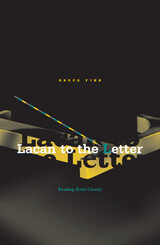 Lacan To The Letter: Reading Ecrits Closely
Bruce Fink
University of Minnesota Press, 2004 An analysis of Lacan’s thought by way of a close, authoritative reading of his Écrits To read Lacan closely is to follow him to the letter, to take him literally, making the wager that he comes right out and says what he means in many cases, though much of his argument must be reconstructed through a line-by-line examination. And this is precisely what Bruce Fink does in this ambitious book, a fine analysis of Lacan’s work on language and psychoanalytic treatment conducted on the basis of a very close reading of texts in his Écrits: A Selection. As a translator and renowned proponent of Lacan’s works, Fink is an especially adept and congenial guide through the complexities of Lacanian literature and concepts. He devotes considerable space to notions that have been particularly prone to misunderstanding, notions such as “the sliding of the signified under the signifier,” or that have gone seemingly unnoticed, such as “the ego is the metonymy of desire.” Fink also pays special attention to psychoanalytic concepts, like affect, that Lacan is sometimes thought to neglect, and to controversial concepts, like the phallus. From a parsing of Lacan’s claim that “commenting on a text is like doing an analysis,” to sustained readings of “The Instance of the Letter in the Unconscious,” “The Direction of the Treatment,” and “Subversion of the Subject” (with particular attention given to the Graph of Desire), Fink’s book is a work of unmatched subtlety, depth, and detail, providing a valuable new perspective on one of the twentieth century’s most important thinkers.
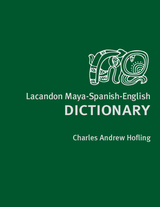 Lacandon Maya-Spanish-English Dictionary
Charles A Hofling
University of Utah Press, 2014 Around 1700 AD the Lacandon Maya took refuge in the forest lowlands of Chiapas, Mexico, and in western Petén, Guatemala. They were never conquered by the Spanish and thus maintained many of their cultural practices well into the twentieth century. Their language belongs to the Yucatecan branch of the Maya language, a branch that is believed to have begun to diversify at least one thousand years ago. Today the Lancandon are split into northern and southern linguistic groups. This dictionary focuses on the southern Lacandon of Lacanjá.
Following the same trilingual format as Hofling’s Mopan Maya-Spanish-English Dictionary, this reference contains pronunciation and grammatical information. It is a hybrid of a root dictionary and one with words in alphabetical order; words can be looked up in these two different ways, making it easy to use for both native and nonnative speakers. It also accommodates Spanish speakers who wish to learn Lacandon, and in the future is likely to be helpful to Lacandon-speaking children, who increasingly use Spanish outside the home, while preserving a record of this indigenous language.
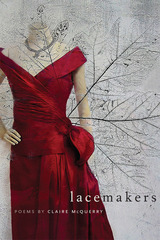 Lacemakers
Claire McQuerry
Southern Illinois University Press, 2012 In Lacemakers, Claire McQuerry investigates the timeless questions of relationships, of loss and longing, and of environment both natural and manmade. This informal yet haunting collection juxtaposes a myriad of perspectives—public and personal, interior and exterior, sacred and secular—to explore the fathomless mysteries that abound between one human and another. From the metallic hum of the air conditioner to the thrumming of quail wings in the Arizona desert, from the necklace of brake lights on the freeway to the more dangerous and intimate highways of the human heart, McQuerry explores the impact of our environments, both urban and natural, on humankind. Spirituality clashes with modernity in the holiest of places, and we are relentlessly confronted with the irreconcilable otherness of our fellow man. Above all, Lacemakers returns obsessively to separations, offering searing insight into our inability to truly know another person, meditating on the subtle abysses that eternally divide us from others.
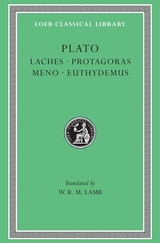 Laches. Protagoras. Meno. Euthydemus
Plato
Harvard University Press On virtue in education and argumentation.
Plato, the great philosopher of Athens, was born in 427 BC. In early manhood an admirer of Socrates, he later founded the famous school of philosophy in the grove Academus. Much else recorded of his life is uncertain; that he left Athens for a time after Socrates’ execution is probable; that later he went to Cyrene, Egypt, and Sicily is possible; that he was wealthy is likely; that he was critical of “advanced” democracy is obvious. He lived to be 80 years old. Linguistic tests including those of computer science still try to establish the order of his extant philosophical dialogues, written in splendid prose and revealing Socrates’ mind fused with Plato’s thought.
In Laches, Charmides, and Lysis, Socrates and others discuss separate ethical conceptions. Protagoras, Ion, and Meno discuss whether righteousness can be taught. In Gorgias, Socrates is estranged from his city’s thought, and his fate is impending. The Apology (not a dialogue), Crito, Euthyphro, and the unforgettable Phaedo relate the trial and death of Socrates and propound the immortality of the soul. In the famous Symposium and Phaedrus, written when Socrates was still alive, we find the origin and meaning of love. Cratylus discusses the nature of language. The great masterpiece in ten books, the Republic, concerns righteousness (and involves education, equality of the sexes, the structure of society, and abolition of slavery). Of the six so-called dialectical dialogues Euthydemus deals with philosophy; metaphysical Parmenides is about general concepts and absolute being; Theaetetus reasons about the theory of knowledge. Of its sequels, Sophist deals with not-being; Politicus with good and bad statesmanship and governments; Philebus with what is good. The Timaeus seeks the origin of the visible universe out of abstract geometrical elements. The unfinished Critias treats of lost Atlantis. Unfinished also is Plato’s last work, Laws, a critical discussion of principles of law which Plato thought the Greeks might accept.
The Loeb Classical Library edition of Plato is in twelve volumes.
The Lacquer Screen: A Chinese Detective Story
Robert van Gulik
University of Chicago Press, 1962 A fiendishly clever, yet cozy entry in the much-loved mystery series starring Judge Dee, whom the Los Angeles Times ranked with Sherlock Holmes
Early in his career, Judge Dee visits a senior magistrate who shows him a beautiful lacquer screen on which a scene of lovers has been mysteriously altered to show the man stabbing his lover. The magistrate fears he is losing his mind and will murder his own wife. Meanwhile, a banker has inexplicably killed himself, and a lovely lady has allowed Dee's lieutenant, Chiao Tai, to believe she is a courtesan. Dee and Chiao Tai go incognito among a gang of robbers to solve this mystery, and find the leader of the robbers is more honorable than the magistrate.
Lactantius and Milton
Kathleen Ellen Hartwell
Harvard University Press An exploration of Milton’s reading in “the Christian Cicero.” Milton’s knowledge of Lactantius, which is attested by numerous entries in the Commonplace Book , is followed out through both poetry and prose, and traces of Lactantian influence are found in both, from “Comus” to the “De Doctrina Christiana.” Thus Lactantius proves to have been an important minor influence on the poet. This book, especially designed for Milton scholars, contains interesting matter in its appendices bearing on such subjects as the influence of Purchas on Milton and of the curriculum and daily routine of life at St. Paul’s School on its most renowned scholar.
 A Ladder of Cranes
Tom Sexton
University of Alaska Press, 2015 Whether watching men releasing caged birds at dawn in New York City or a ladder of cranes rising from a field in Manitoba, Tom Sexton is a keen observer of the interconnectedness of the natural and human worlds. The former Alaska poet laureate takes to the road in this new collection, wending a lyrical and at times mystical path between Alaska and New England.
Travelers along the way include the fabled wolf of Gubbio, old and lame and long past his taming encounter with Saint Francis of Assisi, and Chinese poet Li Bai chanting to a Yangtze River dolphin. Yet, while Sexton’s journey crosses borders—and occasionally centuries—his ultimate destination is always the landscape and people of Alaska. A Ladder of Cranes showcases Sexton’s mastery of both traditional forms and free verse. The tensions of his formal influences, Chinese and European, force the reader to experience these spare lines and tight observations in stunning new ways.
The Ladder: Poems
Alan Michael Parker
Tupelo Press, 2016 Whether about the moon or hotel sex, politics or poppy seeds, Alan Michael Parker’s poems are always tender and eccentric and nuanced. In his eighth collection, with metaphysical fortitude the poet continues to deliberate—in all sorts of poems, some unpunctuated, some in prose, and some the first-person lyrics well loved by his longtime readers—upon what our daily lives mean. And how do we sing and praise and grieve all at once?
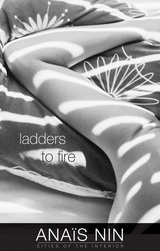 Ladders to Fire
Anaïs Nin
Ohio University Press, 2014 Anaïs Nin’s Ladders to Fire interweaves the stories of several women, each emotionally inhibited in her own way: through self-doubt, fear, guilt, moral drift, and distrust. The novel follows their inner struggles to overcome these barriers to happiness and wholeness. The author’s own experiences, as recorded in her famous diaries, supplied the raw material for her fiction. It was her intuitive, experimental, and always original style that transformed one into the other. Nin herself memorably claimed that “it was the fiction writer who edited the diary.” Ladders to Fire is the first book of Nin’s continuous novel, Cities of the Interior, which also includes Children of the Albatross,The Four-Chambered Heart,A Spy in the House of Love, and Seduction of the Minotaur. These loosely interlinked stories develop the characters and themes established in the first volume, leading slowly toward a resolution of inner turmoil and conflict. This Swallow Press reissue of Ladders to Fire includes a new introduction by Nin scholar Benjamin Franklin V, as well as Gunther Stuhlmann’s classic foreword to the 1995 edition.
 Ladders To Fire: New Expanded Edition
Anaïs Nin
Ohio University Press, 1959
After struggling with her own press and printing her own works, Anaïs Nin succeeded in getting Ladders to Fire accepted and published in 1946. This recognition marked a milestone in her life and career. Admitted into the fellowship of American novelists, she maintained the individuality of her literary style. She resisted realistic writing and drew on the experience and intuitions of her diary to forge a novelistic style emphasizing free association, the language of emotion, spontaneity, and improvisation.
Ladders to Fire is the first volume of Nin’s celebrated series of novels called Cities of the Interior
For Anaïs Nin, her writing and her life were not separable, they were both part of the same experience. She claimed that “is it the fiction writer who edited the diary.”
Anaïs Nin continues to find an audience, whether for her fiction, her diaries, or her own life story, which has enjoyed the attention of biographers and filmmakers. This 1995 reissue of Ladders to Fire has a new cover and foreword.
 Ladie Borlase's Receiptes Booke
David E. Schoonover
University of Iowa Press, 1998 Ladie Borlaise's Receiptes Booke, an English manorial and culinary manuscript, has been in existence for at least 333 years. This manuscript, bearing dates from 1665 to 1822, provides a unique compendium of culinary history that opens a window to the aristocratic, social, agricultural, horticultural, economic, and medicinal aspects of English country life. The Borlase manuscript is a kind of miscellany. Included are recipes not only for all kinds of foods but also for distilled waters, remedies, dyes, soaps, and perfumes. A housewife of that period was responsible for keeping her family healthy and her house clean and sweet smelling, and so the manuscript features directions for preparing medicinal “oyles,” waters, “glysters,” powders, “ballsoms,”a “true Majistery,” and a julep, with healing powers for a number of ailments from apoplexy and gout to cancer and the plague. The cookery recipes concentrate almost entirely on sweets and meats with only a few mentions of vegetables. More than half of the recipes included in this manuscript are for sweets. This was important as sugar was entering Britain in greater quantities and because people believed in sugar's supposed health benefits. Several recipes for preserved fruits reflect a changing diet and appetite among the British as the availability of fruits and vegetables increased in both quantity and variety. David Schoonover's informative introduction places the Borlase manuscript in its historical context with special attention to the economic and social changes of the sixteenth and seventeenth centuries, which brought about a new emphasis on housewifery and the management of households. He also provides a brief summary of the Borlase family history—born in 1621, Alice Bankes, Lady Borlase, died in 1683 at the age of sixty-two years—and a description of their home at Bockmer Manor at Medmenham, Buckinghamshire.
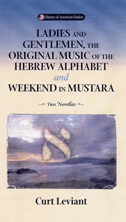 Ladies & Gentleman, The Original Music: Of The Hebrew Alphabet And Weekend In Mustarra
Curt Leviant
University of Wisconsin Press, 2002 Filled with Curt Leviant's signature blend of humor and drama, these two enchanting and original novellas lure readers into a dazzling storybook world.
"Ladies and Gentlemen, the Original Music of the Hebrew Alphabet" is set in Budapest during the Communist era. The story focuses on the tenuous seesaw between Dr. Isaac Gantz, a musicologist, and engineer Ferdinand Friedman, a Holocaust survivor who believes that he possesses one of the greatest manuscripts of the ages, a Rosetta Stone of Judaica. Friedman is willing to share it—but there is a "but." In pursuing this prize, Gantz enters a world of strange human relationships filled with doubts and surprises. A vibrant cast of characters adds dimension to this gripping story in which Jewish folklore, music, and history coalesce.
"Weekend in Mustara" unfolds on the fictional island of Mustara in southern Europe, a mountainous, totalitarian country that tolerates Judaism. Its few Jews cling to their heritage, embodied in their beautiful but sparsely attended synagogue and their museum, where a great memorial book is inscribed with the names of all Mustara Jews martyred during World War II. A scholar of medieval Hebrew manuscripts comes to the island, searching for traces of Yehuda Halevi, the great Hebrew poet of the Spanish Golden Age. He is soon enmeshed among elusive personalities and tangled loyalties, but only when he finds himself displaced in time—in a kind of theater of the absurd—are the purposes of his journey finally realized.
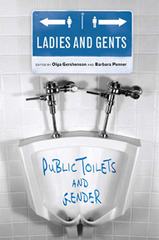 Ladies and Gents: Public Toilets and Gender
edited by Olga Gershenson and Barbara Penner, foreword by Judith Plaskow, afterword by Peter Greenaway
Temple University Press, 2009 Public toilets provide a unique opportunity for interrogating how conventional assumptions about the body, sexuality, privacy, and technology are formed in public spaces and inscribed through design across cultures. This collection of original essays from international scholars is the first to explore the cultural meanings, histories, and ideologies of public toilets as gendered spaces. Ladies and Gents consists of two sets of essays. The first, "Potty Politics: Toilets, Gender and Identity," establishes the importance of accessible, secure public toilets to the creation of inclusive cities, work, and learning environments. The second set of essays, "Toilet Art: Design and Cultural Representations," discusses public toilets as spaces of representation and representational spaces, with reference to architectural design, humor, film, theater, art, and popular culture. Compelling visual materials and original artwork are included throughout, depicting subjects as varied as female urinals, art installations sited in public restrooms, and the toilet in contemporary art. Taken together, these seventeen essays demonstrate that public toilets are often sites where gendered bodies compete for resources and recognition—and the stakes are high. Contributors include: Nathan Abrams, Jami L. Anderson, Johan Andersson, Kathryn H. Anthony, Kathy Battista, Andrew Brown-May, Ben Campkin, Meghan Dufresne, Peg Fraser, Deborah Gans, Clara Greed, Robin Lydenberg, Claudia Mitchell, Alison Moore, Frances Pheasant-Kelly, Bushra Rehman, Alex Schweder, Naomi Stead, and the editors.
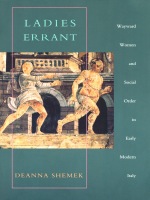 Ladies Errant: Wayward Women and Social Order in Early Modern Italy
Deanna Shemek
Duke University Press, 1998 The issue of a woman’s place—and the possibility that she might stray from it—was one of early modern Italy’s most persistent social concerns. Ladies Errant takes as its starting point the vast literature of this era devoted to the proper conduct and education of women. Deanna Shemek uses this foundation to present the problem of wayward feminine behavior as it was perceived to threaten male identity and social order in the artistic and intellectual articulations of the Italian Renaissance.
Seeing errancy as an act of resistance rather than of error, Shemek carries her study beyond the didactic and prescriptive literature on femininity in early modern Italy to an arena in which theories about femininity are considered jointly with real and fictional instances of women’s waywardness. As prostitutes, warriors, lovers, and poets, the women of Shemek’s study are found in canonical texts, marginal works, and popular artistic activity, appearing, for instance, in literature, paintings, legal proceedings, and accounts of public festivals. By juxtaposing these varied places of errancy—from Ariosto’s chivalric Orlando furioso to the prostitutes’ race in the Palio di San Giorgio—Shemek points to the important contact between elite and popular cultures in early modernity, revealing the strength and flexibility of a gender boundary fundamental to early modern conceptions of social order.
 The Ladies' Etiquette Handbook: The Importance of Being Refined in the 1880s
David E. Schoonover
University of Iowa Press, 2001 Prior to the late nineteenth century, most Americans viewed dining as a utilitarian duty characterized by common “meat and potato” dishes and complemented by little, if any, polite conversation. With the boom in industrialism and the sudden growth of the middle class in the 1880s, America's interest in social etiquette rose dramatically. Consisting of two separate publications—The Ladies' Handbook and Household Assistant(1886) and Short Hints on Social Etiquette (1887)—The Ladies' Etiquette Handbook can be read as a testament to the growing division between social classes and, at the same time, as a reflection of the middle class' overwhelming desire to cross social lines through the graces of fine etiquette. Written by a Methodist women's church group in Manchester, New Hampshire, The Ladies' Handbook and Household Assistant provides advice on subjects such as church etiquette and the proper handling of cutlery as well as recipes for the socially active household. Short Hints on Social Etiquette, published as a promotional piece by a Philadelphia soap manufacturer—including descriptions of lavish meals, advice on proper word pronunciation, and illustrations of tasteful calling cards—strives to bring “aristocratic” values into the “republican” home. The foreword by Kenneth Cmiel, professor of history at the University of Iowa, provides an overview of the historic and social trends leading up to the publication of both handbooks and traces the creation and ultimate development of modern social etiquette.
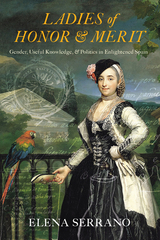 Ladies of Honor and Merit: Gender, Useful Knowledge, and Politics in Enlightened Spain
Elena Serrano
University of Pittsburgh Press, 2022 In the late eighteenth century, enlightened politicians and upper-class women in Spain debated the right of women to join one of the country’s most prominent scientific institutions: the Madrid Economic Society of Friends of the Country. Societies such as these, as Elena Serrano describes in her book, were founded on the idea that laypeople could contribute to the advancement of their country by providing “useful knowledge,” and their fellows often referred to themselves as improvers, or friends of the country. After intense debates, the duchess of Benavente, along with nine distinguished ladies, claimed, won, and exercised the right of women to participate in shaping the future of their nation by inaugurating the Junta de Damas de Honor y Mérito, or the Committee of Ladies of Honor and Merit. Ten years later, the Junta established a network of over sixty correspondents extending from Tenerife to Asturias and Austria to Cuba. With this book, Serrano tells the unknown story of how the duchess and her peers—who succeeded in creating the only known female branch among some five hundred patriotic societies in the eighteenth century—shaped Spanish scientific culture. Her study reveals how the Junta, by stressing the value of their feminine nature in their efforts to reform education, rural economy, and the poor, produced and circulated useful knowledge and ultimately crystallized the European improvement movement in Spain within an otherwise all-male context.
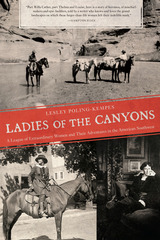 Ladies of the Canyons: A League of Extraordinary Women and Their Adventures in the American Southwest
Lesley Poling-Kempes
University of Arizona Press, 2015 Ladies of the Canyons is the true story of remarkable women who left the security and comforts of genteel Victorian society and journeyed to the American Southwest in search of a wider view of themselves and their world.
Educated, restless, and inquisitive, Natalie Curtis, Carol Stanley, Alice Klauber, and Mary Cabot Wheelwright were plucky, intrepid women whose lives were transformed in the first decades of the twentieth century by the people and the landscape of the American Southwest. Part of an influential circle of women that included Louisa Wade Wetherill, Alice Corbin Henderson, Mabel Dodge Luhan, Mary Austin, and Willa Cather, these ladies imagined and created a new home territory, a new society, and a new identity for themselves and for the women who would follow them.
Their adventures were shared with the likes of Theodore Roosevelt and Robert Henri, Edgar Hewett and Charles Lummis, Chief Tawakwaptiwa of the Hopi, and Hostiin Klah of the Navajo. Their journeys took them to Monument Valley and Rainbow Bridge, into Canyon de Chelly, and across the high mesas of the Hopi, down through the Grand Canyon, and over the red desert of the Four Corners, to the pueblos along the Rio Grande and the villages in the mountains between Santa Fe and Taos.
Although their stories converge in the outback of the American Southwest, the saga of Ladies of the Canyons is also the tale of Boston’s Brahmins, the Greenwich Village avant-garde, the birth of American modern art, and Santa Fe’s art and literary colony.
Ladies of the Canyons is the story of New Women stepping boldly into the New World of inconspicuous success, ambitious failure, and the personal challenges experienced by women and men during the emergence of the Modern Age.
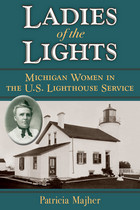 Ladies of the Lights: Michigan Women in the U.S. Lighthouse Service
Patricia Majher
University of Michigan Press, 2010 "A great read about some great ladies, Pat Majher's Ladies of the Lights pays long overdue homage to an overlooked part of Great Lakes maritime history in which a select group of stalwart women beat the odds to succeed in a field historically reserved for men."
---Terry Pepper, Executive Director of Great Lakes Lighthouse Keeper's Association Michigan once led the country in the number of lighthouses, and they're still a central part of the mystique and colorful countryside of the state. What even the region's lighthouse enthusiasts might not know is the rich history of female lighthouse keepers in the area. Fifty women served the sailing communities on Lakes Huron, Michigan, and Superior, as well as on the Detroit River, for more than 100 years. From Catherine Shook, who raised eight children while maintaining the Pointe Aux Barques light at the entrance to Saginaw Bay; to Eliza Truckey, who assumed responsibility for the lighthouse in Marquette while her husband fought for four years in the Civil War; to Elizabeth Whitney, whose combined service on Beaver Island and in Harbor Springs totaled forty-one years---the stories of Michigan's "ladies of the light" are inspiring. This is no technical tome documenting the minutiae of Michigan's lighthouse specifications. Rather, it's a detailed, human portrait of the women who kept those lighthouses running, defying the gender expectations of their time. Patricia Majher is Editor of Michigan History magazine, published by the Historical Society of Michigan. Prior, she was Assistant Director of the Michigan Women's Historical Center and Hall of Fame in Lansing, Michigan. In addition, she has been writing both advertising and editorial copy for almost thirty years and has been a frequent contributor to Michigan newspapers and magazines.
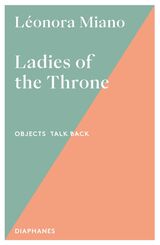 Ladies of the Throne
Léonora Miano
Diaphanes, 2025 An astonishing new narrative of Mandu Yenu, a throne from the ancient Kingdom of Bamum.
“Most of the time, it is the power of men that we remember.” With these words, which open Léonora Miano’s text for Objects Talk Back, an astonishing new narrative unfurls around Mandu Yenu, a throne from the ancient Kingdom of Bamum (present day Cameroon).
The Germans long claimed the object was a gift from King Njoya to Kaiser Wilhelm II. Miano reads “between the lines of beads and cowrie shells” to show the complex intricacies of colonial and gender relations. Dismissing all pretense of egalitarianism between colonizer and colonized, she hones in on the very nature of power—how and by whom it is defined-wielded-subverted.
King Njoya said he “felt like a woman in his relationship with the Germans.” Miano takes this as a prompt to examine contrasting cultural notions of femininity and thus reveals how central women are to the story of the throne. As the very name of the object suggests, it is the power of women we should remember.
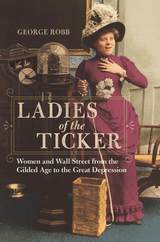 Ladies of the Ticker: Women and Wall Street from the Gilded Age to the Great Depression
George Robb
University of Illinois Press, 2017 Long overlooked in histories of finance, women played an essential role in areas such as banking and the stock market during the late nineteenth and early twentieth centuries. Yet their presence sparked ongoing controversy. Hetty Green’s golden touch brought her millions, but she outraged critics with her rejection of domesticity. Progressives like Victoria Woodhull, meanwhile, saw financial acumen as more important for women than the vote. George Robb’s pioneering study explores the financial methods, accomplishments, and careers of three generations of women. Plumbing sources from stock brokers’ ledgers to media coverage, Robb reveals the many ways women invested their capital while exploring their differing sources of information, approaches to finance, interactions with markets, and levels of expertise. He also rediscovers the forgotten women bankers, brokers, and speculators who blazed new trails--and sparked public outcries over women’s unsuitability for the predatory rough-and-tumble of market capitalism. Entertaining and vivid with details, Ladies of the Ticker sheds light on the trailblazers who transformed Wall Street into a place for women’s work.
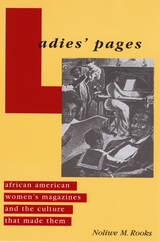 Ladies' Pages: African American Women's Magazines and the Culture That Made Them
Rooks, Noliwe M
Rutgers University Press, 2004 Beginning in the late nineteenth century, mainstream magazines established ideal images of white female culture, while comparable African American periodicals were cast among the shadows. Noliwe M. Rooks’s Ladies’ Pages sheds light on the most influential African American women’s magazines––Ringwood’s Afro-American Journal of Fashion, Half-Century Magazine for the Colored Homemaker, Tan Confessions, Essence, and O, the Oprah Magazine––and their little-known success in shaping the lives of black women.
Ladies’ Pages demonstrates how these rare and thought-provoking publications contributed to the development of African American culture and the ways in which they in turn reflect important historical changes in black communities. What African American women wore, bought, consumed, read, cooked, and did at home with their families were all fair game, and each of the magazines offered copious amounts of advice about what such choices could and did mean. At the same time, these periodicals helped African American women to find work and to develop a strong communications network. Rooks reveals in detail how these publications contributed to the concepts of black sexual identity, rape, migration, urbanization, fashion, domesticity, consumerism, and education. Her book is essential reading for everyone interested in the history and culture of African Americans.
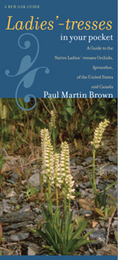 Ladies'-tresses in Your Pocket: A Guide to the Native Ladies'-tresses Orchids, Spiranthes, of the United States and Canada
Paul Martin Brown
University of Iowa Press, 2008 Native orchids are increasingly threatened by pressure from population growth and development but, nonetheless, still present a welcome surprise to observant hikers in every state and province. Compiled and illustrated by long-time orchid specialist Paul Martin Brown, this pocket guide to ladies’-tresses is the first in a series that will cover all the wild orchids of the United States and Canada.
Brown provides general distributional information, time of flowering, and habitat requirements for each species as well as a complete list of hybrids and the many different growth and color forms that can make identifying orchids so intriguing. He includes information on 256 species, 3 additional varieties, and 7 hybrids.
Wild ladies’-tresses occur from British Columbia, with the hooded ladies’-tresses, Spiranthes romanzoffiana, to Florida, with Eaton’s-ladies’-tresses, S. eatonii. The newest species to science, Spiranthes stellata, the starry ladies’-tresses, is featured. Most of these species are easy to identify based upon their general appearance, range, and time of flowering. Answer three simple questions—when, where, and how does it grow? Then compare the living plant with the striking photos in these backpack-friendly laminated guides and consult the keys that Brown has created. Following these steps should enable both professional and amateur naturalists to achieve the satisfaction of identifying specific orchids in their native environment.
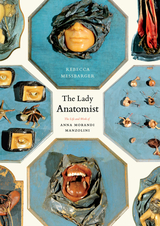 The Lady Anatomist: The Life and Work of Anna Morandi Manzolini
Rebecca Messbarger
University of Chicago Press, 2010 Anna Morandi Manzolini (1714-74), a woman artist and scientist, surmounted meager origins and limited formal education to become one of the most acclaimed anatomical sculptors of the Enlightenment. The Lady Anatomist tells the story of her arresting life and times, in light of the intertwined histories of science, gender, and art that complicated her rise to fame in the eighteenth century. Examining the details of Morandi’s remarkable life, Rebecca Messbarger traces her intellectual trajectory from provincial artist to internationally renowned anatomical wax modeler for the University of Bologna’s famous medical school. Placing Morandi’s work within its cultural and historical context, as well as in line with the Italian tradition of anatomical studies and design, Messbarger uncovers the messages contained within Morandi’s wax inscriptions, part complex theories of the body and part poetry. Widely appealing to those with an interest in the tangled histories of art and the body, and including lavish, full-color reproductions of Morandi’s work, The Lady Anatomist is a sophisticated biography of a true visionary.
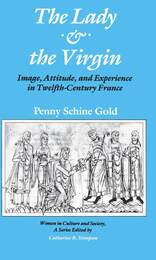 The Lady and the Virgin: Image, Attitude, and Experience in Twelfth-Century France
Penny Schine Gold
University of Chicago Press, 1985 Penny Schine Gold provides a bold analysis of key literary and artistic images of women in the Middle Ages and the relationship between these images and the actual experience of women. She argues that the complex interactions between men and women as expressed in both image and experience reflect a common pattern of ambivalence and contradiction. Thus, women are seen as both helpful and harmful, powerful and submissive, and the actuality of women's experience encompasses women in control and controlled, autonomous and dependent.
Vividly recreating the rich texture of medieval life, Gold effectively and eloquently goes beyond a simple equation of social context and representation. In the process. she challenges equally simple judgments of historical periods as being either "good" or "bad" for women.
"[The Lady and the Virgin] presents its findings in a form that should attract students as well as their instructors. The careful and controlled use of so many different kinds of sources . . . offers us a valuable medieval case study in the inner-relationship between the segments of society and its ethos or value system."—Joel T. Rosenthal, The History Teacher
"Something of a tour de force in an interdisciplinary approach to history."—Jo Ann McNamara, Speculum
"[A] well-written, extremely well-researched book. . . . The Lady and the Virgin is useful, readable, and well informed."—R. Howard Bloch, Modern Philology
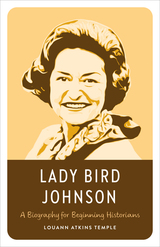 Lady Bird Johnson: A Biography for Beginning Historians
Louann Atkins Temple
University of Texas Press, 2025 A brief biography of Lady Bird Johnson for young readers. Louann Temple is a lifelong Texan with a personal passion for arts and education who believes that biography, with its emphasis on personalities, is ideal for introducing young people to history, with its focus on events. Temple is uniquely situated to write this biography for young readers, as she has been personally acquainted with many important people in presidential history, Lady Bird Johnson included, and she has mentored countless middle and high school students, preparing them for college admission. Lady Bird Johnson highlights the key events in the life of the First Lady; explores the life lessons afforded by her legacy; and reflects on the broad historical issues during her time in the White House from 1963 to 1969. Married to the thirty-sixth president, Lyndon B. Johnson, Lady Bird Johnson dedicated her time as First Lady to beautifying America and conserving natural spaces. Enhanced with a carefully curated selection of black and white photographs from three presidential libraries, this biography for beginning historians is poised to bring the best of biography and history to a new generation of readers.
 Lady Chatterley's Legacy in the Movies: Sex, Brains, and Body Guys
Lehman, Peter
Rutgers University Press, 2010 Titanic. Two Moon Junction. A Night in Heaven. Sirens. Henry & June. 9 Songs. Lady Chatterley. And more. A new "body guy" genre has emerged in film during the last twenty years-a working-class man of the earth or bohemian artist awakens and fulfills the sexuality of a beautiful, intelligent woman frequently married or engaged to a sexually incompetent, educated, upper-class man. This body guy exhibits a masterful athletic, penile-centered sexual performance that enlivens and transforms the previously discontented woman's life.
Peter Lehman and Susan Hunt relate a host of wide-ranging films to a literary tradition dating back to D. H. Lawrence's Lady Chatterley's Lover and an emerging body culture of our time. Through an engaging and compelling narrative, they argue that the hero's body, lovemaking style, and penis-revealed through extensive male nudity-celebrate conformity to norms of masculinity and male sexuality. Simultaneously, these films denigrate the vital, creative, erotic world of the mind. Just when women began to successfully compete with men in the workplace, these movies, if you will, unzip the penis as the one thing women do not have but want and need for their fulfillment.
But Lehman and Hunt also find signs of a yearning for alternative forms of sexual and erotic pleasure in film, embracing diverse bodies and vibrant minds. Lady Chatterley's Legacy in the Movies shows how filmmakers, spectators, and all of us can be empowered to dethrone the body guy, his privileged body, and preferred style of lovemaking, replacing it with a wide range of alternatives.
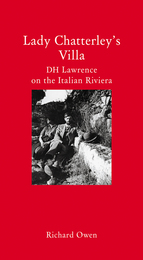 Lady Chatterley's Villa: D. H. Lawrence on the Italian Riviera
Richard Owen
Haus Publishing, 2014 November 1925 found David and Frieda Lawrence on the Italian Riviera, looking for sun, sea air, and health. The Lawrences were exhilarated by life in their rented villa, set amid olive groves and vineyards, with a view of the sparkling Mediterranean. The drab English winter couldn’t have been farther away.
But before long Frieda found herself irresistibly attracted to their landlord, a dashing Italian army officer, and the resulting affair served as the background for Lawrence’s writing: while in the villa, he turned out two stories, “Sun” and “The Virgin and the Gypsy,” both prefiguring Lady Chatterley’s Lover in their depiction of women fatally drawn to earthy, muscular men.
Built on the unpublished, and previously unexplored, letters and diaries of Rina Secker, the Anglo-Italian wife of Lawrence’s publisher, and featuring never-before-published letters from Lawrence, Lady Chatterley’s Villa reconstructs the drama of the tempestuous marriage, and the ways it fired Lawrence’s creativity. Along the way, Richard Owen offers a new accounting of Lawrence’s passion for Italy, tracing his travels along the coasts and islands and his deep engagement with Italian culture. This exploration of a little-studied, but crucial period of the writer’s life will be a must for Lawrence’s many fans.
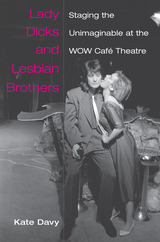 Lady Dicks and Lesbian Brothers: Staging the Unimaginable at the WOW Café Theatre
Kate Davy
University of Michigan Press, 2010 "A rich and detailed picture of a particular historical moment that has now passed . . . I found myself immersed in the world of the East Village theatre scene and its connections to the larger world of feminism, theatre, and politics. Davy's long-standing association with this world pays off handsomely---it is impossible to imagine that anyone could write a more informative portrait."
---Charlotte Canning, University of Texas at Austin "After hosting two annual international women's performance festivals in 1980 and '81, Peggy Shaw, Lois Weaver, and comrades put on such extravaganzas as the Freudian Slip party and the Debutante Ball (a coming-out party if ever there was one) to raise the first several months' rent for a narrow vestibule on East 11th Street, where they could keep the creativity going year-round. There, on a stage no bigger than a queen-sized mattress, . . . artists honed their craft, giving birth to a celebratory feminist-and-tinsel-tinged queer aesthetic. By the mid '80s . . . the rent quadrupled, and WOW moved to a city-owned building on East 4th Street, where it has flourished ever since, presenting hundreds---if not thousands---of plays, solo shows, concerts, dance pieces, cabarets, and sundry performances that defy classification."
---Alisa Solomon, Village Voice Out of a small, hand-to-mouth, women's theater collective called the WOW Café located on the lower east side of Manhattan, there emerged some of the most important theater troupes and performance artists of the 1980s and 1990s, including the Split Britches Company, the Five Lesbian Brothers, Carmelita Tropicana, Holly Hughes, Lisa Kron, Deb Margolin, Reno, Peggy Shaw, and Lois Weaver. The WOW (Women's One World) Café Theatre appeared on the cultural scene at a critical turning point in both the women's movement and feminist theory, putting a witty, hilarious, gender-bending and erotically charged aesthetic on the stage for women in general and lesbians in particular. The storefront that became the WOW Café Theatre saw dozens of excitingly original and enormously funny performances created, performed, and turned over at lightning speed---a kind of "hit and run" theater. As the demands on the space increased, the women behind WOW organized as a collective and moved their theater to an abandoned doll factory where it continues to operate today. For three decades the WOW Café has nurtured fledgling women writers, designers, and performers who continue to create important performance work. Lady Dicks and Lesbian Brothers provides a critical history of this avant-garde venture whose ongoing "system of anarchy" has been largely responsible for its thirty-year staying power, after dozens of other women's theaters have collapsed. WOW artists were creating a wholly original cultural landscape across which women could represent themselves on their own terms. Parody, cross-dressing, zany comedy, and an unbridled eroticism are hallmarks of WOW's aesthetic, combined---importantly and powerfully---with a presumptive address to the audience as if everyone onstage, in the audience, and in the world is lesbian. Author Kate Davy's extensive research included in-depth interviews with WOW veterans; newspaper reviews of the earliest productions; and rare, unpublished photographs. The book also includes a chronology of productions that have highlighted WOW's performance schedule since the early '80s. Kate Davy is currently Provost and Vice Chancellor for Academic Affairs at the University of Michigan-Dearborn. Her previous books include Richard Foreman: Plays and Manifestos and Richard Foreman and the Ontological-Hysteric Theatre.
 Lady Dicks and Lesbian Brothers: Staging the Unimaginable at the WOW Café Theatre
Kate Davy
University of Michigan Press, 2010
"A rich and detailed picture of a particular historical moment that has now passed . . . I found myself immersed in the world of the East Village theatre scene and its connections to the larger world of feminism, theatre, and politics. Davy's long-standing association with this world pays off handsomely---it is impossible to imagine that anyone could write a more informative portrait."
---Charlotte Canning, University of Texas at Austin
"After hosting two annual international women's performance festivals in 1980 and '81, Peggy Shaw, Lois Weaver, and comrades put on such extravaganzas as the Freudian Slip party and the Debutante Ball (a coming-out party if ever there was one) to raise the first several months' rent for a narrow vestibule on East 11th Street, where they could keep the creativity going year-round. There, on a stage no bigger than a queen-sized mattress, . . . artists honed their craft, giving birth to a celebratory feminist-and-tinsel-tinged queer aesthetic. By the mid '80s . . . the rent quadrupled, and WOW moved to a city-owned building on East 4th Street, where it has flourished ever since, presenting hundreds---if not thousands---of plays, solo shows, concerts, dance pieces, cabarets, and sundry performances that defy classification."
---Alisa Solomon, Village Voice
Out of a small, hand-to-mouth, women's theater collective called the WOW Café located on the lower east side of Manhattan, there emerged some of the most important theater troupes and performance artists of the 1980s and 1990s, including the Split Britches Company, the Five Lesbian Brothers, Carmelita Tropicana, Holly Hughes, Lisa Kron, Deb Margolin, Reno, Peggy Shaw, and Lois Weaver. The WOW (Women's One World) Café Theatre appeared on the cultural scene at a critical turning point in both the women's movement and feminist theory, putting a witty, hilarious, gender-bending and erotically charged aesthetic on the stage for women in general and lesbians in particular.
The storefront that became the WOW Café Theatre saw dozens of excitingly original and enormously funny performances created, performed, and turned over at lightning speed---a kind of "hit and run" theater. As the demands on the space increased, the women behind WOW organized as a collective and moved their theater to an abandoned doll factory where it continues to operate today. For three decades the WOW Café has nurtured fledgling women writers, designers, and performers who continue to create important performance work.
Lady Dicks and Lesbian Brothers provides a critical history of this avant-garde venture whose ongoing "system of anarchy" has been largely responsible for its thirty-year staying power, after dozens of other women's theaters have collapsed. WOW artists were creating a wholly original cultural landscape across which women could represent themselves on their own terms. Parody, cross-dressing, zany comedy, and an unbridled eroticism are hallmarks of WOW's aesthetic, combined---importantly and powerfully---with a presumptive address to the audience as if everyone onstage, in the audience, and in the world is lesbian. Author Kate Davy's extensive research included in-depth interviews with WOW veterans; newspaper reviews of the earliest productions; and rare, unpublished photographs. The book also includes a chronology of productions that have highlighted WOW's performance schedule since the early '80s.
Kate Davy is currently Provost and Vice Chancellor for Academic Affairs at the University of Michigan-Dearborn. Her previous books include Richard Foreman: Plays and Manifestos and Richard Foreman and the Ontological-Hysteric Theatre.
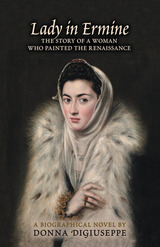 Lady in Ermine: The Story of a Woman Who Painted the Renaissance. A Biographical Novel
Donna DiGiuseppe
Arizona Center for Medieval and Renaissance Studies, 2019
Lady in Ermine: The Story of a Woman Who Painted the Renaissance reveals the discovery of an historic figure who embodies the struggle of women throughout the ages while immersing the reader in the sixteenth century world of the Renaissance figures she paints.
As a girl in Lombardy, Sofonisba Anguissola trains to paint with mannerist masters, and though society frowns upon women having such ambition, Sofonisba’s father unwaveringly encourages her. A royal tour by Prince Philip of Spain inspires her lifelong dream: to perfect the king’s portrait and show his truth on canvas, the highest calling for a Renaissance portraitist. Her drive to vindicate her loving father, a bastard of nobility, propels her. Politics of the Spanish empire brings Sofonisba to the heart of the royal court in Madrid. She aspires to achieve her goal while others at court work to undermine her as a female artist. Tragedy unfolds in the royal household, but in the process, Sofonisba finds her opportunity to paint the King of Spain, honoring her family name with her success. In life after court, Sofonisba navigates two marriages, royal appointments, love, hardship, and bankruptcy, while leaving a legacy of hundreds of paintings and influencing generations of artists from Anthony van Dyck to Peter Paul Rubens. This is her story.
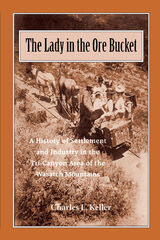 The Lady In The Ore Bucket: A History of Settlement and Industry in the Tri-Canyon Area of the Wasatch Mountains
Charles L Keller
University of Utah Press, 2001 When the first company of Mormon settlers arrived in the Great Salt Lake Valley in July 1847, it was immediately apparent that thier survival depended upon what resources they found in the mountains surrounding them. The Great Basin soil was baked hard by the sun and yielded to the plow with great difficulty. And as pioneer William Clayton noted, surveying the valley floor, "Timber is evidently lacking." But within a week of arrival, a small dam had been constructed to channel irrigation water to crops, parties had been dispatched to explore the nearby canyons for trees suitable for lumber, and names had been attached to several dozen features of the landscape including peaks, creeks, and canyons.
These place names, as well as the physcial traces and artifacts that persist in three Wasatch canyons—Mill Creek, Big Cottonwood, and Little Cottonwood—tantalize with what they suggest, but do not tell, about the history of settlement and development in the canyons. Charles Keller has extracted a wealth of information to create The Lady in the Ore Bucket, a faxcinating history of the lumber, mining, and hydropower industries built from the rich natural resources of the canyons. With more than six dozen photographs and maps, the book is alive with details concerning the personalities, politics, pacts, and peregrinations of local leaders from white settlement in 1847 through the early 1900s. It will delight any reader with an interest in the magnificent canyones that open onto the modern Wasatch Front.
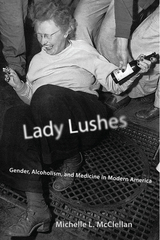 Lady Lushes: Gender, Alcoholism, and Medicine in Modern America
McClellan, Michelle L
Rutgers University Press, 2017 According to the popular press in the mid twentieth century, American women, in a misguided attempt to act like men in work and leisure, were drinking more. “Lady Lushes” were becoming a widespread social phenomenon. From the glamorous hard-drinking flapper of the 1920s to the disgraced and alcoholic wife and mother played by Lee Remick in the 1962 film “Days of Wine and Roses,” alcohol consumption by American women has been seen as both a prerogative and as a threat to health, happiness, and the social order.
In Lady Lushes, medical historian Michelle L. McClellan traces the story of the female alcoholic from the late-nineteenth through the twentieth century. She draws on a range of sources to demonstrate the persistence of the belief that alcohol use is antithetical to an idealized feminine role, particularly one that glorifies motherhood. Lady Lushes offers a fresh perspective on the importance of gender role ideology in the formation of medical knowledge and authority.
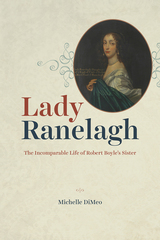 Lady Ranelagh: The Incomparable Life of Robert Boyle's Sister
Michelle DiMeo
University of Chicago Press, 2021 For centuries, historians have speculated about the life of Katherine Jones, Lady Ranelagh. Dominant depictions show her either as a maternal figure to her younger brother Robert Boyle, one of the most significant scientists of his day, or as a patroness of the European correspondence network now known as the Hartlib circle—but neither portrait captures the depth of her intellect or the range of her knowledge and influence.
Philosophers, mathematicians, politicians, and religious authorities sought her opinion on everything from decimalizing the currency to producing Hebrew grammars. She practiced medicine alongside distinguished male physicians, treating some of the most elite patients in London. Her medical recipes, political commentaries, and testimony concerning the philosophers’ stone gained international circulation. She was an important influence on Boyle and a formidable thinker in her own right.
Drawing from a wealth of new archival sources, Michelle DiMeo fills out Lady Ranelagh’s legacy in the context of a historically sensitive and nuanced interpretation of gender, science, and religion. The book re-creates the intellectual life of one of the most respected and influential women in seventeenth-century Europe, revealing how she managed to gain the admiration of diverse contemporaries, effect social change, and shape contemporary science.
The Lady Swings: Memoirs of a Jazz Drummer
Dottie Dodgion and Wayne Enstice
University of Illinois Press, 2021 Dottie Dodgion is a jazz drummer who played with the best. A survivor, she lived an entire lifetime before she was seventeen. Undeterred by hardships she defied the odds and earned a seat as a woman in the exclusive men’s club of jazz. Her dues-paying path as a musician took her from early work with Charles Mingus to being hired by Benny Goodman at Basin Street East on her first day in New York. From there she broke new ground as a woman who played a “man’s instrument” in first-string, all-male New York City jazz bands. Her inspiring memoir talks frankly about her music and the challenges she faced, and shines a light into the jazz world of the 1960s and 1970s.
Vivid and always entertaining, The Lady Swings tells Dottie Dodgion's story with the same verve and straight-ahead honesty that powered her playing.
A Variety Best Music Book of 2021
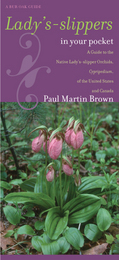 Lady's-slippers in Your Pocket: A Guide to the Native Lady's-slipper Orchids, Cypripedium, of the United States and Canada
Paul Martin Brown
University of Iowa Press, 2008 Native orchids are increasingly threatened by pressure from population growth and development but, nonetheless, still present a welcome surprise to observant hikers in every state and province. Compiled and illustrated by long-time orchid specialist Paul Martin Brown, this pocket guide to lady’s-slippers is the first in a series that will cover all the wild orchids of the United States and Canada.
Brown provides general distributional information, time of flowering, and habitat requirements for each species as well as a complete list of hybrids and the many different growth and color forms that can make identifying orchids so intriguing. For the lady’s-slippers he includes information on 12 species, 2 additional varieties, and 6 hybrids.
Wild lady’s-slippers grow from Alaska, with the spotted lady’s-slipper, Cypripedium guttatum, to Texas, with the ivory-lipped lady’s-slipper, C. kentuckiense. Most of these species are easy to identify based upon their general appearance, range, and time of flowering. Answer three simple questions—when, where, and how does it grow? Then compare the living plant with the striking photos in these backpack-friendly laminated guides and consult the keys that Brown has created. Following these steps should enable both professional and amateur naturalists to achieve the satisfaction of identifying specific orchids in their native environment.
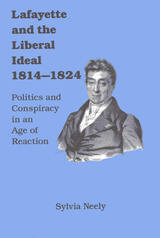 Lafayette and the Liberal Ideal 1814-1824: Politics and Conspiracy in an Age of Reaction
Sylvia Neely
Southern Illinois University Press, 1991
Sylvia Neely provides both the first scholarly study of Lafayette’s life after the French Revolution and a detailed analysis of French politics during the early Restoration.
Lafayette, advocating a liberalism based on the American example, used both legal and illegal means to overturn a conservative government. The personification of liberalism for many of his contemporaries, he and his friends Benjamin Constant, Voyer d’Argenson, and Charles Goyet saw themselves as fighters in an international struggle that set liberalism against the forces of reaction and obscurantism. Although he ultimately failed, Lafayette was convinced that the liberal ideals derived from the Enlightenment and from his personal mentor, George Washington, would prevail.
Neely makes Lafayette’s actions clear by considering seriously the principles that guided his life and by describing the political climate of the early nineteenth century. She discloses previously overlooked features of the revolutions of the 1820s which account for the divisions among the revolutionary groups. She also examines relationships between Lafayette and the prominent writers and thinkers of the period, among them Augustin Thierry, Jeremy Bentham, Lady Morgan, and Frances Wright.
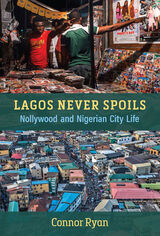 Lagos Never Spoils: Nollywood and Nigerian City Life
Connor Ryan
University of Michigan Press, 2023 The slogan “Lagos shall not spoil,” found in print media, political campaigns, and common conversation, represents a shared expression of the optimism the city embodies. However, on city streets the phrase also appears scrawled in irreverent variations—“Lagos cannot spoil more than this!”—that meet the frustrations of city life with irony. In both cases, the slogan captures the resilience and persistence with which residents of Lagos live on, despite it all. This book examines the circumstances that make it possible for residents to persist in pursuing their various projects and for the city to remain a platform that supports these projects and creates space for even more to emerge. Author Connor Ryan argues that residents continually work to combine contingency and endurance in opportunistic ways that make the city work for them, and as such, Lagos never spoils: it endures.
What makes Lagos remarkable is what residents have made of it, and Nollywood—the industry and the body of films—both embodies and represents this continual urban transformation. Lagos Never Spoils traces how Nollywood arose from the social milieu of Lagos and, in turn, generates a repertoire of stories, images, styles, and sentiments with which audiences come to grips with city life. The book traces the evolution of the screen media industry in Lagos and explores how this corresponds with historical phases in the city’s representation onscreen. It discusses important urban spaces of production and consumption, including historic movie halls, video marketplaces, film sets, and multiplex cinemas. Across six chapters, it attends to celluloid films about oil-boom wealth, television sitcoms about urban tricksters, video melodramas about urban crisis, glossy romantic comedies about young professionals, and dark thrillers on streaming platforms about the pleasure of moral transgression. In this fashion, the book offers new approaches to the interpretation of screen texts produced in and about Lagos, a place that is today the most influential image of West African city life.
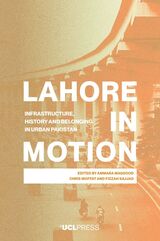 Lahore in Motion: Infrastructure, History and Belonging in Urban Pakistan
Edited by Ammara Maqsood, Chris Moffat, and Fizzah Sajjad
University College London, 2025 Follow Lahore’s Orange Line metro corridor to discover the tensions between progress and displacement, history and modernity, in a city that never sleeps.
Lahore is a city in constant flux, and nowhere is this transformation more visible than along the tracks of its first metro rail corridor. Lahore in Motion follows the Orange Line’s 27-kilometer path, weaving together reflections from academics, activists, artists, and architects on the ways infrastructure reshapes urban belonging. Moving far beyond the train stations themselves, the book critically studies how this mega-project has displaced residents, reconfigured neighborhoods, and sparked new desires for modernity while also deepening existing social differences.
Each chapter unfolds through the lens of a particular metro stop, providing intimate glimpses into the frictions of development—where connectivity and fragmentation, aspiration, and dispossession collide. Engaging with broader debates on urban transformation in the Global South, Lahore in Motion goes against familiar narratives of top-down development, revealing instead a city that resists and reinvents itself in response. An eye-opening, beautifully written work for all interested in urbanism, infrastructure politics, and a glance into the everyday lives of one of the world’s most dynamic cities.
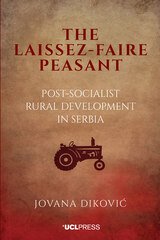 The Laissez-Faire Peasant: Post-Socialist Rural Development in Serbia
Jovana Dikovic
University College London, 2025 What if rural progress isn’t about government intervention but about the self-reliance and ingenuity of peasants themselves?
The Laissez-Faire Peasant: Post-Socialist Rural Development in Serbia subverts conventional wisdom on rural development by shifting the focus from state-led planning to the agency of peasants themselves. Rejecting the notion that rural populations are passive victims of top-down policies, Jovana Dikovic presents a compelling ethnographic study of three Serbian villages, where autonomy and local cooperation drive economic and social resilience. She introduces the concept of the “laissez-faire peasant”—a figure who thrives outside rigid government schemes, shaping rural development on their own terms. By examining the friction between state policies and the everyday strategies of rural communities, Dikovic uncovers how peasant autonomy not only resists external intervention but fosters sustainable and self-sufficient growth.
The first in-depth study of contemporary Serbian peasantry, this book reframes rural life as a site of innovation rather than stagnation. An area of interest for scholars of post-socialist transitions, rural development, and economic anthropology, The Laissez-Faire Peasant provides a new lens on how rural communities survive and adapt in a rapidly changing world.
Laity in the Middle Ages: Religious Beliefs and Devotional Practices
Andre Vauchez
University of Notre Dame Press, 1996 In these lively and incisive essays André Vauchez explores the religious beliefs and devotional practices of laypeople in medieval Europe and grapples with some of the most difficult issues in medieval history: the nature of popular devotion, the role of religion in civic life, the sociology of religious attitudes and practices, and the relationship between the intersecting spheres of lay and clerical culture.
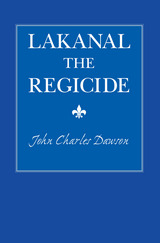 Lakanal the Regicide
John Charles Dawson
University of Alabama Press, 1948 Biography of a free thinker in the time of the French Revolution
After being comparatively neglected for several generations, Joseph Lakanal received many posthumous honors. These memorials of esteem were the tribute of the men of the Third French Republic to an outstanding character of the First Republic, established by the National Convention in 1792.
In numerous towns and cities of France streets and boulevards were named for Lakanal, among them Paris, Tours, Toulouse, and Montpellier. Elementary schools received his name at Perigueux, Cette, Beziers. Secondary schools were named in his honor, such as the Lycee Lakanal at Paris and the College Lakanal at Beziers. At least two monuments were erected to his memory, the more imposing of which was a life-sized statue in bronze at Foix in his native Ariege. The ancient adage that a prophet is not without honor save in his own country was not true of Lakanal.
Lakanal belonged to a group of thinkers at the end of the eighteenth century known as Ideologists, a derogatory term applied to them by First Consul Bonaparte. When, during the period of the Consulate, Bonaparte had signed a Concordat with the Pope whereby Catholicism was restored to France, and when in 1802 he had sought to put into force the terms of the Concordat, he found a stumbling-block to his plans in the membership of the Class of Moral and Political Sciences of the lnstitut de France. In this group were to be found the most influential free-thinkers of the day: Lakanal, Garat, Cabanis, Volney, Ginguene, Mercier, Naigeon, Destutt de Tracy and others who had been consistently hostile to the Church, and who had become hostile to the ambition of Bonaparte.
On the political side, Lakanal was an austere democrat, and remained one all his life. Had he been willing to compromise, he would undoubtedly have gone far under Napoleon. His career is quite in contrast with that of Talleyrand, whose chameleon-like qualities enabled him to occupy high place in the Revolution, the Consulate, the Empire, the Restoration, and the more liberal government of Louis Philippe.
In his profound belief in democracy and public education, and in the wide variety of his knowledge and interest in the various sciences, Lakanal is to be compared with Thomas Jefferson. The two men were of the same school of thought and possessed much in, common. In his passion for public education Lakanal may also be compared to Horace Mann.
Lake Country: A Series of Journeys
Kathleen Stocking
University of Michigan Press, 1994 One writer's quest to locate herself within the wet, wild, and diversely human cultural heritage that has shaped her
 Lake Effect: Along Superior’s Shores
Erika Alin
University of Minnesota Press, 2003 Personal reflections on the natural splendors and human history of the Lake Superior shoreline The 2,900-mile shoreline of Lake Superior offers some of the most beautiful scenery in the world: stunning juxtapositions of shape, color, and texture, from the birch and evergreen forests of Minnesota’s north shore and the maple-clad slopes of Wisconsin to Ontario’s granite outcrops and Michigan's sandstone shelves. Inhabited by hundreds of species of mammals, birds, and insects, the diverse ecosystems around Superior have also experienced human habitation for millennia. In Lake Effect, writer Erika Alin explores both the natural and the human landscapes of Lake Superior, meditating on the rich geological, historical, and cultural events that have shaped the region. She begins her journey around Superior at the St. Louis River near Duluth and continues along the shores of the lake to Temperance River State Park, Grand Marais’s Artist’s Point, and Lake Superior Provincial Park. Following the Michigan and Wisconsin coasts, Alin visits the Keweenaw Peninsula, the Porcupine Mountains, and Chequamegon Bay before concluding at the south shore’s Brule River. Inspired by these and other places on the lake, Alin’s engaging essays delve into such diverse topics as the origins of river names, early Native American settlement, the exploits of seventeenth-century French-Canadian voyageurs, the breeding habits of ring-billed gulls, the contributions of women botanists, Canada’s Group of Seven painters, and aboriginal rock art. A holistic and deeply personal reflection on Superior’s shoreline, Lake Effect reveals a profound sensitivity to the natural world and a penetrating historical imagination.
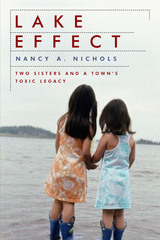 Lake Effect: Two Sisters and a Town's Toxic Legacy
Nancy A. Nichols
Island Press, 2010 On her deathbed, Sue asked her sister for one thing: to write about the connection between the industrial pollution in their hometown and the rare cancer that was killing her. Fulfilling that promise has been Nancy Nichols’ mission for more than a decade.
Lake Effect is the story of her investigation. It reaches back to their childhood in Waukegan, Illinois, an industrial town on Lake Michigan once known for good factory jobs and great fishing. Now Waukegan is famous for its Superfund sites: as one resident put it, asbestos to the north, PCBs to the south.
Drawing on her experience as a journalist, Nichols interviewed dozens of scientists, doctors, and environmentalists to determine if these pollutants could have played a role in her sister’s death. While researching Sue’s cancer, she discovered her own: a vicious though treatable form of pancreatic cancer. Doctors and even family urged her to forget causes and concentrate on cures, but Nichols knew that it was relentless questioning that had led to her diagnosis. And that it is questioning—by government as well as individuals—that could save other lives.
Lake Effect challenges us to ask why. It is the fulfillment of a sister’s promise. And it is a call to stop the pollution that is endangering the health of all our families.
The lake has no saint
Stacey Waite
Tupelo Press, 2010 Stacey Waite’s the lake has no saint is a study in grief — a work of poetic archaeology that traces the artifacts of the past into the relationships of the present.
Embedded in a powerfully modulated sequence addressing a “you” who shifts in location and identity, many of these poems feel like forms of request, imploring. The speaker’s androgynous self-awareness — and wary attention to the gendered assumptions elicited by bodies — disclose in each poem a recognizable but disorienting (and pressurized) situation.
the lake has no saint will unsettle a reader’s sense of the certainty and stability of gender, as grammar and phrasing are also disrupted and blurred, often requiring us to read closely to hear where one sentence ends as another begins. Yet despite its formal and thematic iconoclasm, this is a book that clearly elucidates a story both heart-rending and ultimately — in its vatic honesty — triumphant.
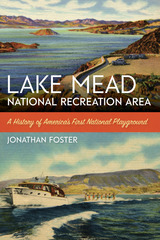 Lake Mead National Recreation Area: A History of America’s First National Playground
Jonathan Foster
University of Nevada Press, 2016 This book examines the creation, characteristics, and tribulations of the first United States National Recreation Area. It also addresses the National Park Service’s historic role in managing reservoir-based recreation in a uniquely arid region.
First named the Boulder Dam Recreation Area, this parkland was created in 1936 by a memorandum of agreement between the National Park Service and the U.S. Bureau of Reclamation. Over the course of its existence, the area has served as a model for a subsequent system of National Recreation Areas. The area’s extreme popularity has, in combination with changing public attitudes regarding preservation and safety, presented the National Park Service with tremendous challenges in recent decades. Jonathan Foster’s examination of these challenges and the responses to them reveal an increasingly anxious relationship between the government, the public, and special interest groups in the American West.
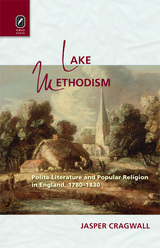 Lake Methodism
Jasper Cragwall
Ohio State University Press, 2013 Lake Methodism: Polite Literature and Popular Religion in England, 1780-1830, reveals the traffic between Romanticism’s rhetorics of privilege and the most socially toxic religious forms of the eighteenth and nineteenth centuries. The “Lake Poets,” of whom William Wordsworth and Samuel Taylor Coleridge are the most famous, are often seen as crafters of a poetics of spontaneous inspiration, transcendent imagination, and visionary prophecy, couched within lexicons of experimental simplicity and lyrical concision. But, as Jasper Cragwall argues, such postures and principles were in fact received as the vulgarities of popular Methodism, an insurgent religious movement whose autobiographies, songs, and sermons reached sales figures of which the Lakers could only dream. With these religious histories, Lake Methodism unsettles canonical Romanticism, reading, for example, the grand declaration opening Wordsworth’s spiritual autobiography—“to the open fields I told a prophecy”—not as poetic self-sanctification, but as a means of embarrassing Methodism, responsible for the suppression of The Prelude for half a century. The book measures this fearful symmetry between Romantic and religious enthusiasms in figures iconic and unfamiliar: John Wesley, Robert Southey, Wordsworth, Coleridge, as well as the eponymous scientist of Mary Shelley’s Frankenstein, and even Joanna Southcott, an illiterate servant turned latter-day Virgin Mary, who, at the age of sixty-five, mistook a fatal dropsy for the Second Coming of Christ (and so captivated a nation).
Lake Michigan
Daniel Borzutzky
University of Pittsburgh Press, 2018 Finalist for the 2019 Griffin Poetry Prize
From the author of The Performance of Becoming Human, winner of the National Book Award for poetry
Lake Michigan, a series of 19 lyric poems, imagines a prison camp located on the beaches of a Chicago that is privatized, racially segregated, and overrun by a brutal police force. Thinking about the ways in which economic policy, racism, and militarized policing combine to shape the city, Lake Michigan's poems continue exploring the themes from Borzutzky's Performance of Becoming Human, winner of the National Book Award for Poetry. But while the influences in this book (Césaire, Vallejo, Neruda) are international, the focus here is local as the book takes a hard look at neoliberal urbanism in the historic city of Chicago. Named a 2018 Best Book of the Year by the New York Public Library.
Lake Michigan in Motion: Responses of an Inland Sea to Weather, Earth-Spin, and Human Activities
Clifford H. Mortimer
University of Wisconsin Press, 2004 Written in a clear, readable style by an acknowledged expert in limnology and biology, Lake Michigan in Motion is certain to become a classic reference book on the subject of the Great Lakes. Its blend of history, science, and public policy will give it broad appeal to limnologists, graduate students, researchers, public officials, elementary and high school teachers, those who live near the Lake, and those who use it for their livelihood and recreation.
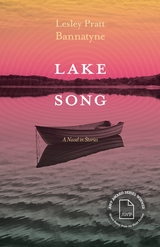 Lake Song: A Novel in Stories
Lesley Pratt Bannatyne
Ohio State University Press, 2025 Selected by Deesha Philyaw as winner of the AWP Grace Paley Prize in Short Fiction
The linked stories of Lake Song, set in the fictional town of Kinder Falls in New York’s Finger Lakes region, span decades to plumb the complexities, violence, and compassion of small-town life as the twentieth century hurtles forward. Against a backdrop of historical events—bootlegging, Klan attacks, gold smuggling, the Albany Ketchup Murders, the 1965 Northeast blackout—a generations-long mystery unwinds. In 1906 Mavis Staunch drowns in Okisee Lake days after she refuses to sell her land to a trio of brothers. The same night, one of the brothers, Angus Epps, doesn’t come home. Few suspect the two events are connected, and no one imagines the role that a ten-year-old boy, a canoe, and a pack of coyotes play in the tragedies. Spiritualists, grifters, sugar makers, arsonists, seekers, and saleswomen wind through each other’s lives and across decades to add layers of resonance to each captivating story. The mercurial lake that unites the people of Kinder Falls sustains as much as it haunts, both witness and diary.
Lake Superior
Grace Lee Nute
University of Minnesota Press, 2000 The captivating history of the world’s largest freshwater lake. This classic history of Lake Superior, from the earliest explorations to the explosion of industry on its shores, takes the reader on a tour from Duluth to Isle Royale, from Thunder Bay to Sault Ste. Marie, from Pictured Rocks to the Apostle Islands. Grace Lee Nute tells the fascinating stories of the Native Americans, voyageurs, missionaries, and others who created the way of life that many generations have known on the edge of this magnificent body of water.
Lake Superior Copper and the Indians: Miscellaneous Studies of Great Lakes Prehistory
Edited by James B. Griffin
University of Michigan Press, 1951 In this classic work, editor James B. Griffin presents research on the prehistoric inhabitants of the Lake Superior region. Griffin and Roy W. Drier report on Isle Royale excavations and archaeological finds; Griffin and George I. Quimby write about prehistoric copper pits and related artifacts in Ontario and Manitoba; William C. Root reports on copper artifacts from southern Michigan; and Tyler Bastian writes a review of metallographic studies of prehistoric copper artifacts in North America.
 Lake Views: This World and the Universe
Steven Weinberg
Harvard University Press, 2009 Just as Henry David Thoreau “traveled a great deal in Concord,” Nobel Prize–winning physicist Steven Weinberg sees much of the world from the window of his study overlooking Lake Austin. In Lake Views Weinberg, considered by many to be the preeminent theoretical physicist alive today, continues the wide-ranging reflections that have also earned him a reputation as, in the words of New York Times reporter James Glanz, “a powerful writer of prose that can illuminate—and sting.”
This collection presents Weinberg’s views on topics ranging from problems of cosmology to assorted world issues—military, political, and religious. Even as he moves beyond the bounds of science, each essay reflects his experience as a theoretical physicist. And as in the celebrated Facing Up, the essays express a viewpoint that is rationalist, reductionist, realist, and secular. A new introduction precedes each essay, explaining how it came to be written and bringing it up to date where necessary.
As an essayist, Weinberg insists on seeing things as they are, without despair and with good humor. Sure to provoke his readers—postmodern cultural critics, enthusiasts for manned space flight or missile defense, economic conservatives, sociologists of science, anti-Zionists, and religious zealots—this book nonetheless offers the pleasure of a sustained encounter with one of the most interesting scientific minds of our time.
 Lake|Flato Houses: Embracing the Landscape
Lake|Flato Architects
University of Texas Press, 2014 Lake|Flato Architects of San Antonio, Texas, is nationally and internationally acclaimed for buildings that respond organically to the natural environment. The firm uses local materials and workmanship, as well as a deep knowledge of vernacular traditions, to design buildings that are tactile and modern, environmentally responsible and authentic, artful and crafted. Lake|Flato won the Global Award for Sustainable Architecture in 2013, and it has also received the American Institute of Architects’ highest honor, the National Firm Award. In all, Lake|Flato has won more than 150 national and state design awards. Residential architecture has always been a priority for the firm, and Lake|Flato Houses showcases an extensive selection of landmark homes built since 1999. Color photographs and architectural commentary create a memorable portrait of houses from Texas to Montana. Reflecting the firm’s emphasis on designing in harmony with the land, the houses are grouped by the habitats in which they’re rooted—brushland, desert, hillside, mountains, city, and water. These groupings reveal how Lake|Flato works with the natural environment to create houses that merge into the landscape, blurring boundaries between inside and outside and accommodating the climate through both traditional and cutting-edge technologies. The sections are opened by noted architect and educator Frederick Steiner, who discusses Lake|Flato’s unique responses to the forms and materials of the various landscapes. An introduction by journalist Guy Martin summarizes the history of Lake|Flato and its philosophy, and explores the impact of its work on sustainable architecture.
|
|

